Recorder

I lift up my eyes to the hills. From whence does my help come? My help comes from the Lord, who made heaven and earth (Psalm 121:1-2, RSV).



I lift up my eyes to the hills. From whence does my help come? My help comes from the Lord, who made heaven and earth (Psalm 121:1-2, RSV).

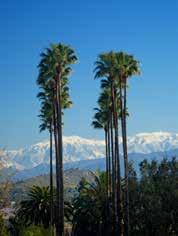
Love cannot live without action, and every act increases, strengthens, and extends it. Love will gain the victory when argument and authority are powerless. Love works not for profit nor reward; yet God has ordained that great gain shall be the certain result of every labor of love. It is diffusive in its nature and quiet in its operation, yet strong and mighty in its purpose to overcome great evils. It is melting and transforming in its influence.… Pure love is simple in its operations, and is distinct from any other principle of action.
—Ellen White, Testimonies for the Church, vol. 2, pp. 135-136
4 Finding Your Path 9 Some Historical Highlights 13 A Vital Communication Hub
James and Ellen White 23 P. G. Rodgers 29 William Ward Simpson 23 Arizona: The Early Years
37 Touching Hearts in Hawaii for Jesus 30 Beginnings: Central California
45 Beginnings: Nevada
49 Beginnings: Northern California
53 Beginnings: Utah
57 Beginnings: Southeastern California
63 Beginnings: Southern California
69 Asian-Pacific Work
73 Black Ministries
77 Beginnings: Pacific Press
81 Inventing a New Church Structure
85 John Burden
89 H.M.S. Richards
93 Braulio Pérez Marcio
97 Beginnings: Media Ministries
101 Diversity in Mission
107 Holbrook Indian School
113 La Sierra University
119 Pacific Union College 125 Elmshaven
128 Path of Hope & Healing
131 An Amazing Beginning 136 Investing in Educators
140 A Training Center for Worldwide Outreach
Publisher Ray Tetz
Editor Alberto Valenzuela
Assistant Editor Connie Jeffery
Design/Layout
Stephanie Leal • Alberto Valenzuela
Printing
Pacific Press Publishing Association www.pacificpress.com
144 Rescuing Samuel Rhodes
This special issue of the Pacific Union Recorder is a historical overview of the work of the Seventh-day Adventist Church in the Pacific Southwest. At the heart of this project is the vision and dedication of my colleague, Alberto Valenzuela, editor of the Recorder. Although he is inclined to give credit to the Recorder editorial staff, this issue reflects his tireless effort and personal commitment to telling our story well. The dedication of the entire editorial team—their pursuit of winsome and accurate content, presented with care and clarity in both word and design—has produced a resource that will serve our church family well for years to come.
—Ray Tetz, publisher


By Bradford C. Newton
Remember using a map? In these days of Apple Maps, Google Maps, and MapQuest, consulting a paper map is a bygone practice. Yet, it doesn’t seem that long ago that when a road trip was at hand, the Road Atlas would be opened at the kitchen table, and we’d use a highlighter and pencil to plan our route. Back then, the process of finding your way was prone to unexpected road closures, traffic jams in strange cities, and the fervent hope that you didn’t miss the crucial next turn.
Finding our path along the road of life is obviously more complicated, with many more challenges in comparison to a car trip. Marriage, job responsibilities, moving to a new city, caring for children or aging parents, relationship with God and church, healthcare issues, and times of profound loss are just some of the matters about which we search for guidance and direction.
“How can I know God’s will for my life?” is a question we each confront no matter our age, profession, personal circumstances, or economic status. How thankful I am for wise parents, good friends, committed teachers, experienced colleagues, and most of all my wonderful wife, who have helped me in seeking life pathways that honor God and bless me.
How did it happen that these precious people were in my life at just the right time? It was not happenstance or by accident. When I was a teenager, I recall my pastor sharing Psalm 37:4-5

with me, “Delight yourself also in the Lord, and He shall give you the desires of your heart. Commit your way to the Lord, trust also in Him, and He shall bring it to pass.”1 It remains a go-to passage for me to this day.
Every believer can experience God’s leading along the pathway of life. He longs that each of His children experience direction, purpose, meaning, and even joy when facing their biggest problems or decisions. For generations of Christfollowers, finding the pathway of life has meant employing essential spiritual principles to discover God’s will.
Principle 1: Anchor every decision in the Word of God. Psalm 119:105 says, “Your word is a lamp to my feet and a light to my path.” There is no better place to start than the Bible for building the solid foundation for our decisions. Psalm 119:11 declares, “Your word I have hidden in my heart, that I might not sin against You.” Even when we can’t see everything ahead, we do know One who has been there before. When we root ourselves in Bible truths, we are on safe ground. Psalm 119:165 says, “Great peace have those who love Your law, and nothing causes them to stumble.”
Principle 2: Seek God daily in prayer. Finding God’s leading for life comes in the context of our daily conversations with Him. “Prayer is the opening of the heart to God as to a friend” (Ellen G. White, Steps to Christ, p. 93). When we share

both our joys and disappointments with Him, a growing trust and spiritual intimacy grows. Philippians 4:6-7 advises, “Be anxious for nothing, but in everything by prayer and supplication, with thanksgiving, let your requests be made known to God; and the peace of God, which surpasses all understanding, will guard your hearts and minds through Christ Jesus.” We can trust Him as we grapple with important life decisions. Proverbs 3:5-6 promises, “Trust in the Lord with all your heart, and lean not on your own understanding; in all your ways acknowledge Him, and He shall direct your paths.”
Principle 3: Seek wise counselors. Proverbs give timeless advice about where to seek counsel. Proverbs 12:26 says “The godly give good advice to their friends; the wicked lead them astray” (NLT). These sources are biblical in content and prayerful in practice. God gives this directive, “Where there is no counsel, the people fall; but in a multitude of counselors there is safety” (Proverbs 11:14).
Principle 4: Watch for divine direction through circumstances. When you are reading the Bible, praying over a decision, and listening to godly counselors, there may also be ways that God is speaking through circumstances that are forming around you. Romans 8:28, 31 reminds us, “And we
know that all things work together for good to those who love God, to those who are the called according to His purpose…. If God is for us, who can be against us?” When we have placed our trust in our Heavenly Father, we can be assured that we are not forsaken and that He will guide us to the best path.
Principle 5: Does this decision glorify God? As choices present themselves, the first consideration is how this impacts my commitment as a follower of Jesus. “Therefore, whether you eat or drink, or whatever you do, do all to the glory of God” (1 Corinthians 10:31). Will the path before you take you closer to the Lord or draw you away from Him?
However, sometimes we make poor decisions. Or we do our best and things still don’t work out as we hoped. What then? We live in a sinful world, and we ourselves are part of this system. There is forgiveness when we fail. When things go badly, we are not alone. God assures us, “Be strong and of good courage.… And the Lord, He is the One who goes before you. He will be with you; He will not leave you nor forsake you; do not fear nor be dismayed” (Deuteronomy 31:7-8).
As we travel the path of this life, we do so with our Greatest Friend on the journey. His promise remains that in the end a wonderful future awaits each of us. “I will come again and receive you to Myself; that where I am, there you may be also” (John 14:3).
Bradford C. Newton is the president of the Pacific Union Conference.
1Unless otherwise indicated, all Scripture quotations are from the New King James Version.
Every believer can experience God’s leading along the pathway of life. He longs that each of His children experience direction, purpose, meaning, and even joy when facing their biggest problems or decisions.


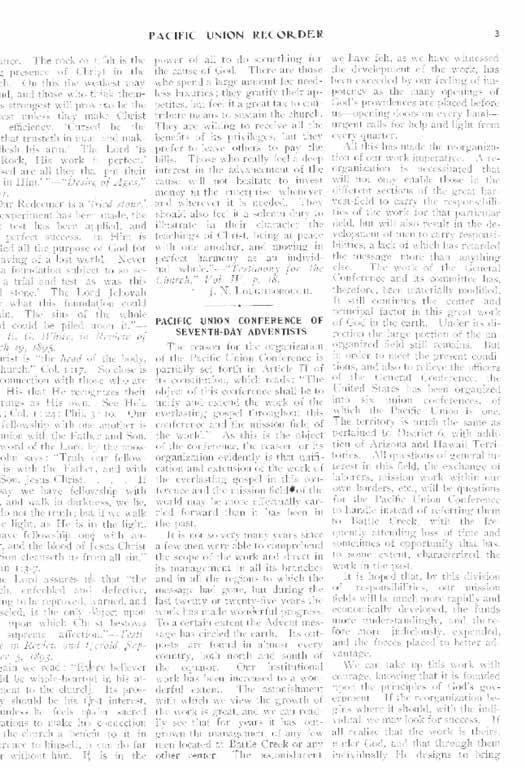

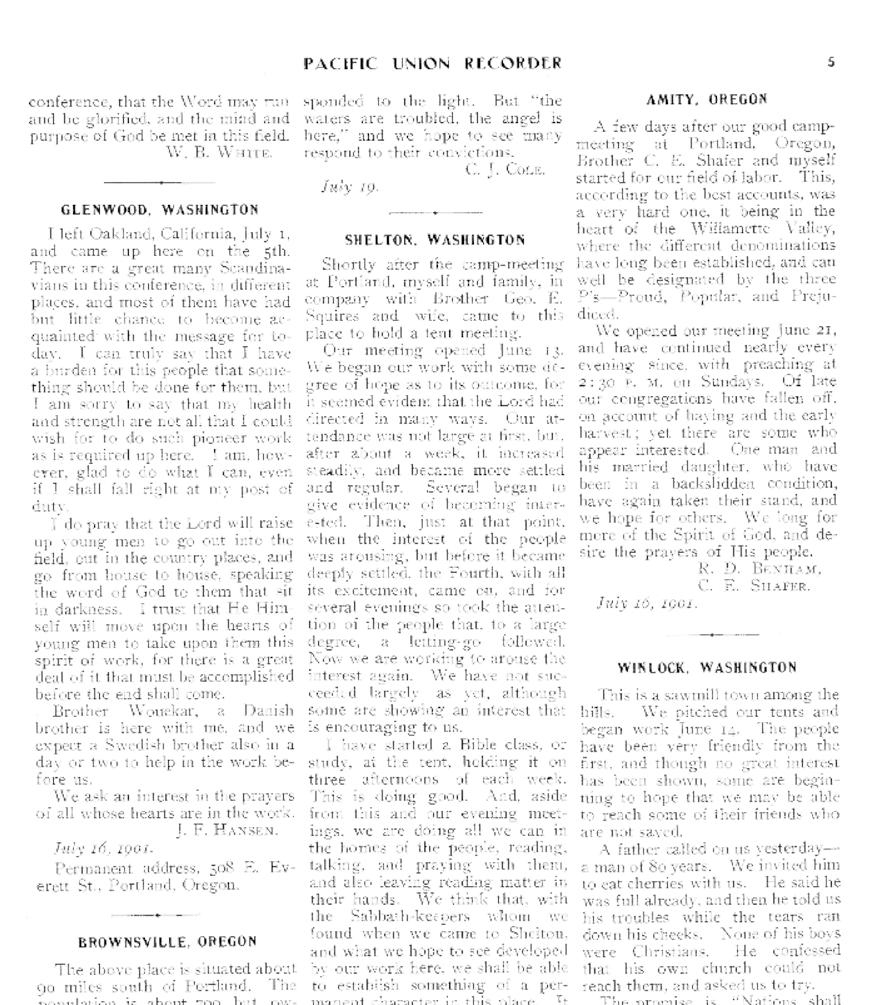


The Pacific Union Recorder first saw the light of day on August 1, 1901. In the many years since then, it has reported on a myriad of church activities, faithful members, and significant events, often of global significance. This short article attempts to capture some of the history and flavor of what has become essential reading for many in the Pacific Union and beyond.
That first issue saw two major articles by Ellen White (“True Missionary Work”) and John Loughborough (“The Church”), followed by an explanation of the formation of the new Pacific Union Conference by its first president, W.T. Knox. He told readers that the development of church work required the establishment of new organizations. “In order to meet the present conditions, and also to relieve the officers of the General Conference, the United States has been organized into six union conferences, of which the Pacific Union is one.” He added, “All questions of general interest in this field, the exchange of laborers, mission work within our own borders, etc., will be questions for the Pacific Union Conference to handle instead of referring them to Battle Creek.”1 This meant the development of a new constitution for the Pacific Union, which interestingly did not even contain any reference to the General Conference!
The editors of the new Recorder explained that “when the organization of the Pacific Union Conference was completed, it was thought it would be a help to the union, as well as to the state,
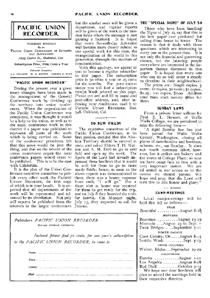
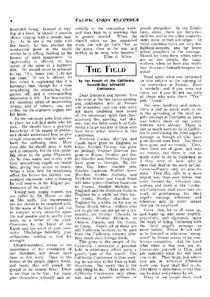
conference work in this district if a paper was published to represent all parts of the work which is being carried on.”2 Consequently, the Recorder replaced the various local conference papers that had been operating up to that time. It was to be produced every two weeks, and the cost was 50 cents a year.
In that first issue, one major development was announced—that of the first Adventist missionaries being sent to Alaska. This was to be a continuing theme for the Recorder—reporting on advances in new areas, and not only in the local region but far overseas. The Recorder for Nov. 20, 1902, carried

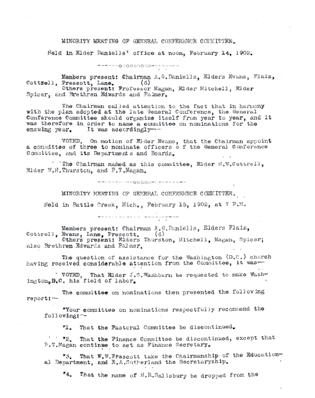
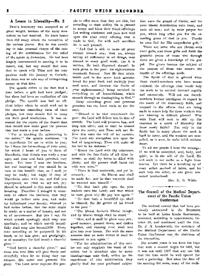
a report by Alonzo Jones, then president of the California Conference, that missionaries from that conference were being sent to England, Ireland, Italy, Georgia, France, Spain, South Africa, Germany, Canada, and China. He commented, “Nearly all of these are still California workers, to be paid from the California treasury after they reach their foreign fields.”3 Reporting to the General Conference, Jones stated, “The amount of tithe now going to foreign fields from the California Conference is practically half the amount raised in the Conference.”4 This local initiative for mission work reported by the Recorder demonstrated tremendous commitment by

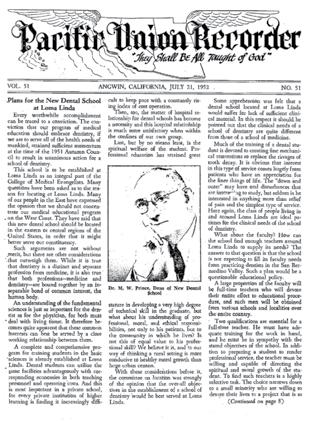



the members in the union who knew these workers and kept in regular contact.
After the purchase of Loma Linda in 1906, the Recorder carried a long report of recommendations for the running of the new College of Medical Evangelists, even down to including details of the proposed syllabus!5 Such reporting regarding this flagship institution has continued over the years. For example, in 1910 there was a long article detailing the plans for Loma Linda voted by the fifth session of the Pacific Union Conference.6 In 1937, the Recorder reported the building of the chapel and the library at Loma Linda.7 Plans for a


new Dental School were detailed in the Recorder in 1952.8 The College of Medical Evangelists became Loma Linda University in 1961, and the Recorder published the official announcement.9 In January 2011, the Recorder published details of the Proton Treatment Center’s 20th anniversary.10 A global search of the Recorder’s archives reveals 3,210 references to Loma Linda.
Similarly Pacific Union College was frequently featured in the Recorder. For example, B.M. Shull ended his article on the college by asking: “Why should we not as one man take hold and push our educational work, and make Angwin a great college, the Harvard of Seventh-day Adventists?”11
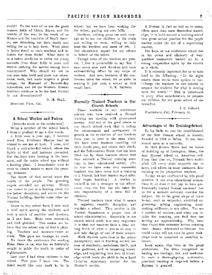
But the Recorder did not carry only church-related news. It also reacted to significant world events such as World War I. In August 1914, the president of the Pacific Union, E.E. Andross, addressed the membership with an article entitled “The Great Crisis Upon Us,” while in the same issue writer Ernest Lloyd contributed a piece called “All Europe Plunges into War.”12
The Great Depression also called for comment, such as, “Then came the great depression and property values and earnings tumbled till many lost
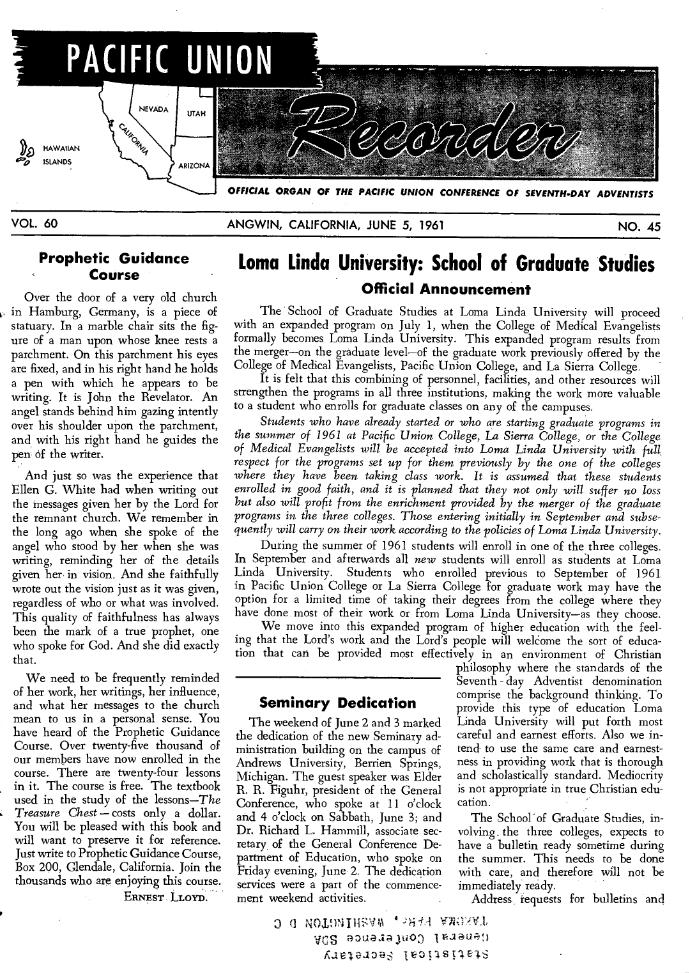



not only all their gains, but their former holdings as well. Then many lamented that they had not been more liberal, and that they had not sold and placed their money in the cause.” 13 At the heart of the depression, the church produced a brochure promoted by the Recorder entitled “Welfare Work by Seventh-day Adventists” giving practical recommendations for helping the needy. 14
The Recorder also noted many of the welfare contributions of the church’s Dorcas Societies during this time.
Anticipating the beginning of World War II, the Recorder published a warning from the Pacific Union committee three days before war was declared. 15 The Recorder also published requests that came into the Voice of Prophecy asking for materials related to the war. 16
The Recorder has seen many changes in format and presentation. It began as a 16page broadsheet in Times Roman font with no illustrations. Over the years this has changed, until today it is presented as a monthly full-color magazine of some 60 to 80 pages. But its primary
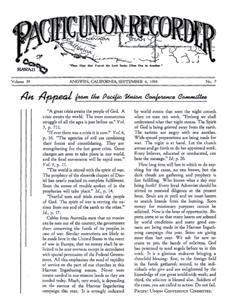

purpose has not changed since 1901: “a paper… published to represent all parts of the work which is being carried on.”
1W.T. Knox, “Pacific Union Conference of Seventh-day Adventists,” Pacific Union Recorder (Aug. 1, 1901), pp. 3-4.
2“Pacific Union Recorder,” Pacific Union Recorder (Aug. 1, 1901), p. 16.
3A.T. Jones, “To the People of the California Seventh-Day Adventist Conference,” Pacific Union Recorder (Nov. 20, 1902), p. 2.
4“Minority Meeting of General Conference Committee,” p. 121, https:// documents.adventistarchives.org/Minutes/GCC/GCC1902.pdf.
5“The Council of the Medical Department of the Pacific Union Conference,” Pacific Union Recorder (Nov. 14, 1907), pp. 2-4.
6“College of Medical Evangelists,” Pacific Union Recorder (Feb. 3, 1910), pp. 1-7.
7“Our Institutions,” Pacific Union Recorder (Feb. 10, 1937), p. 3.
8M. Webster Prince, “Plans for the New Dental School at Loma Linda,” Pacific Union Recorder (July 21, 1952), pp. 1, 8.
9“Loma Linda University: School of Graduate Studies,” Pacific Union Recorder (June 5, 1961), p. 1.
10James Ponder, “Festivities Mark 20th Anniversary of Proton Treatment Center,” Pacific Union Recorder (Jan. 2011), p. 24.
11B.M. Shull, “A Patron’s View-point,” Pacific Union Recorder (Feb. 17, 1910), p. 7.
12Ernest Lloyd, “All Europe Plunges into War,” Pacific Union Recorder (Aug. 6, 1914), pp. 1-2.
13G.A. Roberts, “At the Island of Speculation,” Pacific Union Recorder (Nov. 20, 1924), p. 2.
14“Welfare Work,” Pacific Union Recorder (July 21, 1932), p. 2.
15“An Appeal from the Pacific Union Conference Committee,” Pacific Union Recorder (Sept. 6, 1939), p. 1.
16“Voice of Prophecy,” Pacific Union Recorder (Sept. 27, 1939), p. 3.

By Alberto Valenzuela
The Pacific Union Recorder stands as a cornerstone in the landscape of Adventist media, serving the vibrant and diverse community within the Pacific Union Conference of Seventh-day Adventists. Covering the states of California, Arizona, Nevada, Utah, and Hawaii, the Recorder has been a trusted source of news, inspiration, and connection for Adventist members and institutions for over a century.
Founded in 1901, the Recorder has evolved alongside the Adventist Church, adapting to the changing times while staying true to its mission of fostering spiritual growth and community cohesion. Initially a simple newsletter, it has grown into a sophisticated publication with a wide readership. The Recorder’s dedication to quality journalism and its commitment
Founded in 1901, the Recorder has evolved alongside the Adventist Church, adapting to the changing times while staying true to its mission of fostering spiritual growth and community cohesion.



El símbolo de la mayordomía

Un recorrido hacia la excelencia
The Recorder en español is the only publication of its kind in the North American Division, although other union papers may include a few pages in Spanish.
to addressing the spiritual and practical needs of its readers have cemented its role as an indispensable resource within the Adventist community.
At its core, the Recorder is dedicated to spiritual nourishment. Each issue features a variety of articles aimed at deepening the faith and understanding of its readers. These include Bible studies, devotionals, and theological reflections authored by respected church leaders and scholars. The publication also highlights testimonies and personal stories of faith, offering readers tangible examples of God’s work in the lives of fellow Adventists.
Helping members stay informed about the latest developments within the church and the broader Adventist community is a key function of the Recorder. The publication covers a broad spectrum of news, from local church and conference activities to international events and initiatives. By providing timely and accurate reporting, the Recorder helps its readers stay connected with the wider church

community and informed about important issues and trends.
The Pacific Union Conference is home to numerous educational institutions and healthcare facilities, and the Recorder regularly features news and updates from these sectors. Articles on educational achievements, new programs, and health initiatives underscore the Adventist commitment to wholistic development—spiritually, mentally, and physically. These sections not only inform but also inspire readers to engage with and support Adventist education and healthcare ministries.
Recognizing the diversity within the Pacific Union Conference, the Recorder celebrates the unique cultural contributions of its members. Stories and features on cultural events, heritage celebrations, and community outreach programs highlight the rich tapestry of the Adventist community in the Pacific Union. This inclusivity fosters a sense of belonging and unity among





readers from different backgrounds and regions.
In recent years, the Recorder has embraced digital transformation to meet the evolving needs of its audience. While the print edition remains popular, the Recorder’s online presence has expanded significantly. The digital version offers enhanced accessibility, allowing readers to engage with content on various devices and platforms. Interactive features, multimedia content, and social media integration have further enriched the reader experience, making the Recorder more dynamic and engaging than ever before.
In consideration of the large Spanish-speaking membership of the Pacific Union, beginning in 2018, the Recorder began to be published quarterly in Spanish and was drop-shipped directly to the Spanish churches of the seven conferences in the union’s territory. From its first publication, this quarterly Recorder en español has aimed to cover stories and articles of particular interest to its Spanish-speaking readers.
While the English-language Recorder has appeared online for some time, January of 2023 saw the online appearance of the Recorder en español on a monthly basis. The monthly online version of the

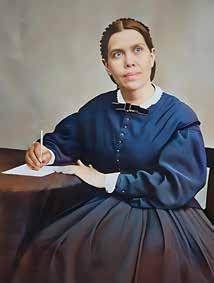
Recorder en español includes every article and news story that appears in the English-language Recorder. The Recorder en español is the only publication of its kind in the North American Division, although other union papers may include a few pages in Spanish.
Beginning in 2023, every article and news story that appears in the Recorder automatically appears on the websites of Pacific Union churches that take advantage of the web services of Adventist Church Connect. Three new stories—in English and in Spanish—from the Recorder appear every day, Monday through Friday. The stories are placed automatically on the websites of the local churches, bringing them readily to most of the churches throughout our territory.
The influence of the Recorder extends beyond its role as a news source. It acts as a unifying force, bringing together a geographically dispersed and culturally diverse community. By sharing stories of faith, reports on church activities, and articles on relevant issues, the Recorder fosters a sense of shared identity and purpose among its readers. An example of this has been the production of the April education issue of the Recorder, which has appeared since 2018. This issue has served to

promote Adventist education as well as to inspire support for the church’s educational entities. Articles about former and current students, teachers, and personnel, as well as photos of students from the many diverse schools—from a two-room elementary school to a college or university—have been the standard of every special education issue.
Furthermore, the Recorder’s commitment to highquality journalism and ethical reporting strengthens the credibility of the Adventist Church within and beyond its own community. It serves as a model for other church publications, demonstrating the power of thoughtful, well-crafted communication in advancing the mission of the church.
The Pacific Union Recorder is more than just a publication; it is a vital lifeline that connects, informs, and inspires the Adventist community in the Pacific
Covering the states of California, Arizona, Nevada, Utah, and Hawaii, the Recorder has been a trusted source of news, inspiration, and connection for Adventist members and institutions for over a century.
Union Conference. As it continues to adapt and grow, the Recorder remains steadfast in its mission to support the spiritual, educational, and communal needs of its readers. For Adventists in California, Arizona, Nevada, Utah, and Hawaii, the Recorder is an indispensable resource that enriches their faith journey and strengthens their connection to the broader Adventist family.
Alberto Valenzuela is associate director of communication and community engagement of the Pacific Union Conference and the Recorder editor.
How and when did racial discrimination become embedded in Adventist institutions? Is it possible to change patterns of injustice when they become deeply ingrained in the corporate life of the church? Is it appropriate to organize in opposition to the voted policies of duly elected church leaders? May Christians use protest and pressure to bring about change in the church? Were Black conferences a step forward or backward?
In Change Agents, Douglas Morgan sheds light on such questions by telling the story of a movement of Black Adventist lay members who, with women at the forefront, brought the denomination to a racial reckoning in the 1940s. Their story, told in the context of the church’s racial history in America as it unfolded during the first half of the 20th century, illumines the often difficult but necessary conversations about race that challenge the church today. And it offers inspiration and insight to Adventists today whose love for their church drives a dedication to changing it.



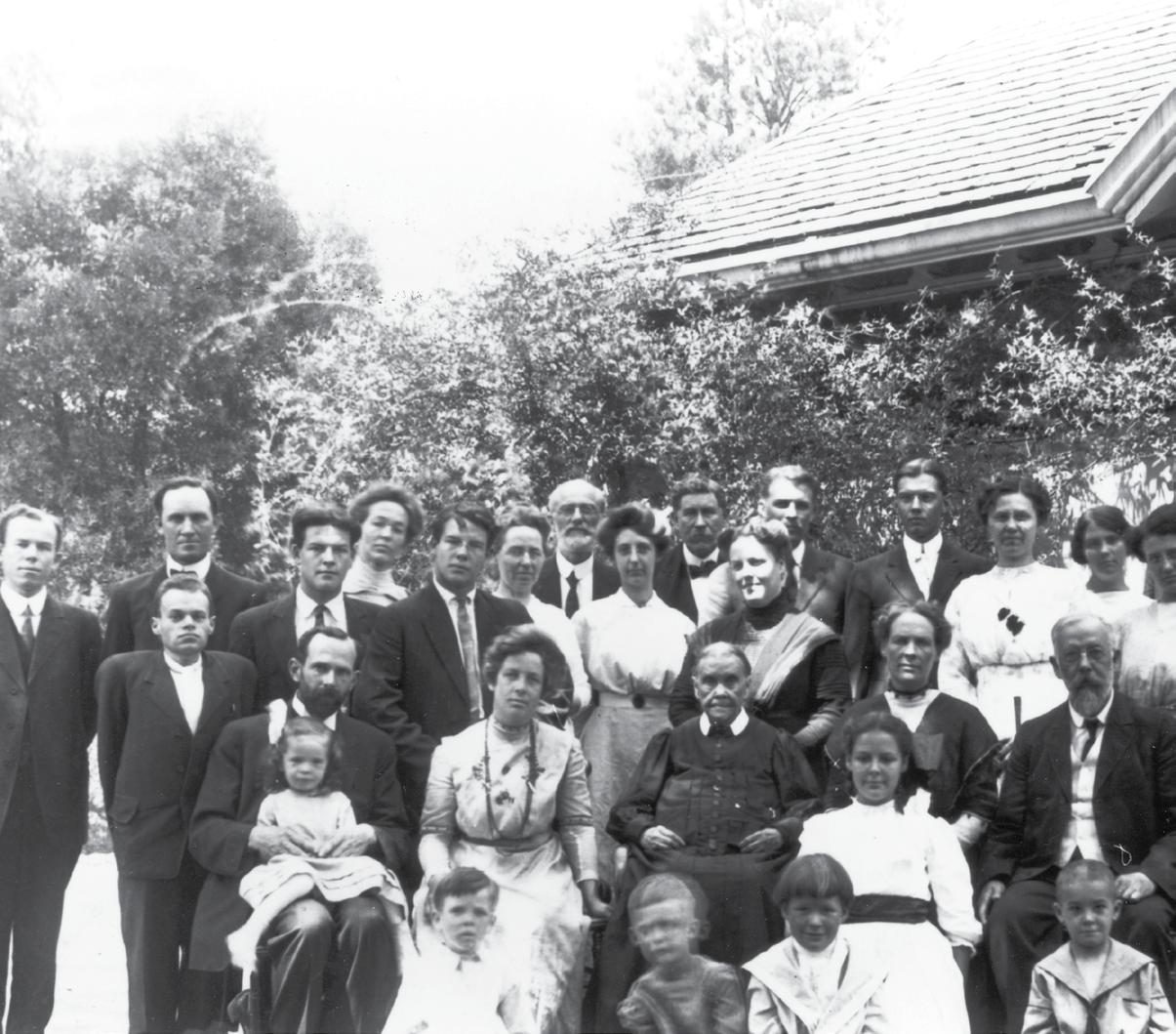




Ellen White’s role in the West began before she ever visited! In 1868, before evangelists J.N. Loughborough and D.T. Bourdeau had even boarded their ship for San Francisco, Ellen White had a vision in Battle Creek as to how to work in California. In a letter that was received by Loughborough and Bourdeau soon after they arrived, she explained that methods used in the East would not be appropriate in the West. She urged a spirit of liberality, of being open and generous, telling them not to be penny-pinching.
Following this advice, they were successful, both in terms of converts and also in the sale of literature, with James White once commenting, “You are selling more books there than all our tent companies east of the Rockies.”1
In an example of “California liberality,” the new church at Santa Rosa, California, sent $2,000 to Battle Creek for a mutual obligation fund, along with an invitation for James and Ellen White to spend the winter of 1872-73 in California.

The Whites accepted the invitation and traveled to Oakland, California, arriving in September 1872. Then they moved on to meet with J.N. Loughborough in Santa Rosa. Ellen wrote, “We think we shall enjoy our visit to California.”2
James wrote, “We like the people of California, and the country, and think it will be favorable to our
health.... We now have strong hope of recovering health, strength, and courage in the Lord, such as enjoyed two years since.”
3
After speaking at camp meetings and other events, and helping with the organization of the California Conference, they headed back to Battle Creek. However, the Whites liked California so much that they were back again in December of the following year. This time, however, they wanted something more permanent, and they sent helpers ahead to set up a home for them in Santa Rosa. They bought a team of horses and a carriage. They got busy with their writing. Ellen wrote, “I do not think we will attend the eastern camp meetings this coming season. It is of no use to make child’s play of coming to California and running back again.”
4

James and Ellen were convinced to make Oakland the center for the work in California. The forerunner of the Pacific Press was set up there in 1874, and The Signs of the Times began publishing. In fact, the Whites sold everything they had in the East to make this investment possible. Ellen wrote, “We went over the same ground in California, selling all our goods to start a printing press on the Pacific Coast. We knew that every foot of ground over which we traveled to establish the work would be at great sacrifice to our own financial interests.”5

Whites to a new home, Fountain Farm. However due to the demands from the East, Ellen decided to go back. James’ health prevented him from accompanying her, though he joined her later. But they returned to their home in California for the winter, though they arrived late, on February 2. James wrote, “We have felt, and still feel, the deepest interest for the cause on the Pacific.… Failing health and discouragements had led us to withdraw from the general cause to confine our labors to the Pacific Coast.”6

They clearly felt torn about responsibilities “back East,” and they both did what they could, including participating in the Michigan camp meeting. But their hearts and home were in California.
It’s almost as if the work needed to be reinvented in the West—with publishing being the first institution started. This meant another move for the
This pattern was repeated frequently in the following years—camp meetings back East, and then supporting the growing work in California during the winter months. Tragedy struck in August 1881 with the death of James in Battle Creek. Soon afterward, Ellen left for Colorado and then for Oakland to participate in the camp meeting there. At first she stayed in Oakland, but in 1882
she bought a new home in Healdsburg. In 1885 she moved to Europe for two years. In 1891 she sold her Healdsburg home after accepting the brethren’s request that she go to Australia, though she commented that she saw “no light” in this.
There was no question in her mind that California would be her home when she returned from Australia in August 1900. She purchased her last home, Elmshaven, in St Helena, where she would live for 15 years. She wrote: “It is just the place I need…. This place was none of my seeking. It has come to me without a thought or purpose of mine. The Lord is so kind and gracious to me. I can trust my interests with Him who is too wise to err and too good to do me harm.”7
Ellen was coming home to the West. It seems that this was the place she wanted to be. Of course there were issues of climate and her health. Yes, there were the benefits of good fruit and vegetables, as she makes clear. But most of all it seems her heart was here, even though she had the whole work on her mind. In fact, she had to face many of the issues of the East directly. She had to write strong letters to the brethren, opposing their mindset. She cautioned
them against interfering in the West. She told them “hands off” the Pacific Press. She complained about the rise of “kingly power” in Battle Creek. She warned about the policies being adopted by the institutions there—the Sanitarium and the Review and Herald press. It must have been heartbreaking for her to hear that the Sanitarium was lost to the church and then that both institutions were destroyed by fire in 1902.
Perhaps in reaction to this, she urgently supported the purchase of Loma Linda in 1905 and fought for the independence of the Pacific Press. She was much involved in the purchase of Pacific Union College in 1909. She saw the church making great progress in the West, and she gave her wholehearted support.
1J.N. Loughborough, Miracles in My Life (Payson, AZ: Leaves-of-Autumn Books, 1987 reprint), p. 72.
2Arthur L. White, Ellen G. White: The Progressive Years: 1862-1876, vol. 2 (Washington, DC: Review and Herald Pub. Assn., 1981), p. 357.
3Arthur White, The Progressive Years, p. 359.
4Arthur White, The Progressive Years, p. 404; Ellen G. White, letter to W.C. White, Feb. 10, 1874.
5Ellen G. White, The Publishing Ministry (Hagerstown, MD: Review and Herald Pub. Assn., 1983), p. 28.
6Arthur White, The Progressive Years, p. 448.
7Ellen G. White, Manuscript Releases, vol. 21, p. 127.


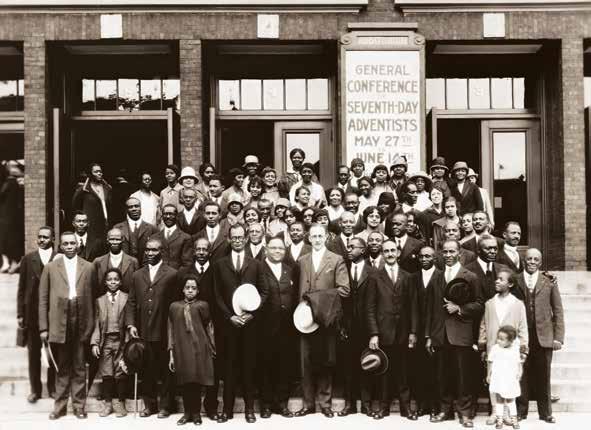
Rodgers in front row with Black delegates and guests at the 1926 General Conference Session, Milwaukee, Wisconsin.
Dr. H. Claude Hudson, president of the Los Angeles chapter of the NAACP, and Charlotta A. Bass, publisher of the California Eagle, Southern California’s leading Black newspaper, were among the guest speakers at Wadsworth Seventh-day Adventist Church in Los Angeles on Jan. 7, 1931. They were there both to celebrate the 25th wedding anniversary of the church’s pastor, P.G. Rodgers, and his wife, Alverta Durham Rodgers, and “to congratulate the church on the rapid strides it has made under the leadership of Elder Rodgers.”1
The presence of these community leaders, reported on the front page of the Eagle, is one marker of the impact made by Rodgers’ ministry. In Los Angeles, and before that in Baltimore and Washington, DC, Peter Gustavus Rodgers (1885-1961) proved to be one of Adventism’s
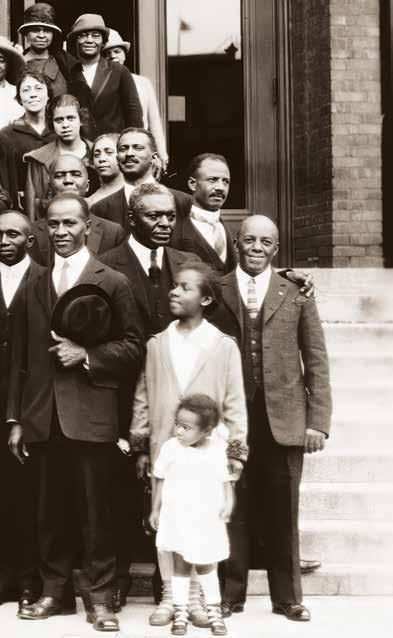
most effective spokespersons in America’s Black urban communities during the first four decades of the 20th century. He was likewise a leading voice in the struggle for Black equality within the church.
Born in Philadelphia, Pennsylvania, on Aug. 10, 1885, Gustavus Rodgers was the sole convert resulting from evangelistic meetings conducted by Fred H. Seeney in Wilmington, Delaware, in 1908. Gustavus and Alverta, married in 1906, both had roots in the Delaware-based people of ambiguous racial heritage known as the Moors.2 The couple’s light complexions sometimes confused people. When, for example, they arrived in Los Angeles in 1923, their congregants reacted with surprise, thinking that the conference had sent a White man to be their minister.3 Yet there was nothing ambiguous about their identity as Black or about their dedication to racial advancement.
A carpenter by training, Rodgers quickly demonstrated exceptional gifts for ministry and was hired by the Chesapeake Conference in 1910 and assigned to Baltimore in late 1911. He arrived to a congregation of 11, their building “in a half-wrecked condition.” When his pastorate at Baltimore Third church (later named Berea Temple) concluded six years later, the membership had grown from 11 to 300, a church building had been acquired and renovated with over 75% of the mortgage paid, and a thriving church school had been established.4 It
was the beginning of a pattern.
At the Ephesus church in Washington, DC, Rodgers’ next assignment, he again placed a high priority on the quality of the house of worship as foundational to evangelism. After a major renovation completed in 1919, Rodgers claimed that the Ephesus structure now ranked “among the most modern and beautiful of our houses of worship.”5
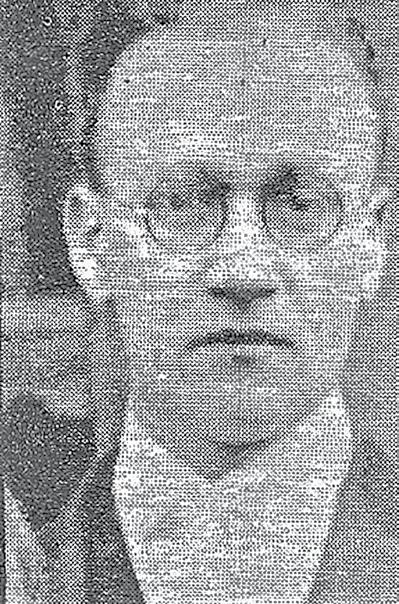
At the outset of his ministry in Washington, DC, Rodgers used a special lecture he had originated in Baltimore to show that he and the movement he represented had something of importance to say about the dilemmas specific to the African American experience. He spoke on “The Black Man as God Sees Him, or the Inspired History of the Negro” at Black America’s leading cultural and intellectual forum, the


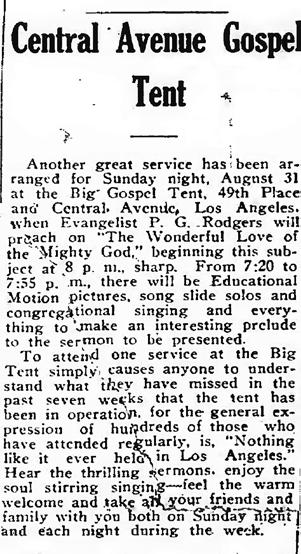
Bethel Literary and Historical Society, on Nov. 26, 1918. W.E.B. Du Bois and A. Philip Randolph were among the other lecturers during the society’s 19181919 season.
Such presentations helped stir interest in Rodgers’ expositions on the Bible delivered at the “Big Gospel Tent” on Sherman Avenue during the summers of 1918, 1919, and 1920. Rodgers baptized more than 200 new believers while at Ephesus, including three noteworthy individuals, all baptized on Dec. 5, 1920: Willie Anna Dodson, on her way to a pathbreaking career as a public school administrator; her husband, Joseph T. Dodson, an entrepreneur with an intellectual bent; and Eva Beatrice Dykes, about to become the first African American female to complete Ph.D. requirements. All three would become part of the lay committee that spearheaded denomination-wide change in race relations during the 1940s, a story told in the book Change Agents, published by Oak & Acorn in 2020.6
In 1923, Rodgers was called to pastor the East
36th Street church in Los Angeles. Organized in 1908 with the name Furlong Tract, it was the first Black Adventist church on the West Coast. Several of the young people who came of age in this fellowship would make notable contributions in both church and society. These included evangelist and church leader Owen A. Troy, pioneering public health advocate Ruth J. Temple, and educator and author Arna Bontemps, prominent in the Harlem Renaissance. When the congregation moved to a new building on East 36th Street in 1922, it had a relatively strong membership of 99. But that was about the same as it had been a decade before. Adventism still was barely touching the booming Black population of Los Angeles.
In the summer of 1924, Rodgers set up the 1,000-seat Big Gospel Tent on Central Avenue in the heart of the Black community for three months of evangelistic meetings. This would become an annual, summer-long happening for most of the next 15 years. The 1924 campaign drew nearcapacity crowds on Sunday nights and 400 to 600 on weeknights, including sizable contingents of White people. The church membership doubled to 200 as a result, making it clear already that a larger church building would be necessary.7
The California Eagle described the new 800-seat church, completed in the summer of 1927 on the corner of 35th Street and Wadsworth Avenue, as “one of the finest churches in the city.” With music also a top priority, a “beautiful alcove” behind the pulpit accommodated a Moller pipe organ along with the
church’s large choir that, according to the Eagle, was “known far and wide in the city for the artistic nature of its work.”8 Rodgers, along with other church members, joined in the construction work to help keep costs down. Less than two years later, on March 2, 1929, the 300-member church held a “noteburning service” to celebrate final payment on the debt. Rodgers honed his method of drawing crowds with “thrilling sermons” that framed Adventism’s end-time warning message in issues of current public interest. In July 1936, for example, with European dictators stirring widespread anxieties about another world war and Italian aggression in Ethiopia arousing particular concern among African Americans, a large headline in the California Eagle announced, “Elder Rogers to Discuss Ethiopian Situation.” That discussion apparently was to be part of a broader presentation under the title announced for the July 28 meeting, “Can Just Four Angels Hold in Check the Hatred of the Nations?” Rodgers now made heavy use of slides, and for this topic he promised that close to “four score marvelous and beautiful pictures will be thrown on the big screen.”9 Rodgers’ ministry was not restricted to the Black


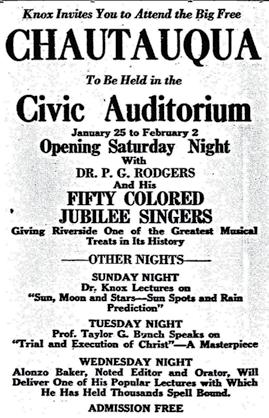
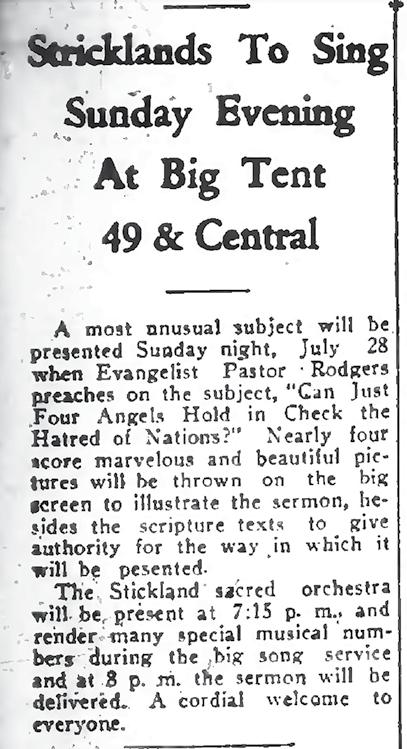
community. He served on the Southern California Conference Executive Committee from 1927-1937 and was frequently a featured speaker at camp meetings and other conference-wide gatherings. He also lent his preaching and the music of his renowned choir, for which he selected the name Jubilee Singers, in support of the efforts of leading White evangelists, such as H.M.S. Richards Sr. and Philip Knox.
As he had been in Baltimore and in Washington, DC, Rodgers was a relentless and passionate activist for equal opportunity in Christian education in Southern California. Though delayed by the Great Depression, a major advance took place in 1936 when the Wadsworth School opened with 68 students in eight grades. Two years later, it had become a junior academy with an enrollment of 112.
In 1938, restrictions on placement opportunities for Black interns by the College of Medical Evangelists (CME) in nearby Loma Linda drew vigorous protest from Rodgers. The preacher thought he had mediated a solution that satisfied both the NAACP and the General Conference administration, but he was outraged when the CME board voted a change to the wording of the policy in a way that, he contended, changed nothing in actuality. He warned that the NAACP would not let the matter go and declared that the only reason he
could imagine for such a “regrettable action” was that “the spirit of a doomed world is getting into the hearts of the leaders of Israel.” Rodgers urged a change so that nothing would be done to cause Black Adventists “to wonder if the entire set-up of pretended interest in them is not one grand colossal mockery.”10
Rodgers’ outspokenness on racial matters apparently made some church leaders feel uneasy about his loyalty to denominational organization. In fact, his very success as a pastor-evangelist made him suspect in an era when three of his contemporaries who were likewise effective became alienated from the denomination over racial issues: Lewis C. Sheafe (1916), John W. Manns (1916), and James K. Humphrey (1930). As one General Conference administrator put it, the basic concern about Rodgers was that “he was a man who has drawn very strongly to himself.” 11 In other words, he was perceived as exerting too much personal influence over his large congregation.
In 1940, his pastorate in Los Angeles having extended to an unheard-of length of 17 years, the pressure grew on Rodgers to accept a call elsewhere. He resisted doing so in part because his wife, Alverta, suffered from a respiratory condition that the Southern California climate
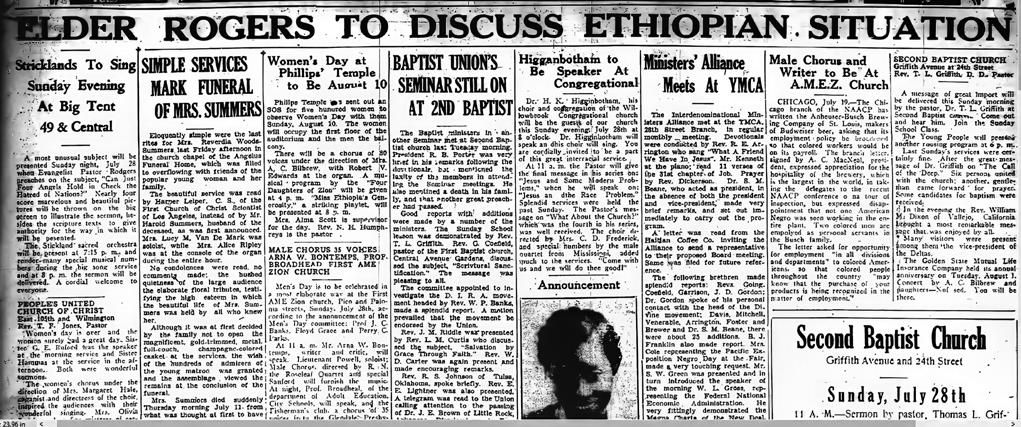
made more tolerable. Additionally, the 55-yearold preacher was beginning to show signs of serious health difficulties of his own. In the end, it seemed that the best solution was for Rodgers to accept a leave from full-time ministry due to disability.
Alverta’s health worsened in 1941 due to “heart trouble,” and she died on June 16, 1942. Though her role went almost completely unmentioned in public reports, she had been an active and indispensable partner in her husband’s ministry from the beginning more than 30 years before.
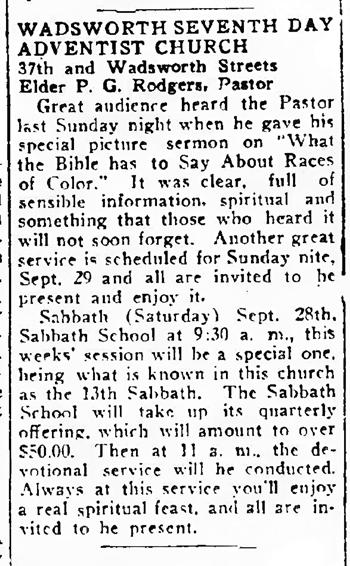

P.G. Rodgers never returned to full-time ministry, though he did preach occasionally until 1959, when he put up for sale his collection of “3,000 color stereopticon slides,” along with a “Bausch and Lomb dissolving lens machine” that he had used in leading 1,008 individuals to baptism during his time in California.12 Despite his persistent agitation against racial injustice in the church and the disappointment surrounding his early retirement, Rodgers testified in 1960, “I have loved every phase of the Message during these years and have never doubted one line of it.”13 He died in La Mesa, California, on Sept. 24, 1961, at age 76.
P. Gustavus Rodgers was both a powerful evangelist and a personable congregation-builder, a visionary promoter and a pragmatic leader skilled in bringing dreams to reality, unreserved in his dedication to the mission of the church and unrelenting in urging it toward a more Christ-like pattern of race relations.
Adapted by permission from the Encyclopedia of Seventh-day Adventists, encyclopedia.adventist.org. For full documentation and a more detailed treatment of Rodgers’ career, see “Rodgers, Peter Gustavus (1885–1961),” Encyclopedia of Seventh-day Adventists, https://bit.ly/47de92v
1“Seventh Day Adventist Church Fetes Pastor and Wife on the Occasion of the Couple’s Silver Wedding Anniversary,” California Eagle, Jan. 9, 1931.
2C.A. Weslager, Delaware’s Forgotten Folk: The Story of the Moors and the Nanticokes (Philadelphia: University of Pennsylvania Press, 1943).
3Louis B. Reynolds, We Have Tomorrow: The Story of American Seventh-day Adventists with an African Heritage (Washington, DC: Review and Herald Pub. Assn., 1984), p. 177.
4Gustavus P. Rodgers, “The Work Among the Colored People in the Chesapeake Conference,” Review and Herald, Feb. 21, 1918, p. 17.
5Gustavus P. Rodgers, “Work for Colored Believers in Washington, DC,” Review and Herald, July 17, 1919, p. 24.
6Douglas Morgan, Change Agents: The Lay Movement that Challenged the System and Turned Adventism Toward Racial Justice (Westlake Village, CA: Oak & Acorn Publishing, 2020).
7Mrs. A.H. Baker, “East Thirty-Sixth Street Church,” Pacific Union Recorder, Sept. 11, 1924, p. 3.
8“Seventh Day Adventist Church Fetes Pastor and Wife,” pp. 1, 3.
9“Elder Rogers to Discuss Ethiopian Situation,” California Eagle, July 18, 1936, p. 10.
10P.G. Rodgers to W.E. Nelson, Jan. 6, 1939, General Conference Archives, RG 11, Box 3957.
11H.T. Elliott to W.G. Turner, June 9, 1040, GCA, Sustentation Files, RG 33, Box 9774, P. Gustavus Rodgers.
12Advertisements, Pacific Union Recorder, July 27, 1959, p. 14.
13P.G. Rodgers to R.H. Adair, Feb. 5, 1960, P. Gustavus Rodgers Sustentation File, GCA.


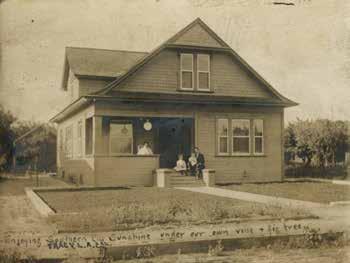



William Ward Simpson was born in Brooklyn, New York, on August 1, 1872, to English parents. The family moved back to England shortly afterwards and then returned to the U.S. when he was 11. His father died soon after the voyage.
When William fell ill, his mother was advised to take him to Battle Creek. Though from an atheist family, William accepted the Adventist message at 18 and began work in the Sanitarium and later at the Review and Herald.
One day, as he operated one of the printing machines, he announced to his foreman that he was leaving “to preach the third angel’s message.” Soon after he was given a ministerial license, and he worked both in Michigan and in Ontario, Canada, which came under the Michigan Conference at that time.
He organized a church in Kent County, Ontario, but while there he was imprisoned for 40 days for the crime of “desecrating the Sabbath” under the local Sunday laws. While in prison he wrote poetry and sent letters, one of which records his experience and was printed in the Review and Herald: “My cell is so small I have hardly room to undress. I am locked in at six o’clock, and let out at seven next
morning, so you see that the most of my time is spent there. I am not lonely; for the most precious experiences of my life have been while locked in my cell. Instead of being shut in by bare walls, it seems like being shut in with Jesus.”1 He later used

this experience in some of his handbills advertising his evangelistic meetings.
In 1897 he and another licensed minister began a church among the Iroquois in a reservation near Brantford, Ontario—the first Native American church in North America.
In 1899 he married Nellie Ballenger, daughter of Adventist pioneer John Fox Ballenger, having first met the family in 1894.
Moving to California in 1902, he developed his evangelistic strategies and held meetings in Redlands, Riverside, Pasadena, San Diego, San Francisco, and Oakland.
But his greatest work was reserved for the city of Los Angeles. Beginning in 1904, he held public meetings in the downtown area and attracted thousands.
Using graphic illustrations and clear expositions of Bible truth, he convinced many of the Advent message. After the first set of meetings, over 200 were baptized. When it was thought he would finish, a petition was circulated by the local people, urging more meetings.
When the conference did suggest a move, Ellen White opposed it. She took a great interest in Simpson’s work, writing to him several times. However, she was concerned about burn-out, telling him, “I am deeply interested in your work in Southern California. I am so anxious that you shall not break down under the strain of long, continuous effort. Let someone connect with you who can share your burdens. This is the plan that was followed by the Great Teacher. He sent His disciples out two and two.”2
She also spoke very favorably about his methods: “Brother S is an intelligent evangelist. He speaks with the simplicity of a child. Never does he bring any slur into his discourses. He preaches directly from the Word, letting the Word speak to all classes. His strong arguments are the words of the Old and the New Testaments. He does not seek for words that would merely impress the people
with his learning, but he endeavors to let the Word of God speak to them directly in clear, distinct utterance. If any refuse to accept the message, they must reject the Word.”3
She praised his ingenuity: “I am pleased with the manner in which our brother [Elder S] has used his ingenuity and tact in providing suitable illustrations for the subjects presented—representations that have a convincing power. Such methods will be used more and more in this closing work.”4

So it was all the more tragic that he died so early, at the age of 34 in 1907, leaving behind his wife and three young children. Ellen writes of her sadness: “While we were at Loma Linda, we were made sad to hear of the death of Elder W.W. Simpson. Brother Simpson was a man who thoroughly believed the message for this time, and he preached it with power. His winning way of
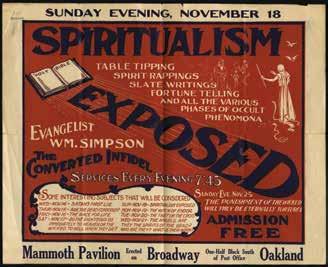
presenting Bible doctrines, and his ability to devise and to use suitable illustrations, enabled him to hold the close attention of large congregations. He had confidence in the power of the word of God to bring conviction, and the Lord greatly blessed his efforts in the salvation of many souls.”5
Ministerial colleague Roderick S. Owen conducted Simpson’s funeral and wrote, “The service, conducted in the Central church in Los Angeles, was attended by a large concourse of people.... He was buried in the new cemetery at Tropico, Cal., where he will sleep in Jesus until the voice of his Master calls him forth to behold, in wonder and rapture, the scene of Christ's return to earth, which scene he has so often and so vividly portrayed before his audiences.”6
Even so, come, Lord Jesus.
1. William Simpson, “From Chatham Jail,” Review and Herald, May 26, 1896, p. 333.
2. Ellen G. White, “Proper Voice Culture,” Manuscript Releases, vol. 9 (Silver Spring, MD: Ellen G. White Estate, 1990), p. 15.
3. Ellen G. White, Evangelism (Washington, DC: Review and Herald Pub. Assn., 1946), p. 204.
4. Ellen G. White, Evangelism, p. 205.
5. Ellen G. White, “Notes of Travel—No. 2,” Review and Herald, Aug. 1, 1907, p. 8.
6. Roderick S. Owen, Review and Herald, May 23, 1907, p. 23.


The beginnings of Adventist work in Arizona are a little hazy. Certainly there were Adventists in Arizona by the 1880s—there is an entry in the Seventh-day Adventist Yearbook for 1884, but with no details. A.J. Potts indicates that the Phoenix church began in 1887 and that it was organized in 1890. In 1889, the California Conference took the responsibility for the largely un-entered territories of Utah and Arizona.
At the 1891 General Conference Session, R.A. Underwood reported, “Since the last General Conference, the California Conference has opened the work in Utah and Arizona. At Phoenix, Ariz., a church has been organized with eighteen members, and a good work started.”1 In 1895, Arizona was taken over as a General Conference mission, but in 1901 it was added to the territory of the newly created Pacific Union Conference.
One of the early pioneers, George States, wrote in the Review and Herald,
The work in this territory moves slowly, and at times looks discouraging. About the first of October [1898] I began holding Bible readings in Phoenix. I continued this work, assisting some on the church building from that date until January 15. As a result, I had the joy of baptizing two souls, and seeing them unite with the Phoenix church.
This original painting commemorates the first Hispanic Adventist baptism. It occurred on Dec. 9, 1899, in the Gila River at Sanchez, Arizona. Marcial Serna, formerly pastor of the Tucson Mexican Methodist-Episcopal Church, had accepted the message shared with him by Adventist literature evangelists. Included in the group of 15 baptismal candidates were Abel and Adiel Sánchez, along with several of their children. On Dec. 23, the church in Sánchez, Arizona, was officially organized, becoming the first Spanish Seventh-day Adventist church in North America.
January 15 I bade good-by to a large number of our brethren and sisters, and came to my new field at Flagstaff, nearly three hundred miles distant. As far as I know, there are none of our people within one hundred miles of us. It was quite a change to leave the warm climate of Phoenix and go to a place where the ground was covered with snow at an altitude of about seven thousand feet. I began at once to visit from house to house, leaving tracts, and taking orders for “Steps to Christ.” I have been over about two thirds of the place, have distributed several thousand pages of tracts, and expect to put at least seventy-five more copies of that valuable book into the homes of the people. I am giving some Bible readings, and a few seem interested. My wife and daughter are with me, and we hope soon to have others unite with us in our little Sabbath-school.2
The challenges of spreading the word are illustrated by some of States’ experiences. He went by bicycle through the Verde Valley, where he
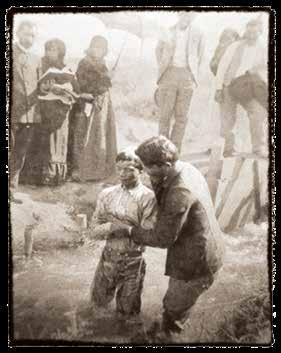
gave out tracts and visited people from previous meetings. While he was traveling through Peeples Valley with a tent and equipment, his wagon broke down, forcing long treks to find water. He had convinced a number of people of the truth, but when he returned 30 months later, only one family was left. There had been a drought and, due to the nature of the environment, the population was very transient. In addition, religious ideas seemed to many to be a luxury as they struggled to survive. A common saying among those who came west seeking gold was that they left their religion behind at the Missouri River.
Illustrating the diverse nature of the West, it’s fascinating to learn that the first people among the Hispanic community to become Adventists in the United States lived in Arizona.
In 1899, literature evangelists Walter Black and Charles Williams contacted a Methodist minister, Marcial Serna, from Tucson. Following a public debate, Serna accepted the Sabbath, and he then shared this truth with his members, many of whom also became Adventists. The first Spanish church was in Sanchez, Arizona, with 15 members attending. Marcial Serna himself became the first Hispanic pastor in the Adventist Church.
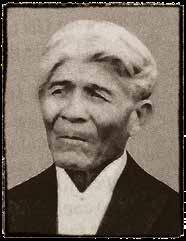
In 1901, R.M. Kilgore reported to the General Conference:
In this mission field we have four organized churches, three of which have been developed since last General Conference. They are provided with a neat and comfortable meeting-house at each point (total value, $3,700), and so nearly paid for
that they are practically out of debt. Two of these are Spanish-speaking churches, a few Americans being connected at Tucson. In the territory there are 111 members and 17 isolated Sabbath-keepers. Tithes paid to General Conference in 1900 were $459,— $4.13 per capita. Amount paid to the Foreign Mission Board, $59.90; book sales for six months, $107.50.3
It’s interesting to note that the initial Tucson church membership was made up of 13 Spanish speakers, nine English speakers (including four workers), and one Chinese speaker. The church at Solomonville was made up entirely of Spanishspeaking members. By the end of 1901, the mission had one ordained minister, three licensed ministers, two Bible instructors, one literature evangelist, and one church school teacher. In 1901, Arizona became a mission of the Pacific Union Conference, newly established in a global reorganization of the Adventist Church’s administrative structure intended to allow local leadership greater say in directing the Church’s work. This change led directly to significant evangelistic progress in various areas, including the Pacific Southwest. General Conference
president A.G. Daniells commended the new union conference for taking immediate action to send workers to Arizona to develop the Church’s program there:
Perhaps no Conference in the States has done more thorough work in organizing than has the Pacific Union Conference. It has added to what was District 6, Arizona, Alaska, and Hawaii. The new administration began July 1, 1901. Without delay, laborers were sent to Arizona, Alaska, and Honolulu.4
The Arizona Conference was organized in 1902. It had four churches—Flagstaff, Phoenix, Solomonville, and Tucson—along with a company at Bisbee, altogether comprising 128 members, with one ordained and three licensed ministers. E.W. Webster, who had been superintendent of the mission, continued as president of the conference. The Arizona Conference was formally admitted to the Pacific Union Conference on March 18, 1904.
1General Conference Daily Bulletin, vol. 4, March 8, 1891, p. 25.
2George O. States, “Arizona,” Review and Herald, Feb. 14, 1899, p. 109.
3General Conference Bulletin, vol. 4, April 4, 1901, p. 60.
4A.G. Daniells, “A Brief Glance at the Work of Re-organization,” General Conference Bulletin, July 1, 1901, p. 514.

The adobe Sanchez church became the first Spanish-speaking Adventist church in North America on Dec. 23, 1899.


Photograph of the first evangelistic meeting held in Hawaii from January through March 1886. From left to right: Birdie Healey, William Healey, Clara Healey, Loran A. Scott, and Abram La Rue.


The Hawaiian Islands were formerly known as the Sandwich Islands. Visited by Captain James Cook in 1778, he named them after John Montagu, 4th Earl of Sandwich. The name Hawaii came into use later. Ellen White still referred to them as the Sandwich Islands in 1892.
Adventist work in Hawaii began in 1884 when Abram La Rue and Henry Scott went at their own expense to do missionary work and sell books. Pioneer and historian John Loughborough records: “This awakened such an interest on the island that the General Conference, in November, 1885, voted that Elder Wm. Healy go the next season to Hawaii to labor, and that the California Conference be requested to loan a tent for this purpose. Thus equipped Elder Healy and those already on the island conducted a tent-meeting during the summer of 1886. As the result of this effort a number of persons accepted the message. Mr. La Rue remained in Honolulu till the year 1889, when he set sail for Hong Kong, China.”1
W.M. Healey arrived in Honolulu on Dec. 27, 1885, with his wife and 10-year-old daughter. To save money, they had traveled steerage class (no cabin) for $25 each. He began evangelistic meetings on Jan. 15, 1886, in a 50-foot tent pitched on the corner of Vineyard and Fort streets. The meetings were attended by the many interested people gathered by the two literature evangelists. Healey left Honolulu

four months later, having baptized nine.
A.J. Cudney followed Healey to Honolulu, and on July 22, 1888, he organized the nine charter members as the first Adventist church in Hawaii.
However, this was not reported to the General Conference because nine days later he set sail for Pitcairn Island—and he and his ship never arrived, all being lost at sea. Consequently, the church was not recognized until its reorganization in 1896.
Writing from England in 1896, E.J. Waggoner provided the following information: “A report from the Hawaiian Islands says that our friends in Honolulu are just starting a sanatorium, with a medical missionary in charge. The Chinese work in the islands is prospering, and some natives
connected with the mission are expecting soon to return to China to work.”2
Three years later, Baxter L. Howe also gave an enthusiastic report that, aside from the glowing language, also shows the potential among such a diverse population:
“There is hardly any nationality that is not represented in the Hawaiian Islands. These are constantly coming and going from all parts of the world. As they stop there, we have the opportunity of simply meeting them, and then they pass on.
“But there are many with whom we have more than this passing contact. Perhaps you know that we have a Chinese school established on the island of Oahu, also one in Hilo, and that we are endeavoring to do what we can for those people whom God has permitted to be there in such large numbers.…
“If there is one thing in all the islands of Hawaii that touches my heart more than others, it is the condition of the poor native people. The gospel has been brought to them. Some have accepted it with all their great, free, loving nature. But what was given them was not the true gospel of Jesus Christ.… They fear God, and worship idols.…
“Now I say that we must have something for these people, something that we can take to them, and that they can comprehend, that will lead them step by step out of this condition into the glorious light of the gospel of Jesus Christ.
“Our work among the English-speaking people has been most encouraging to us. It has not shown very largely in reports; but I want to say that there is an open door in the homes of the English-
“There is hardly any nationality that is not represented in the Hawaiian Islands. These are constantly coming and going from all parts of the world.” -Baxter L. Howe
speaking people in the islands of Hawaii to-day.”3
It was the newly formed Pacific Union Conference that, once it was formed, immediately sent workers to Hawaii (as well as to Arizona and Alaska).4
In 1903, the report was of 37 members among a population of 154,000, made up of native Hawaiians, Americans, Chinese, Japanese, and Portuguese.5
On her way to Australia in 1891, Ellen White’s ship stopped in Honolulu for 19 hours. She wrote extensively of her experience in the Review and Herald. The article began, “One week from the time we left California we reached the Sandwich Islands. The scene presented to us from the steamer as we approached Honolulu, was very beautiful… Our steamer was not to leave Honolulu till past midnight, and at the earnest desire of our friends I

had consented to speak in the evening. The hall of the Young Men's Christian Association was secured for the purpose. Only a few hours' notice of the meeting could be given, yet a goodly number were assembled, among them many who were actively interested in temperance and Christian work. I spoke from 1 John 3:1-4, dwelling upon the great love of God to man, expressed in the gift of Jesus that we might become children of God. The Spirit of the Lord was present with us.”6
On her return from Australia, she also stopped in Honolulu on Sept. 14, 1900. She recorded her visit: “About eight o'clock this morning we steamed into the harbor. Elder Baxter Howe was at the wharf to meet us, and gave us a hearty welcome. He took us in a carriage to Sister Kerr's, where we were most heartily welcomed, and where we sat down to a bountiful meal, which we all greatly enjoyed.
“In the afternoon we visited the sanitarium, and were very much pleased with the location. Then we met with a large number of our people at the church, where I spoke for about forty minutes and Willie for about thirty minutes. It was a great privilege to meet with these brethren and sisters, and we wished that we could spend two or three weeks with them. But this would be impossible.
“At the close of the meeting we visited the Chinese school.… We see a large field of work for this school, which should be more fully developed. Thus missionaries can be prepared to go to China and labor for their countrymen.”7
1J.N. Loughborough, The Great Second Advent Movement (Washington, DC: Review and Herald Pub. Assn., 1905), p. 440.
2E. J. Waggoner, “Back Page,” The Present Truth, Aug. 27, 1896, p. 560.
3“The Hawaiian Mission Field,” General Conference Bulletin, vol. 4, April 16, 1901, pp. 279-280.
4“The Pacific Union Conference,” General Conference Bulletin, vol. 4, July 1, 1901, p. 514.
5“Report of the President, W.T. Knox,” General Conference Bulletin, vol. 5, April 2, 1903, p. 49.
6Ellen G. White, “On the Way to Australia: Visit to Honolulu,” Review and Herald, Feb. 9, 1892, p. 81.
7Ellen G. White, “Reflections While Crossing the Pacific,” Manuscript Releases, no.1427, Sept. 14, 1900, pp. 33-34.
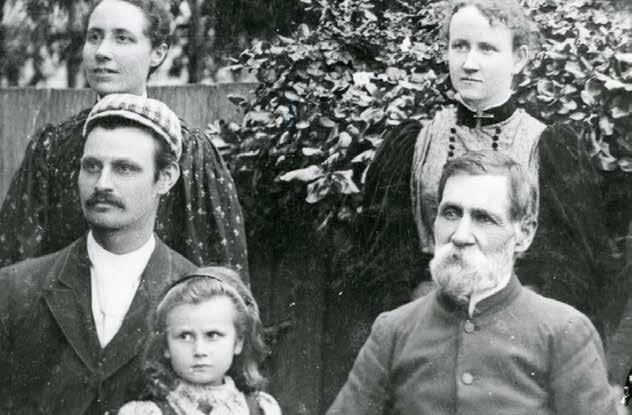
RIGHT: Missionaries Arthur and Carrie Hickox with daughter Lillian Humberta (on the left) and Dr. Merritt Kellogg and wife Louisa (on the right), after sailing to the South Pacific on “Pitcairn.”
BELOW: Rural Health Retreat, near St. Helena, California, founded in 1878 by Dr. Merritt G. Kellogg.
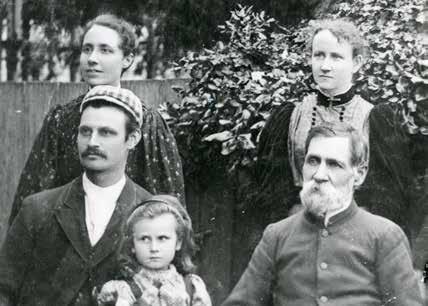

Central California has the privilege of being the very first place in the West to be touched by the Adventist message. In 1859, when Merritt Kellogg, stepbrother of John Harvey Kellogg, arrived in San Francisco with his wife and family, he was ready to share his faith. His first convert was B.G. St. John, a “forty-niner” (one who had been part of the California gold rush in 1849) who had also been a follower of William Miller in 1844.

Dr. Merritt G. Kellogg.
By 1861 Merritt Kellogg had collected a group of 14 believers together. In 1864 he was joined by J.W. Cronkite, a shoemaker, who had come from Michigan by ship. He planned to support himself by his trade and do some missionary work by circulating tracts.
On behalf of the group, Kellogg sent a request for a minister to the General Conference, along with $133 in gold. The GC replied that they were not able to send anyone, but they kept the gold. So in 1867

Kellogg went east to plead his case to the GC in person. He didn’t arrive in time for the meeting, so he stayed until the next one—a year later!
In 1868 he was successful in persuading the GC to send evangelists to California, which at that time seemed to be at the ends of the earth. John Loughborough and Daniel Bourdeau took a ship to Panama. Loughbrough dryly observed an incident with some humor: “As we boarded the boat, Elder Bourdeau’s $5 hat got knocked into the water, which he fretted about every day until we reached Panama.” 1
They went overland across the Isthmus of Panama and then took another ship to San Francisco. (The Panama Canal was not finished until 1914.) On arrival they went immediately to B.G. St. John’s house and met the new believers.
They had intended to set up their tent in San Francisco, but they were invited by a group of
In 1868 he was successful in persuading the GC to send evangelists to California, which at that time seemed to be at the ends of the earth.


Independent Christians to come to Petaluma, 50 miles north. So it was not until 1871 that Loughborough began his first public meetings in downtown San Francisco.
Miles Grant, a minister of the Advent Christian Church from New England, had held some meetings in which he was supported by some of the Adventists—including St. John, who had Grant stay in his home. But then Grant left rather abruptly with the recommendation that his followers join the Methodist Church. About 50 did not want to do this and organized themselves into a separate group. St. John sent an urgent message for Loughborough to come, and many of this group went to hear him preach and joined the Adventist church. In total
about 70 new members joined the church in San Francisco.
In 1872 James and Ellen White accepted an invitation to visit California and traveled to Oakland, arriving in September. James White observed, “We like the people of California, and the country.”2
After speaking at camp meetings and other events, and helping with the organization of the California Conference, they headed back to Battle Creek. However, the Whites liked California so much that they were back again in December of the following year.
Loughborough records in 1874 that “Wesley Diggins of San Francisco made an earnest request that the double tent be erected in his city. We secured a lot on Golden Gate Ave., and opened meetings Oct. 16. Elder Butler took part until November 1, when he and Elder Cornell returned to Michigan. Attendance was between 800 and 1,200 nightly.”3
This was also during the time when James and Ellen White were present. Loughborough recalled, “My labors were associated more or less with the Whites until February, when the failing health of my companion called for my attention at home in St. Helena. I spoke to the company there on Sabbaths until she peacefully passed away on March 24. She sleeps quietly in the St. Helena cemetery.” 4 Loughborough’s wife Maggie died at age 35 from tuberculosis.
James and Ellen were convinced to make Oakland the center for the work in California. The forerunner of the Pacific Press was set up there, and Signs of the Times began publishing. In fact, the Whites sold up everything they had in the East to make this investment possible. In 1899, Ellen White wrote, “We went over the same ground in California, selling all our goods to start a printing press on the Pacific Coast. We knew that every foot of ground over which we traveled to establish the work would be at great sacrifice to our own financial interests.”5
The need for a church in San Francisco was obvious, but the congregation had little money.

However, with encouragement, the impossible happened. Loughborough again:
On April 14 [1875], the leading members of the San Francisco church met at the home of Sister J. L. James, and Sister White related to us what had been shown her in vision. She stated that San Francisco would always be a mission field, and urged upon us the importance of erecting a house of worship. It would look to that poor church like a move in the dark, but if they moved out as the providence of God opened the way, the cost would be entirely met. Knowing as I did the financial condition of these members, to build a church 35 x 80, where a lot alone cost $6,000, looked indeed like a “leap in the dark.”
But we found a lot on Laguna Street for $4,000. Then one sister promised $1,000 if she could sell her place, and within two weeks she sold it for $1,000 above the price she had valued it. A brother who could not see how a church could be built said, “If the Lord says it must be done, He will open the way.” Soon he received $20,000 from an estate settlement and gave $1,000. The church was erected for $14,000, including the price of the

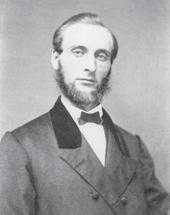

LEFT TO RIGHT: John Loughborough, Daniel Bourdea, and Miles Grant (From F.L. Piper, Life and Labors of Miles Grant [Boston: Advent Christian Publication Society, 1915]. Shared by Douglas Morgan). RIGHT: San Francisco Central Seventh-day Adventist Church, built in 1892, was originally a MethodistEpiscopal church.
lot, over half of which was paid for before it was finished.6
The emphasis was always on mission. In 1876, a Bible institute was held in Oakland. The California Conference provided board and room for the 48 participants, and it was conducted by Uriah Smith and James and Ellen White, showing in a very practical way their commitment to the work in California.
Because of the rapid growth in California, the decision to divide the Conference was taken at the Oakland camp meeting in 1901. Therefore, Southern California Conference was created, being the area of the state south of the Tehachapi and Santa Ynez mountains. In the same year the Pacific Union Conference was formed, with a large territory: Montana, Idaho, Washington, Oregon, California, Alaska, Hawaii, British Columbia, Nevada, Utah, and Arizona.
1J.N. Loughborough, Miracles in My Life (Payson, AZ: Leaves-of-Autumn Books, 1987 reprint), p. 69.
2Arthur White, Ellen G. White: The Progressive Years: 1862-1876, vol. 2 (Hagerstown, MD: Review and Herald Pub. Assn., 1986), p. 359.
3Loughborough, Miracles, p. 92.
4Loughborough, Miracles, p. 92.
5Ellen G. White, The Publishing Ministry (Hagerstown, MD: Review and Herald Pub. Assn., 1983), p. 28.
6Loughborough, Miracles, p. 92.
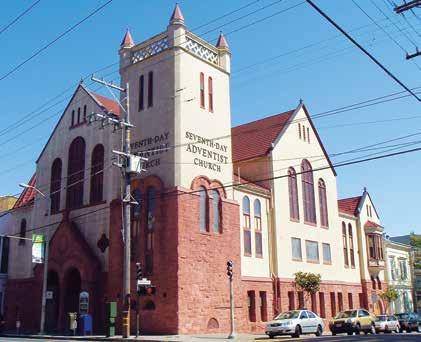
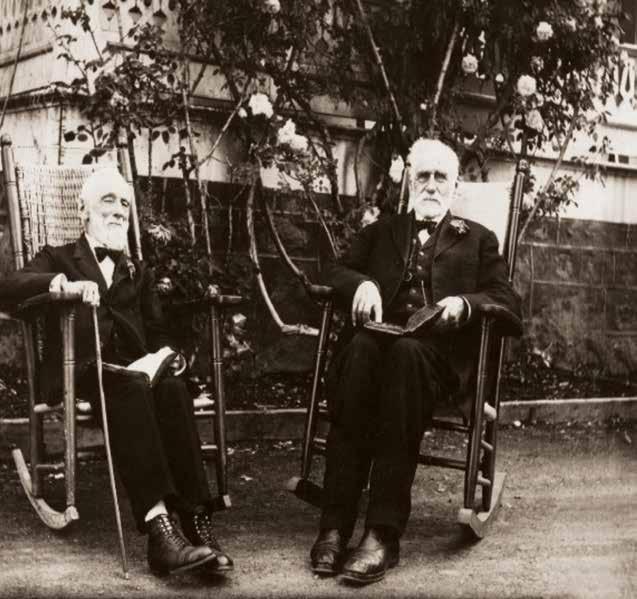
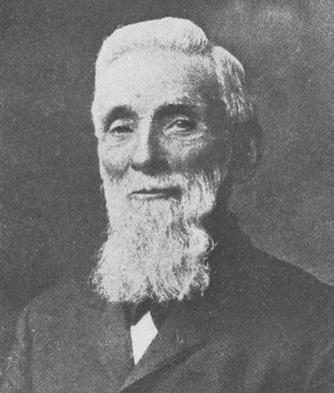


The year was 1869. Evangelists John Loughborough and Daniel Bourdeau had only been in the West for a year. They had started holding tent meetings in northern California—in Petaluma, Santa Rosa, and Healdsburg.
It was in Healdsburg that they received a letter from William Hunt of Gold Hill, Nevada. He’d seen a newspaper report that, though unsympathetic, at least reported what was happening. Hunt didn’t know their names, so he addressed the letter “To the Elders at the Tent in Healdsburg, California.” He had heard they were selling books on Revelation, and he wanted one. Loughborough sent him the book, along with other literature and a letter explaining what they were doing. Hunt replied, sending money and requesting more books. Eventually, Loughborough reported that they had sent him everything the denomination published!
Hunt said he believed it all and was making arrangements to keep Sabbath. He regularly sent money for the books and for tent meeting expenses.
Later Hunt came and met Loughborough, though he was leaving the country en route to New Zealand and then South Africa. In South Africa, he went to the diamond mines in Kimberley and, using the literature he had gathered, introduced the Adventist message there.
Reflecting on the positive experience that came as a result of a critical newspaper report, Loughborough observed, “By this time we knew we need not be alarmed at a little reproach against us.”1

A more permanent Adventist presence began in Nevada in 1876 when Jackson Ferguson, from Santa Rosa, California, began to hold regular Sabbath services. The following year, Loughborough reported that two families from Santa Rosa moved to St. Clair, Churchill County, Nevada. The year after that, they invited Loughborough to come and visit. He records his experience:
I arrived at Wadsworth Station Feb. 1, 1878, and was met by Jackson Ferguson who took me 35 miles across the desert to St. Clair, passing only one residence on the way. St. Clair is on the Carson River about six miles

above the sink, on the edge of the Great American Desert. It is 5 miles from ‘Rag Town,’ were [sic] the immigrants stopped on Carson River for a few days to change their muchworn garments for better clothing before entering the settlements.
During February we held meetings in the Churchill County Institute, the only school building in the county. The whole community turned out and listened with great interest. In addition to those who had moved here from California, eight covenanted to keep all the commandments. When the question arose about my travel expenses and four weeks of labor, a non-member arose and said,

‘The way to raise this is to go down into our pockets and hand out the money.’ Then he laid a $20 gold piece on the desk. Others followed, and in two minutes the sum was more than made up.2
Such generosity was a common feature of the early days in the West.
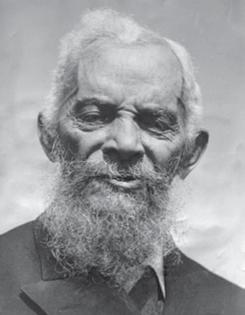
One of those baptized in Reno was Charles M. Kinny, who had been born a slave in Richmond, Virginia. He had gradually made his way west. It was there in Reno that in 1878 he attended J.N. Loughborough’s evangelistic series.
During these lectures Ellen G. White


“Some of our brethren and sisters in Battle Creek and other favored centers should be working in Nevada.”—Ellen White


visited, and on July 30 she preached to an interested audience. She records that she spoke “in the tent in which Elder Loughborough was giving a course of lectures. I spoke with freedom to about four hundred attentive hearers, on the words of John: ‘Behold, what manner of love the Father hath bestowed upon us, that we should be called the sons of God.’” 3
Her sermon made an impact on Kinny. He became convinced of the Adventist message and was baptized on September 30, 1878.
Significant? Absolutely! Kinny was sponsored by the Reno church to study at Healdsburg College, and he became the first ordained Black pastor in the Adventist Church with an important ministry in various areas in the South.
As a result of these meetings and others in Reno, the “Seventh-day Adventist Association in the State of Nevada” was formed, later becoming the Nevada Mission. Nevada’s first Adventist church was built in Reno in 1888.
That was also the year Ellen White visited again, this time for a camp
Ella White Robinson, granddaughter of Ellen White, at the age of 92 wrote her memoirs, beginning when she, a child of 3, traveled to Europe with her parents and grandmother.
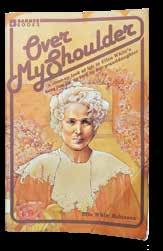
meeting. We have a record of letters she wrote while on the train. In 1905 she passed through Reno again, this time with an even more personal interest, since her granddaughter, Ella White, was teaching at the school in Reno. With her direct experience of the situation in Nevada, Ellen White made one of her very incisive observations: “Some of our brethren and sisters in Battle Creek and other favored centers should be working in Nevada.”4
Churches were organized at Bishop (1903) and Fallon (1906). A report from A.J. Osborne in 1907 mentions church work at Genoa, Gardnerville, Reno, Verdi, Fallon, and St. Clair. Until 1911 the Nevada churches were under the administration of the California Conference. In 1913, the Nevada Mission was organized. In 1931, the Nevada-Utah Conference was created, with 315 members and 12 churches in Nevada.
1J.N. Loughborough, Miracles in my Life (Payson, AZ: Leaves-of-Autumn Books, 1987 reprint), p. 80.
2Loughborough, Miracles in My Life, p. 94.
3Ellen G. White, Testimonies for the Church, vol. 4 (Mountain View, CA: Pacific Press Pub. Assn., 1885), p. 296.
4Ellen G. White, “Notes of Travel—No. 3,” Review and Herald vol. 82, no. 7 (Feb. 16, 1905), p. 8.
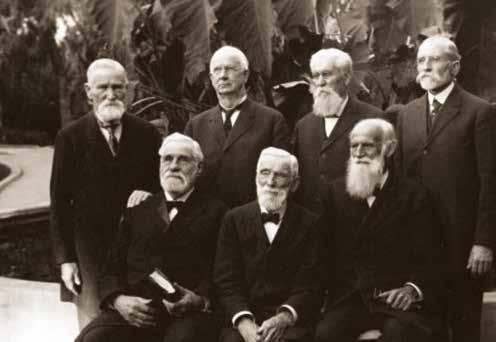

Walter T. Knox, president of the California Conference (1897-1900, 1906-1908).
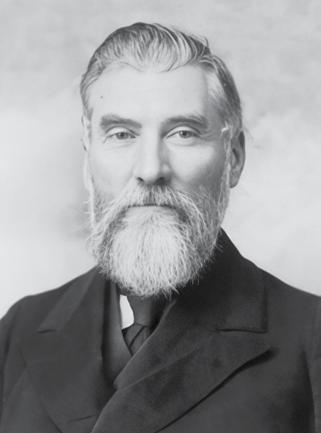
The Santa Rosa church building in 1869, one of the first Adventist churches west of the Rocky Mountains.

A.J. Breed, president of the California Conference (1896-1897).
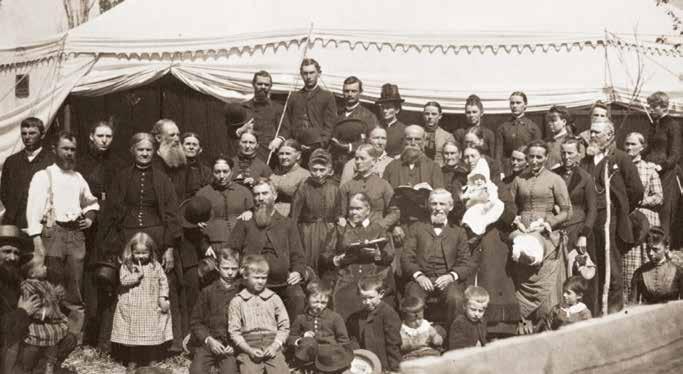

While it was San Francisco that saw the first presence of Adventists in California, it was within the territory of the Northern California Conference that the real work began.
A group of Independent Christians had seen a newspaper announcement about two Adventist evangelists coming west in 1868. Once John Loughborough and Daniel Bourdeau arrived in San Francisco, this group were able to contact them quickly and invite them north to Petaluma.
Loughborough and Bourdeau had already found that holding meetings in San Francisco was going to be expensive, so they readily accepted the invitation to Petaluma.
Loughborough records the way contact was made:
Mr. Hough, one of the Independents of Petaluma, called at St. Johns and inquired if there were two ministers with a tent staying with him. How did he so quickly find us in a city then numbering 175,000? On his way down he had been impressed to go at once to the Pacific Mail and inquire if a tent had come on the last steamer from Panama. As he asked,

‘Where was the tent?’ the very drayman who had moved the tent, came into the warehouse and directed him to Minna St. So in thirty minutes from the time Mr. Hough landed in San Francisco on the Petaluma steamer, he had found us.1

They left for Petaluma the next day. Mr. Wolf, one of the Independents, had dreamed about the two evangelists. When he met Loughborough and Bourdeau, he confirmed they were the men he had seen in his dream. This opened the way for the group to accept their ministry. The tent was pitched, and meetings were held from mid-August to mid-October. Even though there was public opposition, 20 accepted the Adventist message.
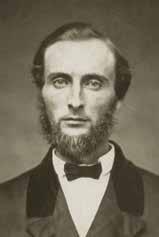
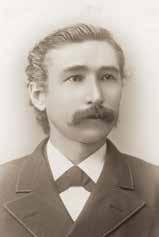

Later that year, Bourdeau and Loughborough spoke in different places in Sonoma County. They held 50 meetings in Windsor. Twelve people accepted the Sabbath, and a Sabbath School was organized. One of the Adventist converts had Abram La Rue working for him. La Rue read some of the literature and went to the meetings. He too accepted the message and became the first Adventist missionary to Hawaii and later to China.
Santa Rosa proved to be very open to the message preached by Loughborough and Bourdeau. The first baptism took place there on April 11, 1869. The first Adventist church was erected in Santa Rosa the same year. They established the first Adventist organization there, with the following officers: president D.T. Bourdeau; secretary, J.F. Wood; treasurer, J.N. Loughborough; executive committee, D.T. Bourdeau, Merritt G. Kellogg, and John Bowman. When the committee was formed, Bourdeau reported: “When we came to Petaluma we knew of but one in this county who was keeping the Sabbath. Now we know of at least seventy-five.”
This number had risen to over 100 by the following year, worshiping in four churches.
James and Ellen White visited the area in 1872-73, speaking in San Francisco, Santa Rosa, Woodland, Healdsburg, and Petaluma. Ellen White recorded in her diary: “January 5, 1873, [Petaluma,]
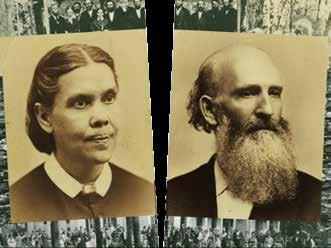
We had three meetings. I spoke at eleven o'clock upon the life and temptation of Christ in the wilderness. I felt the force of the subject I presented before them.”2
It seems that Ellen White had a particular fondness for the small church at Petaluma. She wrote about a visit in 1881:
November 25, I left Oakland for Petaluma, and found a pleasant home with the family of Bro. Chapman, where I have ever been heartily welcomed. On the Sabbath I spoke with freedom to the little company who reverence God's holy day and assemble for his worship. A social meeting followed, in which sixteen testimonies were borne. We realized that the Lord's presence is not confined to large assemblies, but that where two or three are gathered in his name, he meets with them. All seemed strengthened and encouraged. I felt the sweet peace of Christ, the consolation of his Spirit. I was in feeble health, but the precious evidence of the favor of God, more than repaid me for the effort made.
Would that our smaller churches could be more often visited. The faithful ones, who stand firmly in defense of the truth, would be cheered and strengthened by the testimony of their brethren. The few standard bearers at Petaluma have had much to contend with; unruly, rebellious spirits have done their utmost to discourage all who would maintain the truth in righteousness. But these discordant elements have separated from the church. They went out from us, because they were not of us. Those who now meet from Sabbath to Sabbath are at peace with one another, and in harmony with the work of God.3
She mentioned her “feeble health.” After the death of her husband in August 1881, her health had gone downhill. In 1882 she had bought a home

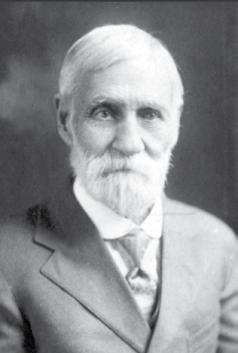
near Healdsburg College, but she was so sick she was not expected to live. However, at the Healdsburg camp meeting in October 1882, she experienced a very public and dramatic healing.
As a result, she was able to write in 1883: “I have not been idle. Since the Lord raised me up at the camp meeting in Healdsburg, I have visited Santa Rosa, Oakland, San Francisco, Petaluma, Forestville, and Ukiah, and have labored in Healdsburg, frequently speaking on the Sabbath and on Sunday evening. In four weeks I gave ten discourses, traveled two hundred miles, and wrote two hundred pages.”4
In 1902 she was pleased to be back in Petaluma, speaking at a camp meeting being held there: “In this world we are to be representatives of Christ. He has called us to glory and virtue. As He represented the Father, so we are to represent Christ to the world; for in representing Him we are representing the Father.”5
Alonzo T. Jones was also at that camp meeting, and he gave this report:
The camp meeting at Petaluma, June 5-15, was good from beginning to end, from the first meeting to the last. This meeting was held for the benefit particularly of those in the northern bay district, including San Francisco, Oakland, and the Sonoma and Napa Valleys. It was also hoped that it might be the means of renewing
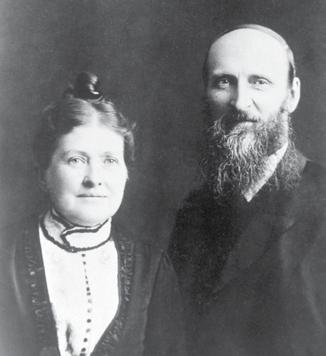

FROM LEFT TO RIGHT: John N. Loughborough, Merritt G. Kellogg, and Marion and Daniel Bourdeau.
and building up the work in Petaluma itself. Petaluma was the first place in California in which the third angel's message was preached, having been visited by Elders Loughborough and Bourdeau immediately after landing in San Francisco from a voyage by way of Panama before the first railroad was finished across the continent. It was a pleasant thing to have Brother Loughborough with us throughout the meeting, and to hear him tell the experiences of the Lord's plain leading in those earliest days.6
The first churches organized in Northern California were: Petaluma (1868), Healdsburg (1869), Santa Rosa (1869), Woodland (1872), Vacaville (1873), St. Helena (1874), Napa (1874), Oakland (1885, now Grand Avenue), Sacramento (1885, now Central; originally Pleasant Grove), Eureka (1885), Calistoga (1887), Deer Park Elmshaven (1890, originally Sanitarium), Stockton (1893, now Central), Placerville (1893), Sebastopol (1893), and Ukiah (1898).
1J.N. Loughborough, Miracles in My Life (Payson, AZ: Leaves-of-Autumn Books, 1987 reprint), p. 71.
2Ellen G. White, “Diary Entry,” Letters and Manuscripts, vol. 2, Jan. 5, 1873.
3Ellen G. White, “Among the Churches. Petaluma,” The Signs of the Times, Jan. 12, 1882, p. 20.
4Ellen G. White, Life Sketches of Ellen G. White (Mountain View, CA: Pacific Press Pub. Assn., 1915), p. 267.
5Ellen G. White, Peter’s Counsel to Parents (Washington, DC: Review and Herald Pub. Assn., 1981), p. 24.
6Alonzo T. Jones, “The Petaluma (California) Camp Meeting,” Review and Herald, July 22, 1902, p. 17.

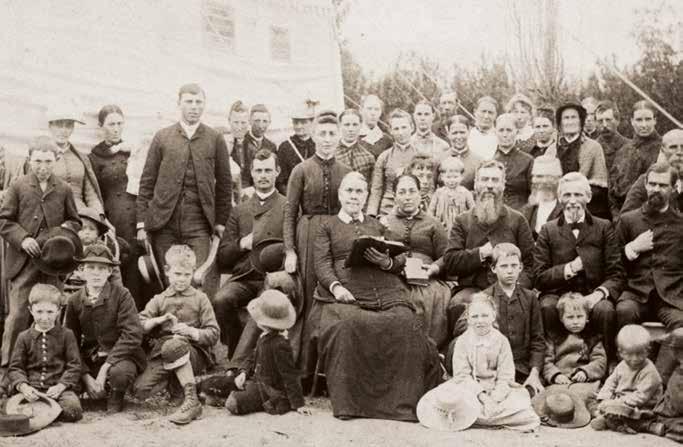
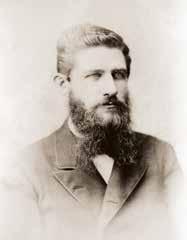
In 1889 a group of literature evangelists was sent by the California Conference to Utah, though they found “the outlook was not at all flattering.”
At the General Conference session in March 1891, it was reported that G.H. Derrick was sent to Utah, noting that this was “perhaps the hardest field for labor in the United States.” It was also recommended that the work should be started “after a study of the people and the best means of reaching them.”
The GC minutes also included the following telling observation by R.A. Underwood: “The Congregationalists have expended more than $250,000 without accomplishing hardly anything in Utah. The Methodists and others have tried the work

with a similar experience, it being almost impossible to reach the people by means of preaching or teaching.”1
So it is surprising in those circumstances that the first Adventist church was organized in Salt Lake City with 20 members the following year. Perhaps due to the challenges, the work in Utah was assigned to direct General Conference supervision in 1894. The first camp meeting held in Utah was in 1896.
In 1902 the Pacific Union Conference recommended the organization of the Utah Conference, with a regular membership of 143 plus some isolated members. There were two ordained ministers and churches in Salt Lake City, Ogden, Provo, and Logan.
Ellen White stops over
In 1883, on one of her journeys across the continent, Ellen White’s train stopped at Ogden. She and her party were taken on a tour of Salt Lake City and the Mormon Tabernacle, as well as the new temple under construction.
She commented, “We were gratified that we had this privilege of visiting the city of the Mormons; but we saw nothing very attractive in this place, and had no desire to make it our home.”2
In 1905, Ellen White stopped again briefly at Salt Lake City. She noted:
At Salt Lake we were met by several of our brethren, who urged us to remain with them

for a few days. By a hard struggle the church in Salt Lake City has built a good meeting-house. In a prominent part of the city our brethren are conducting a vegetarian cafe and a health food store; and all felt the need of counsel as to how to conduct the work in Utah.
This invitation we were obliged to refuse. We had cut short our work in Battle Creek because of the sickness of Sister Marian Davis, and had to hasten home as quickly as possible on her account. Our visit with the brethren at Salt Lake was a short one, but it was cheering to hear of the progress of our work in this citadel of Mormonism.3
In 1909 Ellen White stopped in Salt Lake City on her way home to California. She preached about living for Christ daily and spoke of the education of children. Her last words to the large congregation were:
My brethren and sisters, let us study the simplicity there is in the Word of God. Let us see what we can do to advance the cause of Christ in the earth. Christ was in this world as a man of sorrows and acquainted with grief. There were many who set themselves against his work. There will be those who will oppose you. But your work is to preach Christ and him crucified; and when you do this, the salvation of God will be revealed in the conversion of souls.
Ellen G. White, seated behind children with Bible open, and J. N. Loughborough on the right, at Reno, Nevada, camp meeting, 1888.
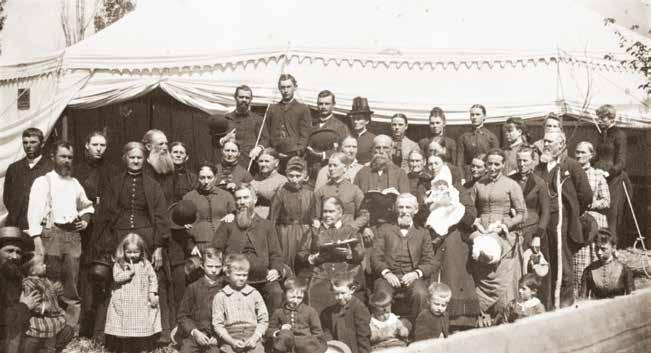
Since I left my home in California in April, I have visited many places, and have spoken to thousands of people. This is the last stop I expect to make before reaching my home again. I would leave these words with you: Carry forward the work in faith and humble dependence upon God. Let each believer have light in himself; then the blessing of God will rest upon you, and you will see the salvation of God in the advancement of his work in this field.4
These were very nearly Ellen White’s last words ever. On the train over the Sierra Nevada mountains it seems that she experienced heart failure due to the high altitude. Hardly any pulse could be detected. She was treated with hot water and peppermint and warmed up with hot water bottles. As the train descended to lower altitudes her condition improved, but it was a close call.
In 1901 it was reported that “Utah is a General Conference mission field. It contains three churches,

with a membership of 161, one unorganized company of ten members, and fifteen isolated Sabbath-keepers, 186 in all, a gain of seventy-one for the past two years. The working force consists of two ordained ministers, one licentiate, and two missionary licentiates. $2,338.10 in tithe has been raised toward supporting their own work.”5
It seems the brethren did not quite know where to put Utah in the geographical administration of the church. Initially it was a separate conference within the Pacific Union, but then in 1916 the InterMountain Conference was formed, made up of the former Utah and Western Colorado Conferences. It stayed part of the Pacific Union Conference until 1919, when Utah (or at least parts of it) became a Mission under the Central Union Conference. Eventually the Nevada-Utah Conference was organized in 1931, and it became part of the Pacific Union Conference once again.
1General Conference Daily Bulletin, vol. 4 (March 8, 1891), p. 25.
2Ellen G. White, “Notes of Travel,” Review and Herald (Jan. 29, 1884), p. 66.
3Ellen G. White, “Notes of Travel—No. 3,” Review and Herald (Feb. 16, 1905), p. 8.
4Reported by W.C. White, “From Colorado to California,” Review and Herald (Jan. 20, 1910), p. 7.
5General Conference Bulletin, vol. 4 (April 4, 1901), p. 54.
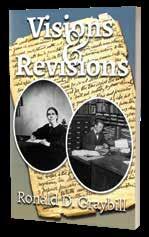

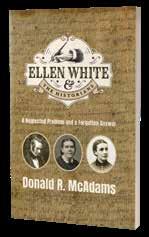

Ronald D. Graybill—Visions & Revisions is the story of how Ellen G. White’s visions underwent revisions by her literary assistants. It explains the editorial processes that began when she first dipped her pen in ink and put it to paper. It even describes that pen and paper.
Gilbert M. Valentine—The Struggle for the Prophetic Heritage relates the intriguing story of conflict and a maturing theological awareness that gradually led to the development of new structural arrangements for the White Estate, ensuring that the writings of Ellen White continued to be a blessing to the church.
Warren C. Trenchard—The Desire of Ages and Its Sources endeavors to make Fred Veltman’s significant 1988 study on the Ellen White book available in an accessible, condensed, and focused form for all readers and to stimulate both a reexamination of his work and engagement in new lines of related research.
Donald R. McAdams—Ellen White & the Historians illuminates a critically important period of change in Adventist understanding of the nature and extent of Ellen White’s authority. It highlights the difficulty and pain church leadership experienced in unlearning damaging misperceptions of Ellen White’s role.
John Brunt—Enjoying Your Bible is for the typical believer in the pew and for those who may not have occupied a pew for a while. It is divided into two main parts. The first offers some general discussion about reading the Bible, and the second looks at specific sections of the Bible to offer a few tips for enhancing your reading.
Alden Thompson—“I Can Sleep on Windy Nights” is for people focused on the end of time—and scared about the unknown. People need to be ready for the end of the world, but they don’t need to be frightened. So if you are one of the frightened ones, or if you know someone who is, this book is for you.
Reinder Bruinsma—In All Humility is assertive but balanced, short but well documented. A must-read for every Seventh-day Adventist confronted (or not) with Last Generation Theology. Beyond addressing the topic, Bruinsma provides a user-friendly overview of the most current hot potatoes within Seventh-day Adventism.
William G. Johnsson—Experiencing Romans discloses the essential beauty in its message: Christ has already done everything. Christ is enough. Johnsson not only analyzes and provides exposition of this good news, he applies it to Jesus’ followers while emphasizing the importance of understanding and accepting the good news of our salvation.








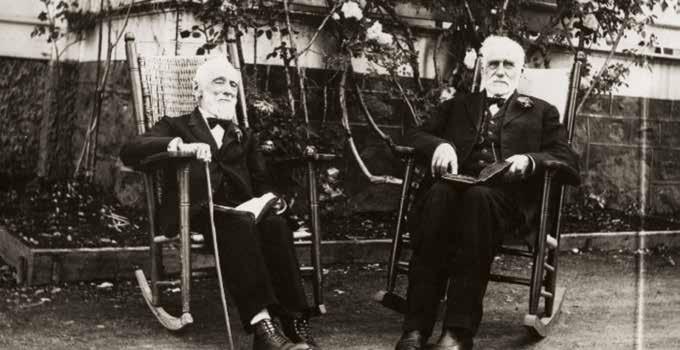
In 1874, John B. Judson was the first ordained Adventist minister to reach Southern California. He was placed in charge of “District No. 4,” which included the counties of Los Angeles, San Bernardino, and San Diego. The Judsons set up home in San Pasqual Valley, where the first church was organized in 1884. Evangelists S.N. Haskell and J.H. Waggoner held meetings in San Diego, and they were followed by William Healey in 1887, leading to a church being built on 18th and G streets. Later in the same city, treatment rooms, a health food store, and a vegetarian restaurant were opened.
In 1902, C.E. Knight and his wife held public meetings in Riverside and baptized six people before going on to Corona. In the same year W.M. Healey reported a church of 140 members in San Diego and a church school with 20 pupils.
And so the work would have continued in the usual way—for example, evangelistic

meetings held in October 1904 and the Ontario church being started after church being started after P.P. Adams began house-to-house sales of Christ’s Object Lessons. However, due to the intervention of Ellen White, a whole new perspective was brought to the work in what is now the Southeastern California Conference.
Already in 1902, Mrs. White was writing, “As soon as possible, sanitariums are to be established in different places in Southern California. Let a beginning be made in several places. If possible, let land be purchased on which buildings are already erected. Then, as the prosperity of the work demands, let appropriate enlargement be made.”
The reason? “Our sanitariums are to be established for one object, the advancement of
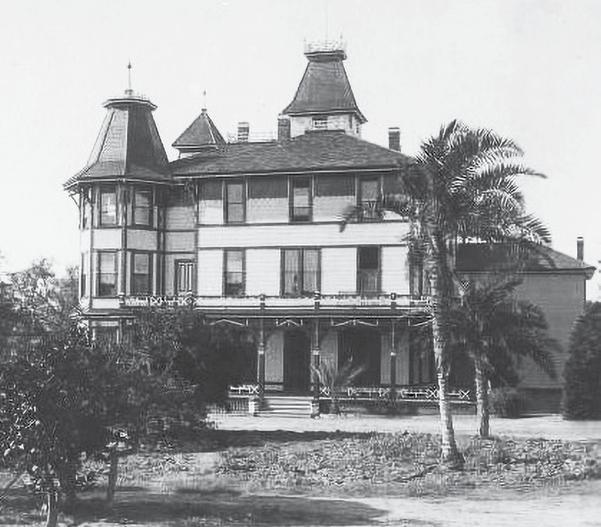


present truth. And they are to be so conducted that a decided impression in favor of the truth will be made on the minds of those who come to them for treatment. The conduct of the workers, from the head manager to the worker occupying the humblest position, is to


“On our way back to Redlands, as our train passed through miles of orange groves, I thought of the efforts that should be made in this beautiful valley to proclaim the truth for this time.”
Ellen White
tell on the side of truth” (Ellen G. White, Testimonies for the Church, vol. 7, p. 97). She was also ready to back up her words with action. Discovering a property called Paradise Valley Sanatorium offered for sale at $20,000, it was discovered it could be bought for $15,000 cash. The brethren weren’t keen to move on the project, despite Ellen White’s urging. Due to a continuing drought, the price kept on dropping—until in January 1904 it was offered for $6,000, perhaps less. Ellen White wrote, “Again I

RIGHT: Ministers at Fall Council in Loma Linda, 1915: Seated (left to right) S.N, Haskell, J.N. Loughborough, George I. Butler; standing: J.H. Rogers, J.O. Corliss, H.W. Decker, H.W. Cottrell.
BELOW: John Allen Burden, the co-founder of Loma Linda University and administrator of several sanitariums, and wife, Elleanor (Baxter) Burden.

advised our brethren connected with the medical work in southern California to secure the place. But I learned that they were not prepared to act. Then I laid the matter before Sister Gotzian, and she consented to join me in securing the place” (Ellen G. White, “Notes of Travel—No. 6,” Review and Herald, March 16, 1905, p. 8). Ellen White took out a bank loan of $2,000, the sister contributed $2,000, and the place was theirs.
Loma Linda
Yet Ellen White was still looking. She wrote, “On our way back to Redlands, as our train passed through miles of orange groves, I thought of the efforts that should be made in this beautiful valley to proclaim the truth for this time. I recognized this section of southern California as one of the places that had been presented to me with the word that it should have a fully equipped sanitarium.… The cause of God is to make more rapid advancement in southern California than it has in the past. Every year thousands of people visit southern California in search of health, and by various methods
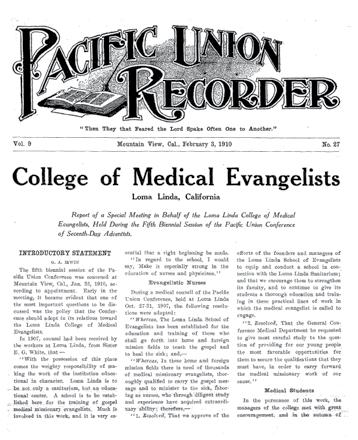

we should seek to reach them with the truth. They must hear the warning to prepare for the great day of the Lord, which is right upon us” (Ellen G. White, “Notes of Travel—No. 7,” Review and Herald, April 6, 1905, p. 8). Nothing immediate came into view. Then local agent John Burden found Loma Linda. "While attending the General Conference of 1905, at Washington, D. C., I received a letter from Elder J. A. Burden, describing a property he had found four miles west of Redlands, five and one half miles southeast of San Bernardino, and eight miles northeast of Riverside. As I read his letter, I was impressed that this was one of the places I had seen in vision” (Ellen G. White, Life Sketches of Ellen G. White, p. 405).
But again it was a question of going forward



in faith. The asking price was $110,000—a huge amount for the time. The leadership baulked. The sellers dropped the price to $40,000. Burden planned to go ahead, but he received a telegram from church headquarters instructing him not to make a deposit on Loma Linda. A couple of weeks later, Ellen White sent Burden a telegram with a follow-up letter countermanding this order. She told him, “Your letter has just been read. I had no sooner finished reading it than I said, ‘I will consult no one; for I have no question at all about the matter.’ I advised Willie to send you a telegram without spending time to ask the advice of the brethren. Secure the property by all means, so that it can be held” (Ellen G. White, Progress of Work at Loma Linda, p. 2).
Burden did as she said, and the property was secured. This was to be far more than a sanatorium in Ellen White’s eyes: “With the possession of this place comes the weighty responsibility of making
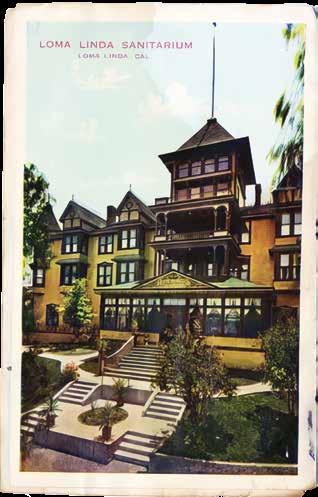
the work of the institution educational in character. Loma Linda is to be not only a sanitarium, but an educational center. A school is to be established here for the training of gospel medical missionary evangelists” (Ellen G. White, Life Sketches of Ellen G. White, p. 406).
Speaking at the General Conference in 1909, J.R. Leadsworth, M.D., gave a report that included this observation: “I am often asked, ‘Why do you have so many sanitariums in California?’ Now, when you understand that California is the health resort of the whole United States, you will see that there is a good reason why we have so many institutions there. People of leisure and means come from all parts of the country to our State; they come to our institutions, and as they are in no hurry, they sit down and inquire about our peculiar tenets. There is no field in the United States where such opportunities are offered to reach the better class as in Southern California” (General Conference Bulletin, vol. 6, June 2, 1909, p. 282).
By 1909 the College of Medical Evangelists (later Loma Linda University) was granted its charter of incorporation from the state.
The growth of Adventist membership in Southern California resulted in the 1915 decision to assign San Bernardino, Riverside, Orange, San Diego, and Imperial counties to a new organization, the Southeastern California Conference, with the other counties remaining in the Southern California Conference.
“With the possession of this place comes the weighty responsibility of making the work of the institution educational in character. Loma Linda is to be not only a sanitarium, but an educational center.” Ellen White


As one of the only faith-based academic health sciences centers in the nation, located in California, Loma Linda University is more than just a university. Compassionate faculty teach over 100 degree and certificate programs with an emphasis on faith. As a student, you’ll get hands-on training at our research facilities, clinics and hospitals with experienced leaders in your field. With eight schools at one university, we are committed to help you advance your career. Answer your calling today.
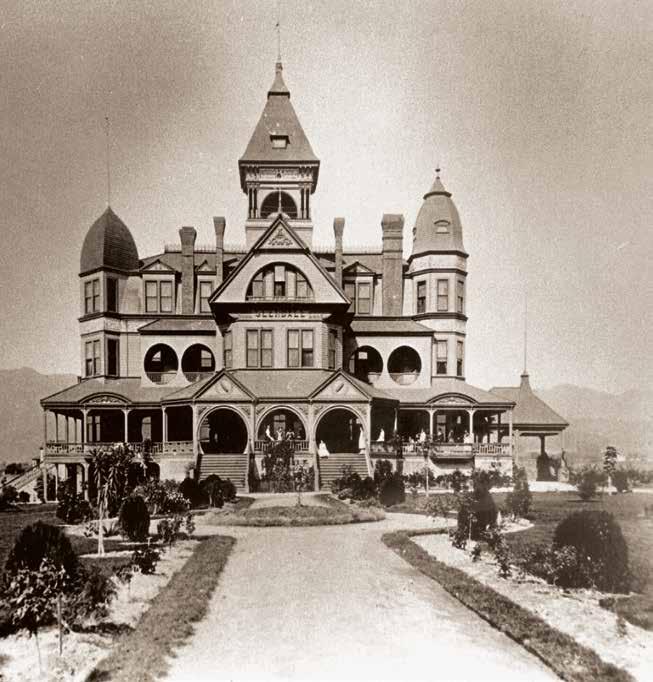
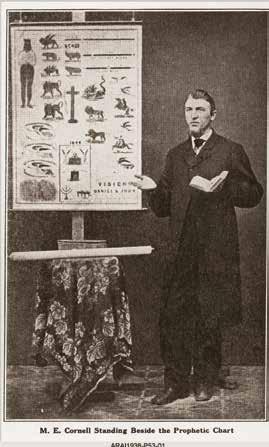


With most early Adventist activity concentrated in the northern part of the state, it wasn’t until 1874 that Southern California had an ordained minister in its territory—John B. Judson. Evangelism picked up with the arrival of William Healey, who held a series of tent meetings in downtown Los Angeles in 1879. This laid the foundations for the first Adventist church in Southern California, which after a couple of moves became known as the Central church. These were small beginnings. E.J. Waggoner refers to “the little company at Los Angeles” in an article in the Signs of the Times of May 29, 1884.
However, a second church group was organized in Norwalk later that year, and it was the first to construct a church building. Later, other churches were built in Los Angeles, San Pedro, and Pasadena. Other approaches to evangelism were also tried. In 1896, a vegetarian restaurant opened, together with medical treatment rooms under the direction of Dr. Moran. These were located between Broadway and Hill on Third Street in Los Angeles. In addition to the group of about 100 that met at the Carr Street church, another group had come together on the east side of Los Angeles, later becoming the Lincoln Park church.
When Merritt G. Kellogg left St. Helena Sanitarium in 1889, he moved to El Monte. He discovered that there were two members there and that in Pomona there was a group of 16—who in 1886 had attended tent meetings conducted by E.A. Briggs, a blind Adventist evangelist.

Up until this time, everything was under the direction of the California Conference, based in Oakland. At a camp meeting held there in 1901, it was decided to form a separate Southern California Conference, made up of the area of the state south of the Tehachapi and Santa Ynez mountains.
The new conference had four ordained and six licensed ministers, 19 churches and two unorganized companies, a membership of 1,200, and 11 church schools.
The church schools were very much part of the church’s mission. The church school begun in 1898 in Centralia, southeast of Los Angeles, was followed in 1902 by schools conducted in Santa
Ana, Pasadena, Norwalk, at the Carr Street church in Los Angeles, and in other cities. The school at San Fernando also began in 1902.
But the big impact on Los Angeles came with the arrival of William Ward Simpson in 1904. He had previously held successful meetings in Redlands, Riverside, Pasadena, San Diego, and San Francisco, but now he turned his attention to the metropolis of Los Angeles. Simpson was probably the most successful evangelist of the time, and he was particularly effective in the cities. His creative style and intriguing presentations captured the interest of many, so that his tent meetings reached some 2,000 in attendance. More than 200 baptisms were the immediate result.
This success caught the attention of church leaders, particularly Ellen White. She wrote several letters to Simpson, encouraging him and suggesting that others adopt similar methods. For example: “I am deeply interested in your work in Southern California. I am so anxious that you shall not break down under the strain of long, continuous effort.
Let someone connect with you who can share your burdens” (Ellen G. White, “Proper Voice Culture,” Manuscript Releases, vol. 9, p. 15).
She wrote about him to others:
Brother S is an intelligent evangelist. He speaks with the simplicity of a child. Never does he bring any slur into his discourses. He preaches directly from the Word, letting the Word speak to all classes. His strong arguments are the words of the Old and the New Testaments. He does not seek for words that would merely impress the people with his learning, but he endeavors to let the Word of God speak to them directly in clear, distinct utterance.…

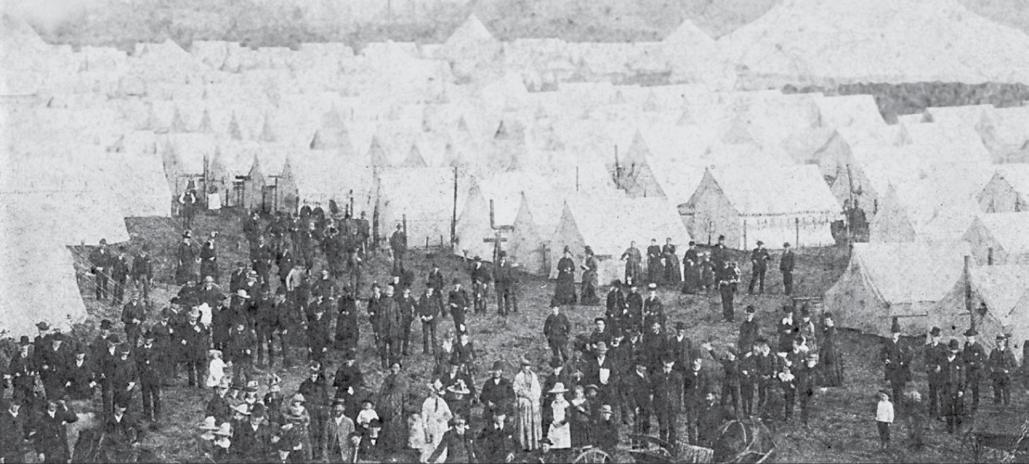
“I am deeply interested in your work in Southern California. I am so anxious that you shall not break down under the strain of long, continuous effort.” Ellen White

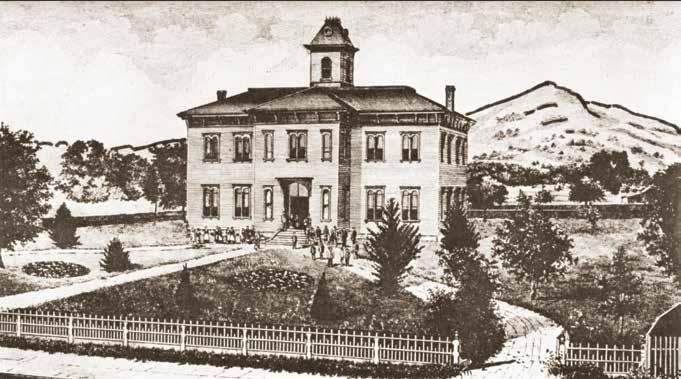
I am pleased with the manner in which our brother [Elder Simpson] has used his ingenuity and tact in providing suitable illustrations for the subjects presented— representations that have a convincing power. Such methods will be used more and more in this closing work” (Ellen G. White, Evangelism, pp. 204-205).
In fact, Ellen White was so interested that she came in person to support him. “For some time Elder Simpson has been holding tent meetings in a large tent, which is pitched near the business part


of the city. On Sabbath morning I spoke in this tent. Notice had been sent to the churches near Los Angeles, and there were about a thousand people present” (Ellen G. White, “Encouraging Letter From California,” The Southern Missionary, Dec. 1, 1904).
When it was suggested that he move to a different location, he received a petition signed by many people asking him to stay for another evangelistic series. Ellen White also thought a move was a bad idea, and she advised he should stay where he was (Ellen G. White, “Counsel Relating to the Work in Los Angeles and the Paradise Valley Sanitarium,” Manuscript Releases, vol. 15, p. 314).
The tragedy was that by 1907 Simpson was dead at the age of 34, leaving behind a wife and three young children. Other evangelists took over, such as Luther Warren from 1908 to 1910, J.W. McCord, Fred Paap, Milton St. John, E.J. Hibbard, C.E. Ford, and others. Ellen White repeatedly encouraged such activities, saying, “Special light has been given me regarding the character and magnitude of the work to be done in Los Angeles. Several times messages have been given regarding the duty that rests upon us of proclaiming the third angel's message with
power in that city” (Ellen G. White, “Notes of Travel— No. 5,” Review and Herald, March 2, 1905, p. 8).
In 1906 Jennie Ireland, a nurse who had graduated from the Battle Creek Sanitarium, began doing medical missionary work among the Black population in Los Angeles. As a result of her sharing her faith, the Furlong (later Wadsworth) Seventh-day Adventist church was organized in 1908 with 23 charter members. Membership grew to 100 before the church had a pastor. The first Black full-time employee was Amy Temple, a Bible instructor. Note this:
Elder R. S. Owen…gave the experience of Jennie Ireland, who worked among the colored people in a Southern California city, ministering to the sick. As a result, barriers were broken down, and hearts were open to receive the gospel. What she taught to one individual, she urged that person to give to some other person. In this way a number of efficient workers had already been developed, and a church of

thirty-eight organized, the members of which are very faithful in observing the principles of health (General Conference Bulletin, vol. 6, May 30, 1909, p. 203).
In 1905, small house meetings began among the Spanish-speaking population. In 1906, E.S. Ballenger baptized eight persons. The conference then hired Augusta E. De Angeles as the first full-time Hispanic worker. By 1907, the first Spanish company was organized, followed in 1909 by the Los Angeles Gless Street church. Since then a large number of Spanish-speaking churches and companies have been organized.
The first medical institution established by the conference was Glendale Sanitarium, which was founded in 1905. In 1915, the conference was divided into two—the Southern California Conference and the Southeastern California Conference.



This annotated edition of Steps to Christ is the result of many years of reflection on the content of this deeply spiritual little book, first published more than a century ago. This edition will benefit all those who wish to learn how to personally experience the salvation that Jesus Christ has provided for all humankind, as well as those who want to reflect on the meaning of that salvation.
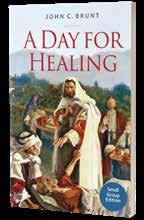
John Brunt examines these miracles with the intent of helping Sabbath keepers understand what Jesus was trying to teach us and demonstrating what the Sabbath is—and what it is not. Jesus, by word and action, demonstrates that salvation lies at the very core of the Sabbath. It is not a day for rules. Sabbath is a day when we receive God’s healing. But it’s even more than that. As we receive healing we are called to carry on the work of Jesus by offering the healing leaves of the tree of life to a hurting, desperate world.
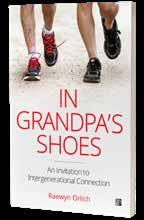
Raewyn Orlich shares how the example and encouragement of her grandfather influenced her life and calling. Weaving their stories together, each chapter looks honestly at topics like health, human suffering, race, gender, and faith. A Bible passage and reflection questions that can be used in intergenerational study groups are included at the end of each chapter. Previous small group participants describe the 13-week experience as “profoundly moving” and “inspirational.”
Gil Valentine traces in great detail how Church leaders (administrators and professors) dealt with urgent theological questions in the 1960s and 1970s.
Lowell Cooper, GC Vice President (2001-2016)
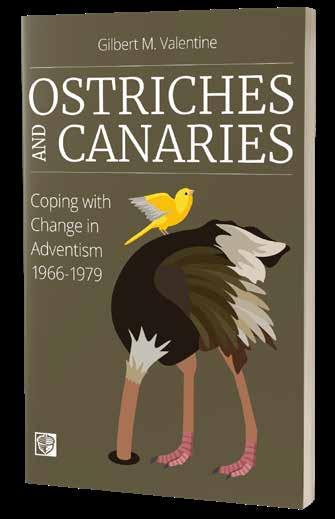
This is a book of crucial importance for all those seeking to understand current issues in the church, wherever readers happen to fall in the denomination’s continuum of thought.
George R. Knight, Professor of Church History Emeritus, Andrews University
These and other Oak & Acorn books are available on Amazon and AdventSource Oak & Acorn Publishing is a ministry of the Pacific Union Conference

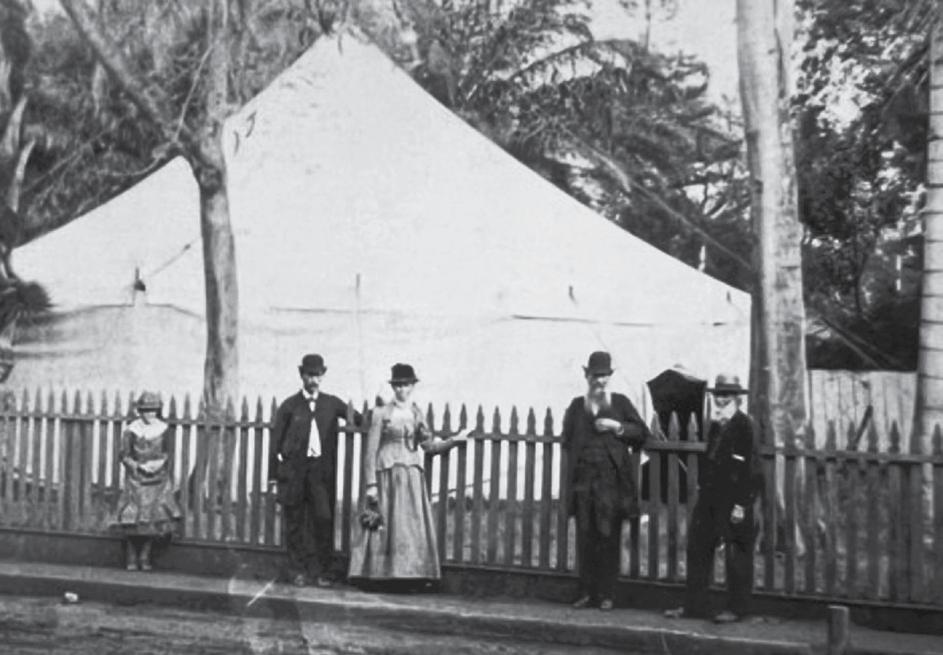
RIGHT: Chandler FilAm church in Phoenix.
FAR RIGHT: El Monte Vietnamese church.
BELOW: The Tract and Missionary Society in Honolulu, Hawaii, in 1885; Pastor La Rue is pictured standing in doorway, wearing a hat.
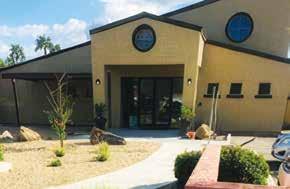
ABOVE: Photograph of the first evangelistic meeting held in Hawaii from January through March 1886. From left to right: Birdie Healey, William Healey, Clara Healey, Loran A. Scott, and Abram La Rue.


When a literature evangelist named Abram La Rue left California’s Gold Country in 1882 and sailed for Hong Kong, he probably did not imagine that his pamphlets would help shape a spiritual bridge stretching from Asia back to America’s Pacific states.
Yet more than a century later, Asian Seventh-day Adventist churches thrive in California, Nevada, Utah, Arizona, and Hawai‘i—living proof of Adventism’s global reach and its ability to adapt to migration, language, and culture.
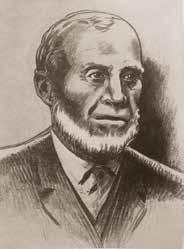
The earliest Adventist missionaries reached Honolulu in 1884. By 1888, a church had been organized, only to be disrupted when its leader was lost at sea. Undeterred, members reorganized in 1896. That small nucleus became the seedbed for ethnic ministries across the islands.
By 1940, a Japanese Adventist church had been planted in Mānoa Valley. Later decades added a Filipino church in Honolulu and even a Chinese Sabbath



School in the 1980s. Hawai‘i became a model of multiethnic ministry: one “mother” church in Honolulu serving as a nursery for Japanese, Filipino, Chinese, Samoan, and other congregations.
If Hawai‘i was the bridge, California was the generator. Immigrant streams converged here, and Adventist institutions—publishing, schools, hospitals—provided fertile ground.


Teruhiko Okohira, a student who joined Adventism in Paso Robles in 1892, returned to Japan with the gospel. That spark returned stateside in 1926 when Kinichi Nozaki organized the first Japanese Adventist church in Mountain View. West Los Angeles and San Francisco followed. World War II brought disruption as Japanese American Adventists were sent to incarceration camps. But congregations regrouped and endured, embodying what one pastor later called “prisoners of hope.”
In 1950, a Chinese church was organized in
• 1884 – First Adventist missionaries arrive in Honolulu, Hawai‘i
• 1896 – First Adventist church in Hawai‘i reorganized after a brief 1888 effort
• 1926 – First Japanese Adventist church in the U.S. (Mountain View, California)
• 1940 – Honolulu Japanese church organized in Mānoa Valley
• 1950 – San Francisco Chinese church organized
• 1957 – Central Filipino church organized in Wilmington, Los Angeles (first Filipino Adventist church in the U.S.)
• 1960 – Los Angeles Central Korean church organized (first Korean Adventist church in U.S.)
• 1978 – Loma Linda Filipino church organized, later growing to 1,000+ members
• 1985 – Honolulu Central fosters a Chinese Sabbath School
• 1988 – Alameda Chinese church organized in the Bay Area
• 1994 – El Monte Vietnamese church organized in Southern California
San Francisco—one of the first language-specific Adventist churches in the city. By 1988, another group launched in Alameda, and today multiple congregations continue to serve Bay Area families in their heart language.
On Sept. 21, 1957, the Central Filipino church was born in Wilmington, Los Angeles—the very first Filipino Adventist congregation in the United States. From this mother church, new plants spread: Glendale Filipino, celebrating its 50th anniversary in 2025, and the thriving Loma Linda Filipino church, organized in 1978 and now numbering over a thousand members.
Los Angeles Central Korean church, organized in 1960, was the first Korean Adventist church in America. It later sprouted ministries for secondgeneration youth, blending Korean tradition with English-language worship.
California’s Filipino, Korean, Chinese, and Japanese congregations reflect the larger story of immigration to the state since 1945—and the Adventist instinct to plant language-specific ministries.
The story of Vietnamese Seventh-day Adventists


in California begins in the aftermath of the Vietnam War. When large numbers of Vietnamese refugees arrived in the United States in the mid- to late-1970s, many settled in California, especially in Orange County, San Jose, and the Bay Area. Among them were a handful of Adventists who brought their faith with them, seeking community and continuity in a new land.
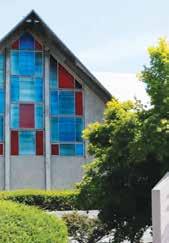
In Arizona, Adventists first organized in Phoenix in 1890. While early work centered on Anglo and Hispanic communities, Filipino Adventists later brought new vitality. Churches like Chandler Fil-Am in the Phoenix metro area embody the Filipino presence in Arizona’s healthcare and technology workforce.
In Nevada and Utah, Asian Adventists have never been numerous, but they have been significant.
Salt Lake City’s Central church (later Wasatch Hills) once served as the regional hub, and Las Vegas’s growing service economy drew Filipino Adventists who strengthened local congregations. Here, ethnic members often integrate into multiethnic churches rather than maintaining large stand-alone congregations, but their influence remains visible.
Several threads run across this history: Early Adventism in Japan, Korea, China, and the Philippines created faith lineages that re-emerged in U.S. immigrant communities. From Japanese
Hoffman (pictured here with his family) and Kinichi Nozaki held a series of meetings for the Pacific Union Conference in Northern California. Hoffman believed that the services at Mountain View—given by him and Nozaki in Japanese—generated “an interest manifested among the Japanese people” that he had never seen “in all his experience.”1


in Honolulu to Korean in Los Angeles, Adventists consistently planted mother-tongue congregations. Filipino Adventists clustered near Loma Linda because of its hospital; Chinese and Korean groups formed around Bay Area campuses and medical centers. Japanese American Adventists endured wartime incarceration and rebuilt after 1945.
Honolulu Central and other hubs nurtured multiple ethnic ministries under one roof, pointing toward a shared, multi-cultural Adventism.
Today, Asian Adventist congregations across the Pacific Union and the desert Southwest face the challenge of bridging generations. First-generation immigrants cherish worship in Tagalog, Korean, Chinese, or Japanese; their children lean toward English. Many churches now run parallel services or multi-ministry models under one roof.

Yet the heartbeat is unchanged: Sabbath hope, Christ’s soon return, and a gospel made real in neighborhoods from Honolulu to San Francisco, Los Angeles to Phoenix, Salt Lake City to Las Vegas. What began with a sailorcolporteur in the 1880s has become a living mosaic—an Asian Adventism firmly rooted in American soil yet forever connected to its Pacific homelands.
1“California: The Japanese Work,” Pacific Union Recorder, April 1, 1926.
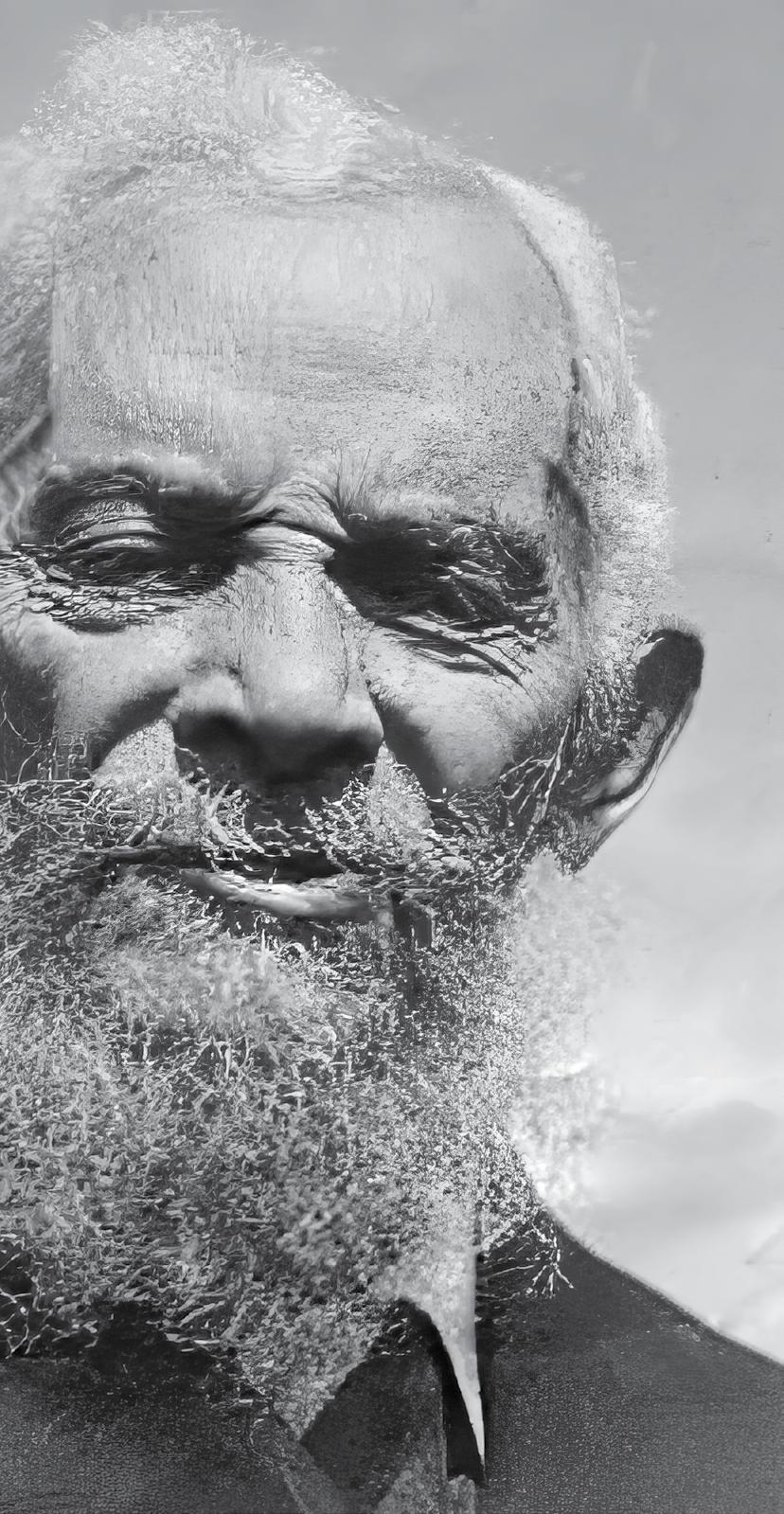
A significant “first”
While much of the early work among African Americans was obviously conducted in the South, the West can lay claim to some significant events.
When J.N. Loughborough was invited to hold meetings in Reno, Nevada, he could not have foreseen that he would have a role in changing the life of Charles M. Kinny, sometimes referred to as the father of Black Adventism.
Kinny was baptized in Reno in 1878. He had been born a slave in Richmond, Virginia, in 1855. He had gradually worked his way west, ending up in Reno. There he attended Loughborough’s evangelistic series and also heard Ellen G. White when she preached there. She wrote about the event: “We had an appointment to speak Tuesday evening in the tent in which Elder Loughborough was giving a course of lectures. I spoke with freedom to about four hundred attentive hearers, on the words of John: ‘Behold, what manner of love the Father hath bestowed upon us, that we should be called the sons of God’” (Ellen G. White, Church, vol. 4, p. 296).
The Lord has given us light concerning all such matters. There are principles laid down in His Word that should guide us in dealing with
Charles M. Kinny


One of those 400 “attentive hearers” was Kinny. He became convinced of the truth and was baptized. Kinny was then sponsored by the Reno church to study at Healdsburg College (now Pacific Union College), and he became the first African American pastor to be ordained in the Adventist church. He worked initially in Kansas and then throughout the South, with great success.
In 1891 Ellen White delivered a historic presentation entitled “Our Duty to the Colored People.” In this speech to 30 church leaders at the General Conference session, she laid out both a clear Biblical foundation and practice for the work among African Americans. The speech begins:
There has been much perplexity as to how our laborers in the south shall deal with the “color

line.” It has been a question to some how far to concede to the prevailing prejudice against the colored people. The Lord has given us light concerning all such matters. There are principles laid down in His Word that should guide us in dealing with these perplexing questions. The Lord Jesus came to our world to save men and women of all nationalities. He died just as much for the colored people as for the white race. Jesus came to shed light over the whole world. At the beginning of His ministry He declared His mission: “The spirit of the Lord is upon me, because he hath anointed me to preach the gospel to the poor; he hath sent me to heal the brokenhearted, to preach deliverance to the captives, and recovering of sight to the blind, to set at liberty them that are bruised, to preach the acceptable year of the Lord” (Ellen G. White, The Southern Work, p. 9).
It was this conviction that led her son James Edson White to work in the South, aboard the Morning Star steamboat.
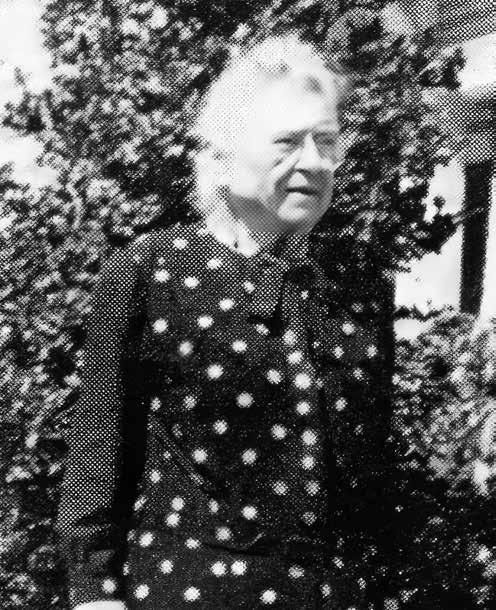
Jennie Ireland, c. 1958. From Review and Herald, April 17, 1958.
This recognition of the importance of such work led to many churches being organized, including the first African American congregation in the West. The Furlong Track church organized in Los Angeles in 1908 with an initial membership of 23. This was the result of the work of Jennie Ireland, a nurse who had graduated from Battle Creek Sanitarium. She began doing medical missionary work among the African American population in Los Angeles. The first African American full-time employee was Amy Temple, a Bible instructor.
In 1922 Owen Troy followed Jennie Ireland’s example of setting up clinics and arranging health and cooking classes and first-aid demonstrations. Coupled with in-depth Bible studies, Troy was an effective evangelist. He was also instrumental in establishing the Sweet Chariot Hour radio broadcast from Pasadena, California, in 1939.
In 1923 P.G. Rodgers came to Los Angeles to take over the work started by Jennie Ireland. He began a significant ministry that involved pitching a tent on Central Avenue and holding a three-month series throughout the summer. (See story on pp. 22-27.) His ministry produced good results and the membership outgrew their Furlong church, necessitating a move to larger premises.
A founding member of the Furlong church was Ruth Temple, who moved to Los Angeles in 1902. Temple started studying at the College of Medical Evangelists (later Loma Linda University) in 1913. She was the first African American to graduate from the institution when she received her M.D. in 1918. She then began an internship in 1921 at the Los Angeles City Health Department, specializing in obstetrics and gynecology. In 1928 she and her husband, Otis Banks, turned their home into a free health clinic, serving the underprivileged in the area since there were no other clinics at that time. In 1948 Ruth was appointed director of the Division of Public Health for Los Angeles City, and she worked there in various capacities until her retirement.
In the post-war years, when regional conferences were being developed elsewhere in the U.S.,
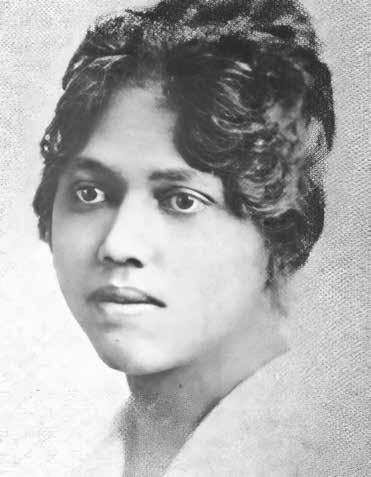

Dr. Temple administers vaccine. Looking on is Dr. Owen A. Troy (left), president of the Community Health Association. (Photo courtesy of Dr. Carmelita Troy).
as Louis B. Reynolds writes, “The Pacific Union Conference and the local conferences that it comprises have exhibited a certain awareness of social change in the sixties and seventies and put forth some effort to keep pace. In 1945 and beyond, when regional conferences became a reality in the East and Midwest, the approximately 1,500 blacks and the sixteen conference workers who made up the regional department's constituency of Pacific Union Conference felt that the two major groups could work well together and that a certain posture of integration would take hold in the West.”1
1Louis B. Reynolds, We Have Tomorrow: The Story of American Seventh-day Adventists With an African Heritage (Washington, DC: Review and Herald Pub. Assn., 1984), p. 186.

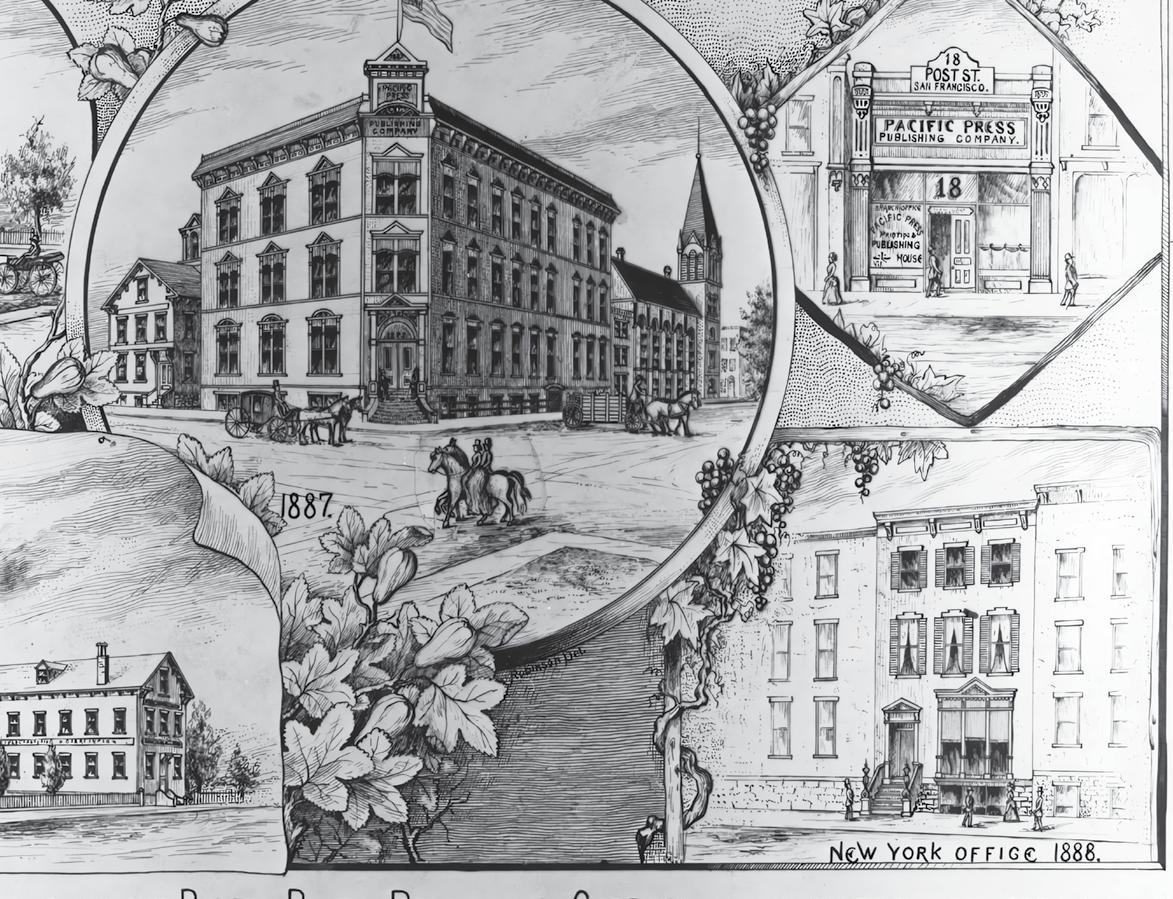


The history of the publishing work in the West and that of Pacific Press go hand in hand. When James and Ellen White came west for the second time in 1874, it was clear that printed materials were needed to share the Adventist message, just as they had been when the movement started back East. In fact, it was very much a situation of déja vu that faced the small group of believers on the Pacific coast. James White did what he had done 25 years before in Connecticut—he issued a paper.
The first issue of The Signs of the Times was printed in Oakland on June 4, 1874. The publishing work in the West had begun, but much more was needed. Ellen White was convinced that Oakland was the place to set up a press, and so land was purchased and a building erected in 1875.
The Whites were so dedicated to making sure the work progressed that they cut their ties with the East to fund the building of the press and churches in the West. “My husband and I decided to sell our property in Battle Creek, that we might use the proceeds in this work. We wrote to our brethren, ‘Sell everything

we have in Battle Creek, and send us the money at once.’ This was done, and we helped to build the churches in Oakland and San Francisco.”1
Not only was Signs started but Pacific Press incorporated so that it could print all the other necessary literature. John Loughborough records it precisely:
April 1, 1875, the Pacific Seventh-day Adventist Publishing Association was formed in Oakland, its capital stock being fixed at $28,000. The central portion of the lots on Castro St. was, according to agreement, deeded over to the association, and a building was at once constructed by O. B. Jones, of Battle Creek, Mich., the form and size of which was the same as that of the office erected in Battle Creek, except that the one in Oakland was constructed of wood instead of brick. This building being ready for occupancy, the Signs of the Times was moved into its new quarters on Friday, Aug. 27, 1875.2
These actions by the Whites made their intentions very plain—they were concentrating their efforts in
The investment paid off. Within a year, the number of subscribers to The Signs of the Times had reached 4,000.


the West where they saw great possibilities. With the later fire at the Review and Herald Press and the loss of Battle Creek Sanitarium, such an initiative and diversification was wise, and it also demonstrated the White’s recognition of how the church could be “reinvented” in the West.
The investment paid off. Within a year, the number of subscribers to The Signs of the Times had reached 4,000. A wide variety of books and tracts were also printed for use by the growing membership, while some commercial printing was also done. After two years, another building was constructed on an adjacent lot, making Pacific Press the largest and best equipped printing faculty in the West.
Eight years after its founding, Pacific Press had nine cylinders and three job presses, representing an investment $200,000. Annual gross business was $150,000 and 125 persons were employed. In 1904, Pacific Press moved to a new facility in Mountain View since the Oakland location had become crowded and real estate was expensive. Though the new building was damaged by the 1906 San Francisco earthquake, repairs were made and production continued. In 1984 the press relocated to Nampa, Idaho, due to the high cost of operating in Mountain View.
James White was editor of The Signs of the Times from 1874 until just prior to his death in 1881. He also held other positions at the press, demonstrating his firm belief in publishing as a major component of spreading the Adventist message.
Ellen White was a great defender of Pacific Press’ independence. She wrote to “the brethren” on several occasions to ensure that the publishing work in the West was not taken over by those back East: Let the B. C. [Battle Creek] publishing house and the Pacific Press regard each other as sister institutions. In cooperation they can exert a healthful influence upon each other, but not in consolidation. These institutions are not to become merged into one. The managers in Battle Creek have indulged unchristian, unbrotherly feelings, even envy and jealousy, toward the Pacific publishing house. They have had a feverish desire to belittle that institution, and to bring it under their own jurisdiction, but the light that I have had for years is that these institutions must stand separate, each preserving its own individuality. A nearer relation than this will tend to the injury of both.3
The productions of Pacific Press include such

periodicals as: Signs of the Times (since 1874); The Pacific Health Journal and Temperance Advocate (1885–1905); The American Sentinel (1886–1900) and its successor The Sentinel of Christian Liberty (1901–1903); Our Little Friend (since 1890); Primary Treasure (since 1957); Primary Sabbath School Lesson Exercises (1953–1984); Listen, A Journal of Better Living (1948–1994); Health (1934–1948); Present Truth (1948–1955); My Bible Story (1946–1956); Sabbath School Lesson Quarterly (since 1895); Primary Sabbath School Lesson Quarterly (since 1935); The Sabbath School Worker (1890–1901); Alert (1950–1971); Smoke Signals (1955–1979); and Israelite (1954–1982). El Centinela, the Spanish magazine equivalent to Signs of the Times, has been published since 1919.
Books have included a series of children’s books, Golden Grains, Sabbath Readings, Story of Pitcairn Island, Story of Redemption, Heralds of the Morning, Testimonies for the Church, The Desire of Ages, The Great Controversy, Prophets and Kings, a series of small books called “The Young People’s Library,” The Place of the Bible in Education, Empires of the Bible, The Great Empires of Prophecy, Ecclesiastical Empires, and Great Nations of Today, along with textbooks for use in Adventist elementary schools and academies. Titles from Pacific Press include theological works

as well as books on topics such as health, family, and Christian living. Their printing plant produces the Recorder for the Pacific Union every month.
1Ellen G. White, “The Judgments of God on Our Cities,” Review and Herald (July 5, 1906).
2J.N. Loughborough, The Great Second Advent Movement: Its Rise and Progress (Washington, DC: Review and Herald Pub. Assn., 1909), p. 292.
3Ellen G. White, The Publishing Ministry (Hagerstown, MD: Review and Herald Pub. Assn., 1983), p. 158, from Manuscript 31, 1895.
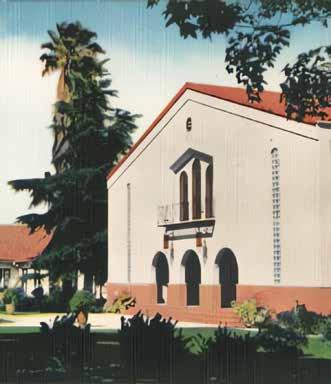
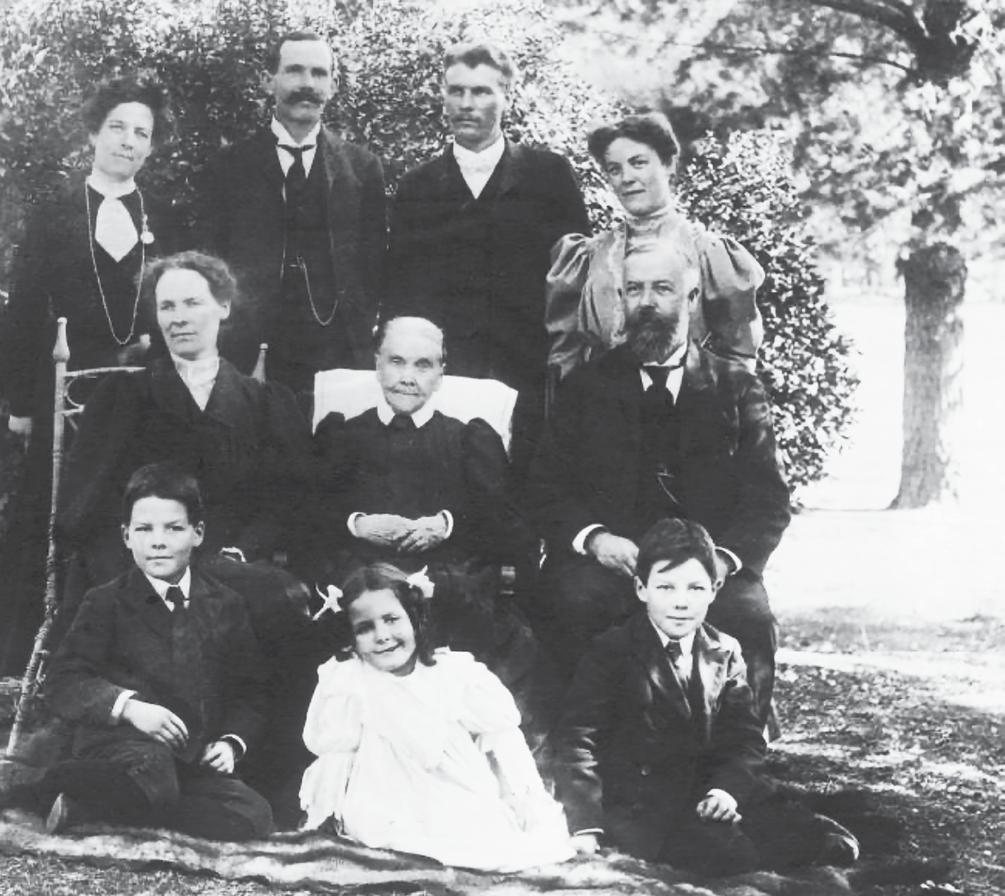
Ellen White (seated center), with her family in Elmshaven, California, 1907. Front row: Henry, Gracie, and Herbert. Seated: Mrs. W.C. White, Mrs. E.G. White, Elder W.C. White. Standing: Ella M. Robinson, D.E. Robinson, W.D. Workman, Mabel E. Workman.
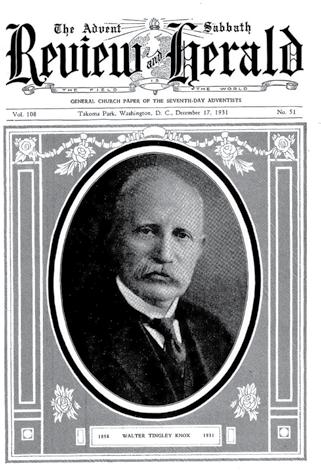
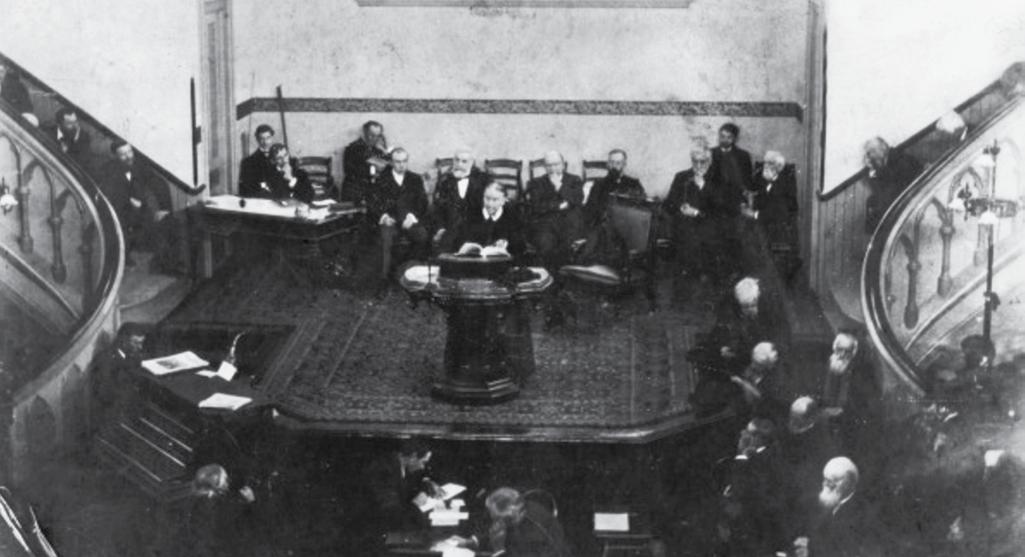
While Adventism in the West was already showing a distinctive character that embraced new methodologies, it was the increasingly cumbersome church structure that needed change.
In 1900, Ellen White returned to California from Australia and found a home at Elmshaven, just outside of St. Helena and down the hill from the Sanitarium. While Elmshaven would become her home for the rest of her life—the place where she prepared some of her most popular and important books and wrote hundreds of articles and messages—it was also here that plans were made for a new church structure.
That she had recently been in Australia had highlighted many of the problems. A long way from Battle Creek headquarters, it could take months for important letters to go back and forth between Australia and the U.S. Sometimes instant decisions were needed locally, but with authority vested in the General Conference this was impossible. Consequently, leaders in Australia had started experimenting with a more distributed system of church organization that did not require all decisions to be taken by a central body located thousands of miles away.
Until 1901, all Seventh-day Adventist churches in the world were administered by local conferences (as now), and all the conferences in the world were administered by the General Conference, then headquartered in Battle Creek, Michigan. But in her opening address to the delegates at the General

Conference session in Battle Creek, April 2-23, 1901, Ellen White pled vigorously for a completely new church organization that would dramatically diminish what she called the “kingly power” of the leaders in Battle Creek and transfer that power to leaders closer to the local level.
As part of the resulting reorganization of 1901, local church conferences were grouped into union conferences. After April 1901, the local conferences would deal with union leaders, not with General Conference leaders. This enabled local churches, schools, and missions to receive much quicker responses when they needed support or approvals, it created a mechanism for world policies to be

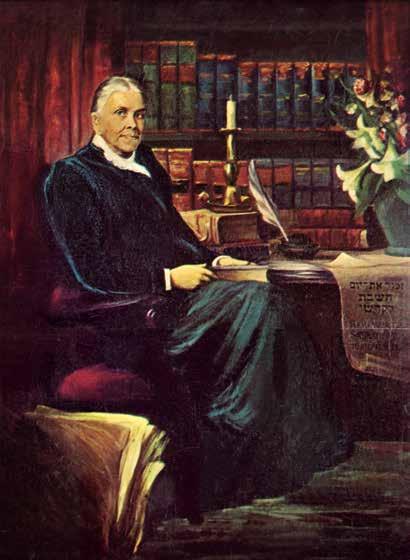
adapted to local structures, and it created a wide base of representatives to participate in world church decisions—union presidents from around the world. In the 21st century, the union presidents remain the most influential decision-makers in the worldwide church.
According to the "Constitution of the Pacific Union Conference," which was published in the very first Pacific Union Recorder (dated Aug. 1, 1901, subscription rate: 50 cents annually), “This

Conference shall comprise the states of California, Oregon, Washington, Idaho, Montana, Utah, and Nevada, the Province of British Columbia, the Territory of Alaska, and such other territory as may hereafter come under its supervision” (p. 4). The Arizona and Hawaii territories were also assigned to the Pacific Union by the General Conference.
While this rearrangement may appear to be only of interest to church historians, its impact is still with us today. Not only did it form the system of church governance that we still have, it demonstrated a commitment to the importance of local decision-making over a centralized bureaucracy that hampered the church’s mission. In particular Ellen White warned about the consolidation of power in the hands of a few men as being contrary to God’s will:

“I was told that I must lift my voice in warning against this.... We were not to be guided by men who want their word to be the controlling power. The development of the desire to control has been very marked, and God sent warning after warning, forbidding confederacies and consolidation” (Pacific Union Recorder 3, no. 8, [Nov. 19, 1903], p. 2).
“It has been a necessity to organize union conferences, that the General Conference shall not exercise dictation over all the separate conferences” (Christian Leadership, p. 26).
“The division of the General Conference into
The creation of the Pacific Union Conference in 1901 brought many important aspects of the work under local control.
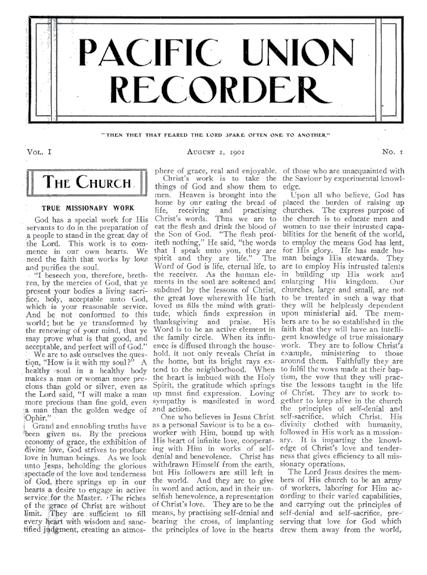
District Union Conferences was God's arrangement. In the work of the Lord for these last days there should be no Jerusalem centers, no kingly power. And the work in the different countries is not to be bound by contracts to the work centering in Battle Creek, for this is not God's plan.... The kingly power formerly revealed in the General Conference at Battle Creek is not to be perpetuated” (Principles for Christian Leaders, p. 108).

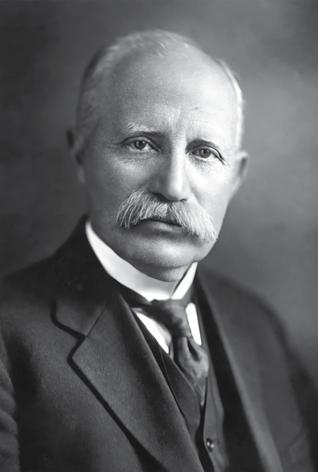
Her conclusion after the reorganization was, “At the last General Conference [1901] the work of organizing union conferences was well begun. This work, carried forward till a thorough and efficient organization is perfected, will prove a great blessing” (Pacific Union Recorder 1, no. 5, [Sept. 26, 1901], p. 1).
The creation of the Pacific Union Conference in 1901 brought many important aspects of the work

under local control. This provided the opportunity for creative ministries and innovative evangelism—as has been shown iarticles that are printed in this special edition of the Recorder The West became an important “test bed” for new approaches and programs, not limited to direct outreach but also including medical work, health promotion, community service, education at all levels—and later, media ministries such as radio programs and TV broadcasts.
It is not an exaggeration to say that because of the wisdom of decentralizing the church’s structure, many important experiments involving the church and its activities became possible, with the Pacific Union being very much an integral part of such innovations. Today the Pacific Union continues to hold this philosophy in helping to develop new ways of outreach and service to the many communities that make up this leading area of God’s work.



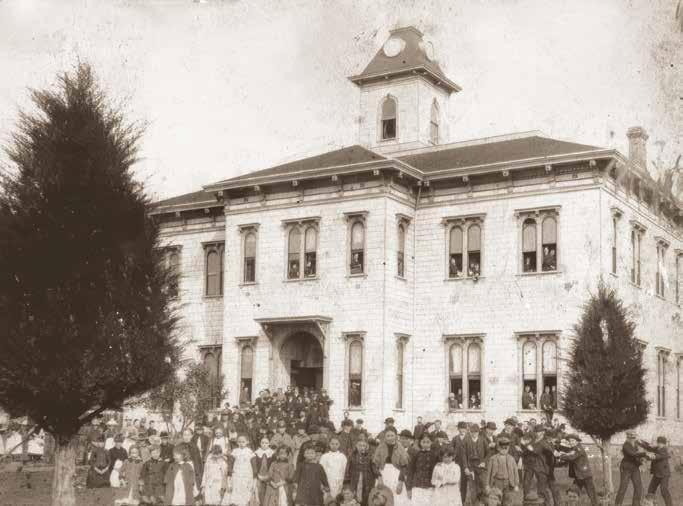
Healdsburg College, 1887.
John Burden became an Adventist at age 13. He attended Healdsburg College, where he met Eleanor Baxter. They married in 1888 while working at the Rural Health Retreat (later St. Helena Sanitarium; now Adventist Health St. Helena). Burden became manager of the institution in 1891.
In 1901 Eleanor and John Burden went to Australia, following in the footsteps of Ellen White, who had returned to the U.S. the previous year. There they helped Merritt Kellogg start the Sydney Sanitarium. They returned to the U.S. in 1904 and followed Ellen White’s advice not to join John Harvey Kellogg in Battle Creek. Instead they went to California, where John was instrumental in establishing the Glendale Sanitarium. He became the manager, and his wife was the accountant.
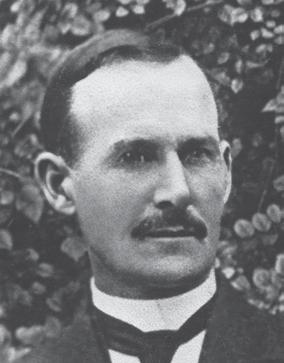

While Ellen White had helped purchase another sanitarium (Paradise Valley), she still wanted to do more in terms of health evangelism. After the loss of Battle Creek Sanitarium in the East, Ellen White was doing all she could to rebuild the church’s health ministry in the West. So she instructed Burden to search the Redlands-Riverside area for a property she had seen in vision.
In March 1904 Burden found a resort hotel in Loma Linda, but at $110,000 the price was exorbitant. However, due to the failure of the proprietors’ plans, the asking price dropped over time to $40,000,
and Ellen White urged Burden to go ahead with the purchase. The property consisted of the furnished hotel building, an amusement building, five cottages, a farmhouse, farm implements, horses, carriages, and cows on a 76-acre tract.
Ellen White was very interested in acquiring the property and asked Burden to keep her updated on progress. He soon sent her a message saying that they had to proceed immediately as the owners were anxious to sell and others were interested. She wrote back, “Go ahead.... I am well satisfied the place is one we ought to have. It is cheap at $40,000. We will not leave you, but will stand back of you, and help you to raise the means.”1
Church administrators were not convinced however, so they sent Burden a telegram stating that he should not proceed. Ellen White also sent a telegram, telling him to “secure the property by all means…without spending time to ask the advice of the brethren.” Burden went ahead.
Even so, it was not an easy process. The first installment was made, but on the day the second installment was due, no money was available. It was only through an amazing chain of events that the money was found. Burden writes:
At last the day arrived [for the second payment], and the forenoon found the

members of the Conference Committee in session in Los Angeles in deep perplexity. It was natural that some who had from the first felt it unwise to accept the great responsibility should feel that these circumstances justified their misgivings. In the face of the humiliating necessity, as it seemed, of losing the property, it was easy and natural to blame and censure those who had pressed the matter through against what appeared to be sound reason and judgment.... Soon after this the postman was heard coming up the stairs. He opened the door and delivered the mail. Among the letters was one bearing the postmark ‘Atlantic City, New Jersey.’ The letter was opened, and it was found to contain a draft for $5,000, just the amount needed for the payment.2

showed a gain of $1,100.”3
Loma Linda was to be far more than just another sanitarium. It was to be a place of training, and not just in the medical field. Ellen White saw this as a place where doctors and pastors could be trained together for their mutual benefit. However, this did not develop as she wanted.
Nonetheless, in due course the College of Medical

John Allen Burden and Eleanor (Baxter) Burden
Eventually the whole purchase was made, and the property secured for the church. Burden was appointed manager of the new facility. The staff were dedicated to the cause: “Shortly after the sanitarium opened, the income from the patients failed to meet the expenses, and these workers volunteered their services for room and board until in a short time the patronage increased. By Christmastime there were thirty-five patients. At the end of the first year the balance sheet


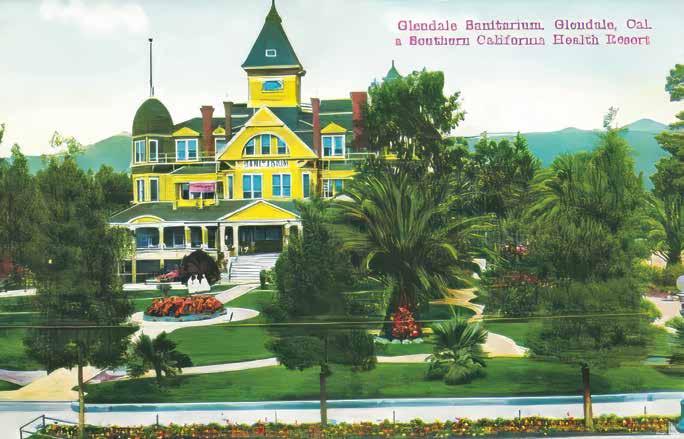
Evangelists was established, which eventually led to the Loma Linda University School of Medicine.
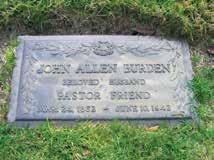
Ellen White wrote to Burden frequently, encouraging him in his work. She also stood up for him, putting others in their place when necessary, including one conference president, arguing that Burden should be allowed to fulfill his calling:
“The Lord has blessed Elder Burden, and He will continue to bless him, as he continues to move in the fear of God, and plans wisely and economically with
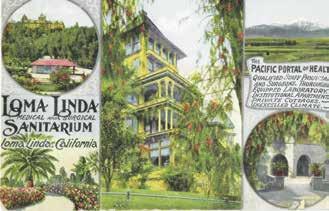

his associates for the fitting up and management of the institution. If any of his brethren act arbitrarily in an effort to restrain him in this, they would be hindering the very work that the Lord has signified should be done. He is not to be forced to turn aside from his convictions as to the way in which the work under his charge shall be carried on.”4
Burden continued at Loma Linda until 1915, when he and his wife moved to Paradise Valley Sanitarium. He retired after his wife’s death in 1933, but in 1939 he returned to Loma Linda to serve as chaplain until his death in 1942.

1Harold Oliver McCumber, Pioneering the Message in the Golden West (Mountain View, CA: Pacific Press Pub. Assn., 1946), p. 200.
2McCumber, Pioneering the Message, pp. 204-205.
3McCumber, Pioneering the Message, p. 112.
4Ellen G. White, Loma Linda Messages (Payson, AZ: Leaves-of-Autumn Books, 1981), p. 182.

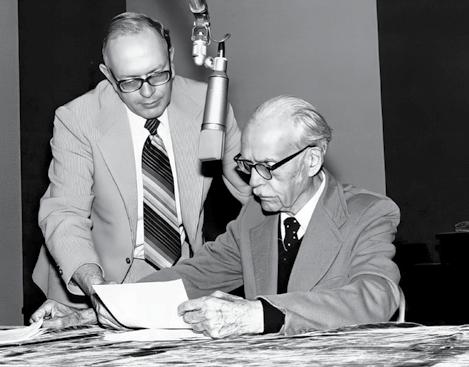

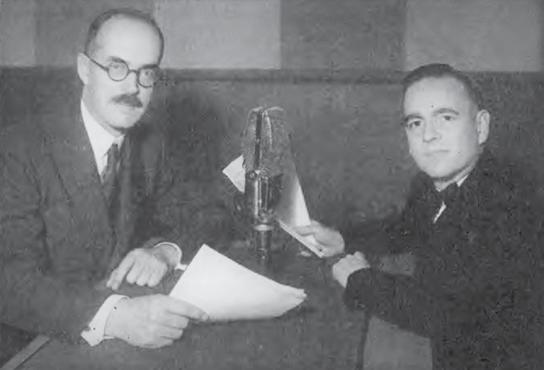
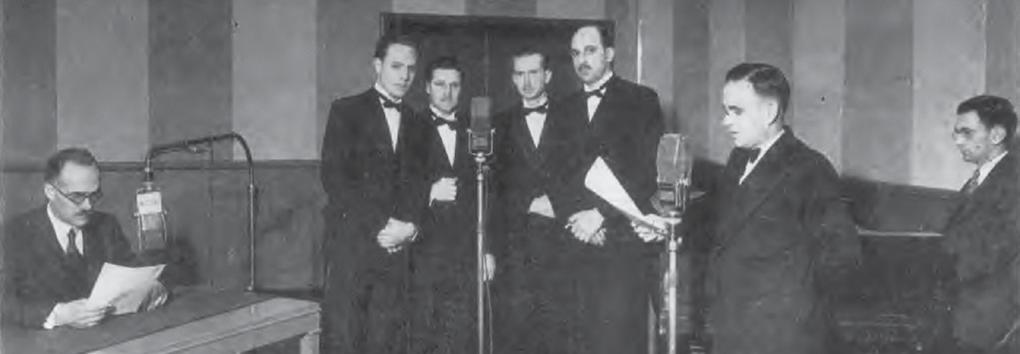
Harold Marshall Sylvester Richards (18941985) was born in Davis City, Iowa, the son and grandson of gospel ministers. Already a successful evangelist, he was ordained in 1918 while still attending Washington Missionary College. He was continuing his evangelistic ministry in Montreal, Canada, when he received a call to teach evangelism at Union College. The president, W.W. Prescott, even came in person to make sure he accepted the call!
Richards was torn. “For three or four days I couldn't eat, couldn't sleep. It got worse and worse,” he wrote. “Finally, up in the attic of the church there in Westmount, Montreal, I fought the thing out in prayer, and the decision was just as clear as it could be I couldn't do it. God had something else for me.”1
This “something else” was to become the Adventist pioneer in radio evangelism. Called to work in California in 1926, he conducted evangelistic meetings in Fresno, Bakersfield, Lodi, Los Angeles, Long Beach, and San Diego. In the meantime, he had already begun to think about using radio as a means of spreading the gospel, but it wasn’t until 1929 that he began broadcasting over KNX-AM radio in Los Angeles.
While conducting an evangelistic series in


Huntington Beach, his daily sermons were aired over KGER in Long Beach, on a program he called The Tabernacle of the Air. He also broadcast weekly over KMPC in Beverly Hills. His home studio was a converted chicken coop behind his garage!
By 1937, Richards’ live broadcasts were being aired over several stations, and the name was changed to The Voice of Prophecy. A trailblazer in so many ways, Richards found little support for his dream among church administrators and so chose to continue his ministry through voluntary donations. His conviction that new technology should be used to share the good news exemplifies the spirit of the West, where most of the church’s media ministries have their origins.
“Finally, up in the attic of the church there in Westmount, Montreal, I fought the thing out in prayer, and the decision was just as clear as it could be I couldn't do it. God had something else for me.”
Opposition from church leaders—some who condemned radio as “of the devil,” misquoting Paul’s words about the “prince of the power of the air”—did not faze Richards, even when his radio broadcast was banned in several conferences.
Richards pointed to the very first coast-to-coast Adventist radio broadcast as one of his greatest thrills in ministry. The message was carried by 89 stations of the Mutual Broadcasting System. This led to greater acceptance of his methods by church leaders, who in 1943 inaugurated an annual Voice of Prophecy Day that collected offerings from churches across North America.
Later the Review and Herald reported:
But not until January 4, 1942, did listeners from coast to coast hear the broadcast. That Sunday evening came exactly four weeks after the attack on Pearl Harbor. If the contract for time on 89 stations had not been signed prior to that dark day in American history, expansion of the Seventh-day Adventist radio ministry might have been delayed for years. It could well have been argued that it wasn't logical to commit a large amount of money to such a venture with the future so uncertain.
But Elder Richards and his associate speaker, Fordyce Detamore, moved forward in faith, believing that God wanted His Word to be heard in homes across the land. And if God was leading in expanding the radio outreach, then He would supply the funds to make it possible.
On February 1, 1942, four weeks after the first coast-to-coast broadcast, Elder Detamore announced to listeners that a Bible correspondence course was ready for mailing. Response was immediate; within five months enrollments topped 27,000. By September they had passed 60,000. With the addition of dozens of new stations the next month, radio broadcasts—and offers for the free course—went
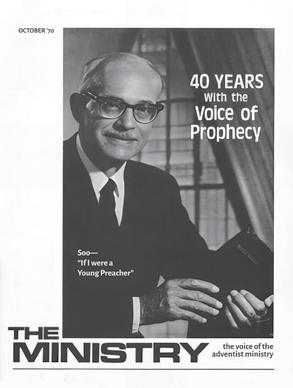

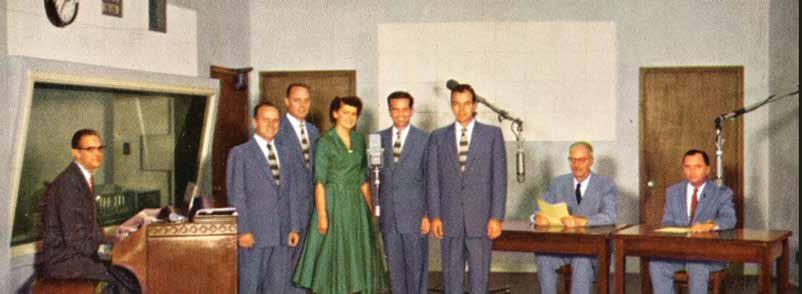


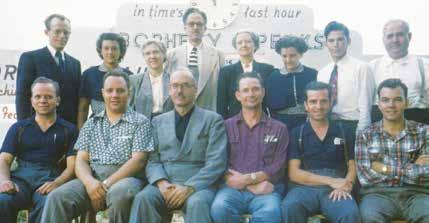
out live on 225 stations every Sunday evening. Enrollments soared again.2
This Bible Correspondence School developed into a major evangelistic tool for the church. By 1952, the Voice of Prophecy was operating 69 Bible correspondence schools and broadcasting over more than 700 stations around the world.
It’s inspiring to think of what was achieved by one dedicated Christian who chose to follow the Lord’s leading and experiment with a new avenue for sharing the good news—a tribute to all those who helped him achieve his dream in the West. For while this was a new medium for the message, for Richards it was still biblical preaching. He wrote:
There may be speakers who interest people, who dazzle them with oratorical fireworks, who philosophize and propound intricate speculations; but this is not preaching, because it is not truth. True preaching must have a true man behind it. True preaching always involved both a personality and truth; and there is a third element—it must be scriptural truth. So Jesus preached. He was a true man, the Son of man; He preached truth, God's truth; and it was from Scripture.3
Richards concluded: When we preach we need to preach for action, for a decision at that moment and in
that place. We need preaching like that of the apostles on the day of Pentecost, when the hearers were so stirred in their hearts that they said, "Men and brethren, what shall we do?" (Acts 2:37).
So living and so speaking that the church is built up and sinners are converted to God—that is preaching!4
1O.M. Berg, “H.M.S. Richards: Committed Evangelistic Preacher,” The Ministry 43, no. 10 (Oct. 1970), p. 6.
2Eldyn Karr, “The Golden Voice,” Review and Herald 169, no. 7 (Feb. 13, 1992), pp. 11-12.
3H.M.S. Richards, “What Is Preaching?” The Ministry 30, no. 9 (Sept. 1957), p. 5.
4H.M.S. Richards, “What Is Preaching?” p. 7.
BELOW: Voice of Prophecy headquarters, Glendale, CA.
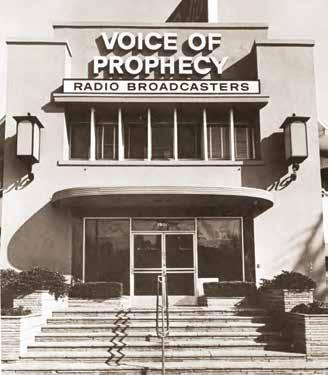


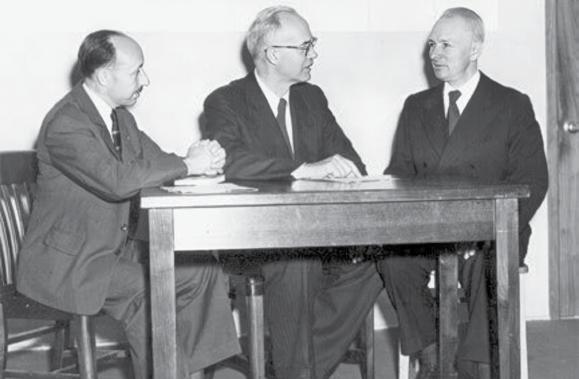


Braulio Francisco Pérez Marcio
was a pastor, educator, lecturer, writer, poet, and the founder and director of the Adventist international radio program Voice of Prophecy in Spanish for over 30 years. He was born March 26, 1904, in Morille, Salamanca, Spain. His father, Manuel Francisco Pérez, served in the military in Cuba and later returned to Spain, marrying Camila Marcio in 1902. In 1906 or 1907, Manuel emigrated to Argentina, followed by his family. They had four children: Braulio, Felipe, Manuel, and Isabel (who died young).

In 1921, Camila encountered Adventism through Bible meetings held by neighbors in Buenos Aires. These meetings deeply moved her. At the time, Manuel was an agnostic, and Braulio, a studious and skeptical 17-year-old, worked humble jobs, including cleaning, running errands, and drugstore duties. Though initially uninterested, Braulio began attending church with his family. There, he was impressed by Marcelo I. Fayard’s preaching. Invited to study the Bible, Braulio soon embraced Christianity. Around the same time, missionary Ole Oppegard lent Manuel The Great Controversy, which he read avidly. In 1921, Manuel and Braulio were baptized, followed by Camila and the other children. To observe the Sabbath, Manuel left his job and began selling Adventist literature; Braulio joined him for three years.

At age 21, Braulio enrolled in River Plate Academy in Entre Ríos, Argentina. He worked as a proofreader and canvassed during the summers. As editor and later director of La Voz del Colegio, his writing began to flourish. He also wrote poetry, composing “Excelsior” for his graduation in 1930.
Felisa Juana García, Braulio’s future wife, was born in Cáceres, Spain, in 1908. Her family moved to Argentina between 1912 and 1920. Sotero, Felisa’s father, discovered Adventism through literature and canvassers. In 1924, the family relocated to Buenos Aires and joined the Adventist Church. Felisa and her sister Sotera studied at River Plate Academy. Sotera married Héctor J. Peverini, and their son was Milton Peverini García, Braulio’s eventual successor on La Voz de la Esperanza.
Braulio and Felisa met at River Plate Academy and married Jan. 19, 1931. Between 1931 and 1935, Braulio served as dean of the boys’ dorm and taught history, Bible, Spanish, and literature. In 1936, they moved to Costa Rica, where Braulio taught languages and literature and Felisa started a primary school. Braulio also launched a radio program and held evangelistic conferences. Their daughter, Eunice Isabel, was born in 1937. In 1939, Braulio was called to Panama as a pastor and evangelist

and was ordained in 1940. That same year he moved to Cuba, conducting conferences and launching a radio Bible school that offered lessons he prepared.
Meanwhile, in Los Angeles, H.M.S. Richards had pioneered Adventist radio broadcasting in 1929, which became the Voice of Prophecy in 1937. In 1942, the General Conference decided to create a Spanishlanguage version. On Sept. 6, 1942, Braulio was appointed the lecturer. The Spanish program began airing Jan. 3, 1943, initially with translated content. Braulio adapted the material to better connect with Latin audiences, adding illustrations and poetry. Within a few years, he was creating original messages. The King’s Heralds sang in Spanish for the programs, with Braulio training them in pronunciation. Initially titled La Voz de la Profecía , the broadcast was renamed La Voz de la Esperanza in 1954. The program lasted 30 minutes and included a postal Bible school with courses for adults, youth, and children. Church members served as missionary mail carriers, delivering and collecting lessons each week.
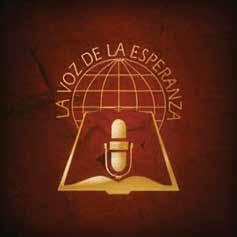
Argentina but traveled annually to Glendale, California, to record programs and manage operations. In 1946, his son Rolando Ariel was born. By 1957, Braulio and Los Heraldos del Rey began international tours across Latin America. They visited Puerto Rico, the Dominican Republic, Cuba, Costa Rica, Guatemala, Mexico, Brazil, Bolivia, Peru, Chile, and Argentina, filling large venues with eager listeners. Braulio’s eloquence opened doors to meet national leaders, including the presidents of Costa Rica, Guatemala, and the Dominican Republic. He was well received in diverse circles.

Between 1945 and 1948, Braulio lived in


In 1955, Braulio launched the hymnal Buenas Nuevas de la Voz de la Esperanza (Good News of Voice of Hope). He also wrote numerous books and pamphlets, including Vislumbres de Esperanza (Glimpses of Hope), Cuando la Vida Duele (When Life Hurts), Perfiles del Nazareno (Profiles of the Nazarene), En la Roma de los Césares (In the Rome of the Caesars), and Filosofía del Dolor y Libertad del Temor (Philosophy of Pain and Freedom from Fear), the latter co-authored with Héctor Pereyra Suárez and Fernando Chaij. Braulio traveled extensively in Europe, the Far East, and the Middle East, enriching his presentations with insights from these journeys.
During his decades on air, Braulio recorded 1,467 radio messages. He directed evangelistic campaigns across Latin America, contributing to an estimated 40,000 baptisms. In 1970, Andrews University recognized his lifelong contribution by awarding him an honorary Doctor of Letters. By then, he was the most renowned Spanish-speaking Adventist preacher, having spent about nine years as an educator, three years as a pastor-evangelist, and 30 years broadcasting the gospel.
In 1971, Milton Peverini García became


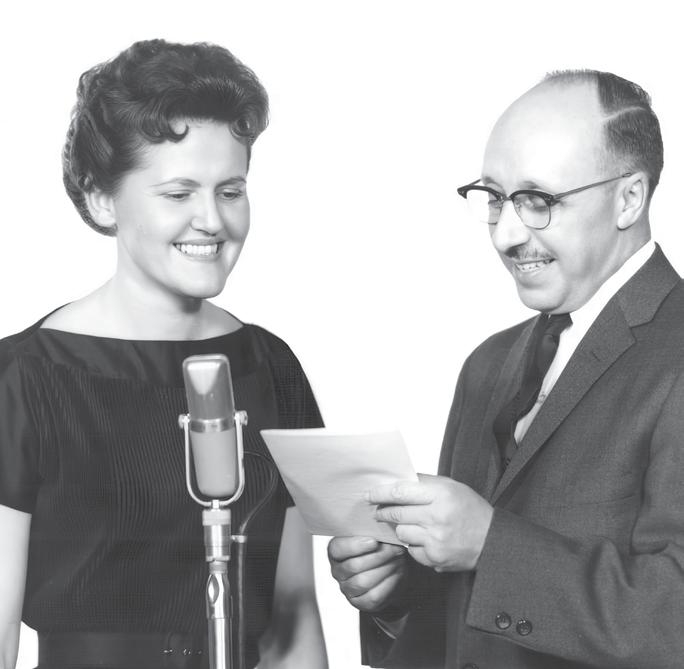
associate speaker of La Voz de la Esperanza. The 30th anniversary was celebrated with events in Chicago, Miami, New York, and Los Angeles. California governor Ronald Reagan sent congratulations. Braulio passed away on April 8, 1974, of a heart attack. A large crowd attended his funeral at the Glendale church. He was laid to rest in Forest Lawn Cemetery in Hollywood. Felisa survived him by three decades, passing away in 2004 at 96.
Reflecting on his life, Walter R.L. Scragg from the General Conference called Braulio one of the most influential Adventist figures of his time. H.M.S. Richards remarked, “To know him was to love him.”

Milton Peverini García noted that young people especially admired his warm, spiritual speaking style. Gastón Clouzet, former director of the radio postal school in the Austral Union Conference, remembered, “Don Braulio’s lectures were simple, clear, and dynamic.... He always ended with poetry, and he did it masterfully.”



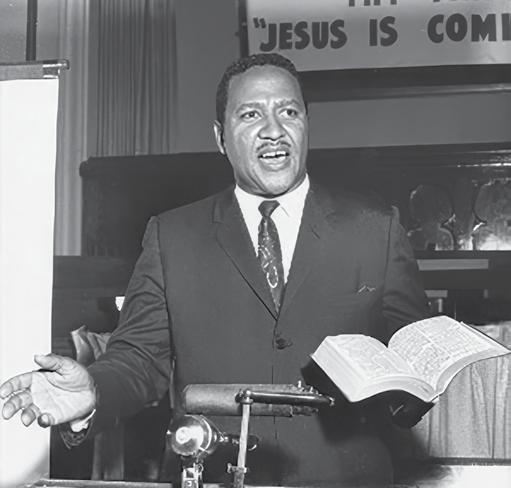







By the Recorder editorial staff
The early days of media ministries in the West were groundbreaking for the whole of the country. In 1929, H.M.S. Richards began his Tabernacle of the Air broadcasts that eventually became the Voice of Prophecy (1937). This was an avenue of evangelism that had not been explored before. Broadcasting over KNX-AM radio in Los Angeles, Richards showed it was possible to reach audiences in a way that was brand new. [For more information, see the article on H.M.S. Richards from this series in the January 2025 issue of the Recorder.]
“October 19, 1929 marked a

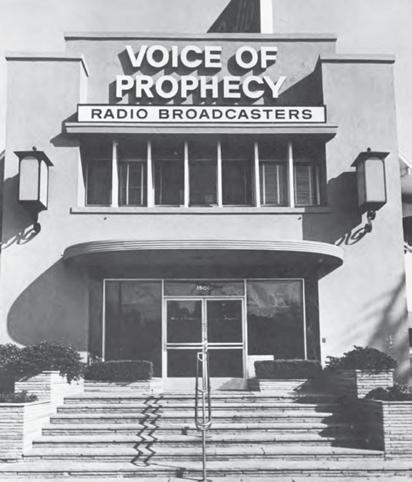
major mile-stone with the first fifteen minute radio broadcast on station KNX in Los Angeles, California. The broadcast that would be repeated several times a week was paid for by the Los Angeles Express ‘as a perk for the advertising that Richards placed with them every week.’ The first steps in using media broadcast as a means of proclaiming the Seventhday Adventist message were being taken.”1 His message? Simply the Bible. Asked for advice to young ministers, he had this to say: If I were a young preacher, “I’d preach the Bible; preach it plain, simply, without frills, and let its message cut deep, right to the heart of people. Nothing else will convict, convert, and conserve like the


Word. It is the living Word of the living God, and therefore it is all-powerful wherever He directs it!”2
In 1942 the Voice of Prophecy was the first religious broadcast aired coast-to-coast. Richards later identified this event as one of his greatest thrills in ministry—a long ministry that through its direct outreach and through a Bible correspondence school, resulted in many conversions. Richards retired in 1969, while the ministry continued under his son, H.M.S. Richards Jr.
La Voz de la Esperanza began in 1942 in Cuba, with Braulio Perez Marcio as principal speaker. Broadcasts began over KOWL Santa Monica, California, and CMQ Havana, Cuba. “He was the founder and speaker/director for more than 30 years. Not only did he lead the radio program, but he also held evangelistic campaigns throughout many hispanic countries as well as the United States. His knowledge, compassion, and his ability to write books and poetry as well as his understanding of the hispanic culture made him a very influential personality.”3 [See the article about Braulio Pérez Marcio from this series in the September issue of the Recorder.]
By 1943 the program could be heard across Latin
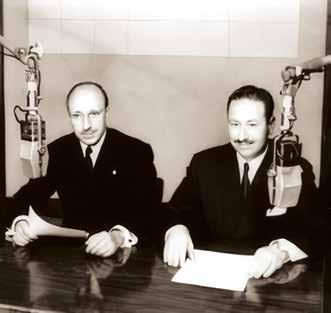

America, with one former vice president of Peru identifying it as “the father of Spanish Christian radio programs.”

Perez Marcio continued broadcasting until 1971, when Milton Peverini Garcia joined, first as associate speaker and later as speaker-director. Since 2013 the program has been led by Omar Grieve, as director, and his wife, Nessy Pittau, as associate director.
Begun by William Fagal in New York in 1950, Faith for Today moved to California in 1972. There the Christian drama series Westbrook Hospital was developed, along with docudramas such as “John Hus” and “The Harvest.” In 1980 Dan Matthews took over leadership, and in 1985 Christian Lifestyle Magazine began. In 1990 this morphed into Lifestyle Magazine, a talk show program. Other programming followed, such as McDougall, M.D. and The Evidence Faith for Today is currently headed by Roy Ice.
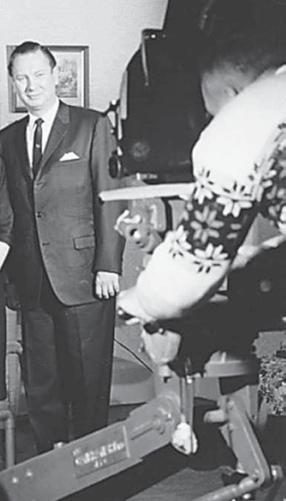

In 1956, George Vandeman started It Is Written, the first Adventist television program in color, broadcast from Fresno, California. He continued broadcasting until 1992, using a unique semi-documentary format along with a mix of health and felt-needs concepts designed to appeal to a wider secular audience. Under his leadership, It Is Written developed

new evangelism initiatives. His live “Revelation Seminars” attracted tens of thousands of visitors, and the telecast entered millions of homes in numerous countries. Since 2011, John Bradshaw has led It Is Written. Originally from New Zealand, Bradshaw has held more than 100 evangelistic series spanning six continents and has impacted thousands of lives in hundreds of cities.


Charles D. Brooks

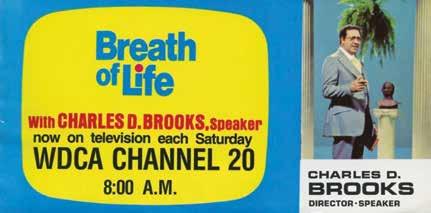

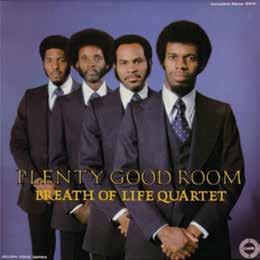

In 1974, while serving as Director of Public Affairs at KHOF in Glendale, California, Walter Arties developed the Breath of Life telecast. C.D. Brooks, field secretary at the General Conference, accepted an invitation to join the program as speaker, a role he held for 23 years.
The telecast was aired 13 to 26 weeks prior to evangelistic meetings scheduled in specific locations. In Washington, DC, for example, public evangelism was conducted consecutively in 1978 and 1979 with the telecast used to gain interest. Church members advertised the telecast and the meetings. Baptisms totaled more than 500, and a new church was organized. Brooks was followed in 1997 by Walter L. Pearson Jr., who continued the legacy begun by Arties and Brooks. Breath of Life is currently headed by Debleaire K. Snell.
More media ministries have been developed since, including Acts 2000 (first worldwide satellite broadcast), LifeTalk Radio (1991), Jesus 101 (2013), and other programs. It’s interesting to note that the primary location for media ministry is in the experimental and innovative West. The headquarters of the Adventist Media Center is in Riverside, California, and hosts the website www. adventistmediaministries.com for the North American Division.
1Eric M. Doran, Utilizing H.M.S. Richards' Sermons and Writings in the Development of Sermons That Focus on the Unique Aspects of Seventh-day Adventist Preaching as Implemented at the Kress Memorial Church in Winter Park, Florida (D. Min. dissertation, Andrews University, 2011), p. 100.
2H.M.S. Richards, cited by Herbert Ford, “If I Were a Young Preacher…,” Ministry Magazine (October 1970), p. 10.
3“Our Story,” La Voz de la Esperanza, https://www.lavoz.org/our-story.
In many ways it all happened by accident! It wasn’t as if there was a deliberate attempt to achieve diversity among the Adventist Church in the West. It was because there were so many different peoples in the West that, as Adventists reached out, a wide range of different groups responded. Sadly, these early missionaries were so busy sharing they didn’t spend much time in recording who accepted the message or where they came from.
However, it is certainly true that embracing diversity is a continuing theme of Pacific Union

Conference history. From its earliest days, the very society in which the church operated made mutual respect and toleration an essential aspect, validated by its Christian message.
The 1849 Gold Rush had greatly contributed to the “leveling” of society, since those involved were motivated by a single-minded objective that reduced the usual structure. This was particularly true due to the lack of sufficient manpower that made those who were able-bodied of more value than any other ability or expertise. Harold McCumber explains:
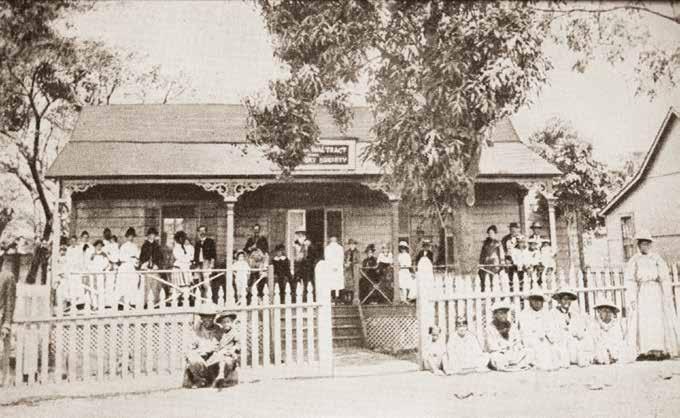

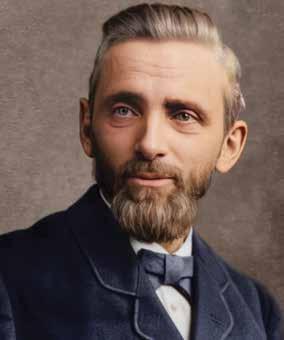

An unbelievable democracy developed as the result of the lack of laborers. Class distinctions dissolved. Doctors, lawyers, and men of former political distinction and wealth did their own cooking and mending, carried their own trunks, worked with pickax and shovel. Many times, when they were unsuccessful in finding gold, they drove mule teams for former day laborers who overnight had become wealthy in the mines.1
With this background, along with continued immigration from both East and West, together with a revised methodology of mission that embraced the vibrant and open society of the time, Adventists made a significant impact.
“This preaching has told powerfully upon the people,” Loughborough records, “and has swept away a vast amount of prejudice and taken hold of many hearts. In this city of 175,000 inhabitants are representatives of every nation on earth, and representatives of every state in the Union. Here people
are coming and going; so much so, that it was stated a few days since in the Daily Call that there are 25,000 inhabitants here that were not here eighteen months ago. A meeting thoroughly advertised and properly conducted in such a place as this will scatter the truth wonderfully.”
Many persons who were bound for foreign ports attended the meetings. They carried the message with them and took tracts and pamphlets to distribute on their journey.2
Note Loughborough’s observation that in San Francisco there were “representatives of every nation on earth, and representatives of every state in the Union.” In addition there was so much immigration and emigration that the composition of city was constantly changing. It also provided the opportunity to share the Adventist message to other parts of the globe as travelers were converted and took Adventist books and papers along with them. This was the backdrop for Adventists as they worked in this new location.
Take a few “for examples” of the way in which

Adventist mission developed in the West. After early work in Petaluma, Loughborough and Bourdeau moved to Windsor, and by Jan. 1, 1869, they had conducted over 50 evangelistic meetings there.
Loughborough writes, “Although the opposition we met in Petaluma followed us here, about a dozen accepted the message, among them Dr. Krieschbaum and Madam Parrot, a French lady graduate from a medical college in Geneva. It was while Abram La Rue, our first missionary to China, was chopping wood for one of our Windsor brethren that he read our publications, attended meetings, and was baptized.”3
This brief mention reveals a Dr.

Krieschbaum, clearly of German extraction; Madam Parrot, Swiss French; and most significantly Abram La Rue, who first went at his own expense to work for the Chinese immigrants in Hawaii and then later as the first missionary (self-supporting) to China.
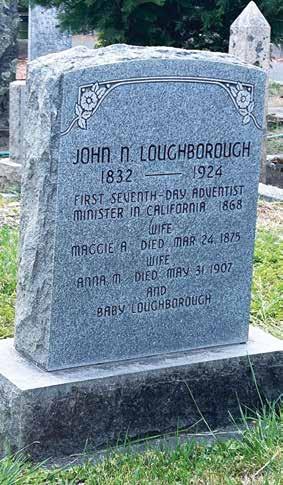
Loughborough explains how this happened:
In the year 1884, Mr. La Rue and Henry Scott, at their own expense, went as missionaries to Hawaii. They began their labor by doing personal missionary work and selling books. This awakened such an interest on the island that the General Conference, in November, 1885, voted that Elder Wm. Healy go the next season to Hawaii to labor, and that the California Conference be requested to loan a
tent for this purpose. Thus equipped Elder Healy and those already on the island conducted a tent-meeting during the summer of 1886. As the result of this effort a number of persons accepted the message. Mr. La Rue remained in Honolulu till the year 1889, when he set sail for Hong Kong, China.
But little ministerial labor was furnished the island until the General Conference convened in the month of March, 1895, at which time a vote was taken that “Elder Gates and his wife, with Mr. and Mrs. Brown as teachers for the Chinese,

go to Honolulu to engage in missionary labor.” The work of teaching began at once, and Elder Gates, although in feeble health, did what he could in pushing the work. A physician and nurses soon followed the missionaries, and the work in that line of the message was well begun.4
This reveals the influence of just one convert who almost singlehandedly introduced the Adventist message to the Chinese, initially in the West, and then in China itself.


Another example is that of William Hunt from Nevada who corresponded with Loughborough for over a year, initially addressing his letter of interest to “the Elders of the tent in Healdsburg,” not even knowing their identity at the time. He had purchased just about all the available Adventist books and periodicals, and eventually met up with Loughborough—but while he was on his way to emigrate! McCumber details the meeting:

The E.J. Waggoner family and other Adventist workers prepare to board a train in Oakland, headed for the East, either 1889 or 1890. Dr. Waggoner is standing in front, second from the left; his wife, Jessie, is the woman standing furthest to the right; J.N. Loughborough (with white beard and hat) stands behind the Waggoners’ daughters, Pearl and Bessie.
One evening while speaking in Bloomfield, Loughborough noticed a stranger in the audience who gave close attention to the sermon. After the service one of the brethren introduced him to the minister.
“Here’s a man from Nevada who wants to talk with you. He’s stopping at our lodginghouse.”
“And is his name William Hunt,” questioned Loughborough, “with whom I’ve been corresponding for more than a year?”
“Yes, I’m the man,” said the stranger. “I’ve come to spend a few days before leaving the States. I’m on my way to New Zealand—or perhaps the diamond fields of South Africa if things don’t turn out too well there.”
Mr. Hunt spent five days with them.… “I’ll probably never see you again,” he said before his departure. “But you’ll hear from me if I get through safely. By the Lord’s help I shall faithfully obey the truth.”
It was almost three years before word

came from Hunt. He was in South Africa, and through the literature he had distributed, some of the people became Seventhday Adventists. Among them was a Mr. Van Druten, who later sent money to the United States to help defray the expenses of a missionary whom they most urgently requested. Another was Peter Wessels, whose family was among those who discovered diamonds at Kimberley.”5
These brief examples make it clear how the wide variety of ethnicities and languages in the West has brought tremendous benefits to the spreading of Adventist beliefs.
1Harold Oliver McCumber, Pioneering the Message in the Golden West (Mountain View, CA: Pacific Press Pub. Assn., 1946), p. 25.
2McCumber citing J.N. Loughborough in Pioneering the Message in the Golden West, p.110.
3J.N. Loughborough, Miracles in My Life (Payson, AZ: Leaves-of-Autumn Books, 1987 reprint), pp. 72-73.
4J.N. Loughborough, The Great Second Advent Movement: Its Rise and Progress (Washington, DC: Review and Herald Pub. Assn., 1909), pp. 439-440. 5McCumber, Pioneering the Message in the Golden West, pp. 98-99.

Frank Daugherty, who was principal from 1949-1966, talks with two students in the office at the mission school in Holbrook.

Orno Follett and his wife, Agnes, pioneered Seventh-day Adventist mission among Native Americans in the American Southwest.
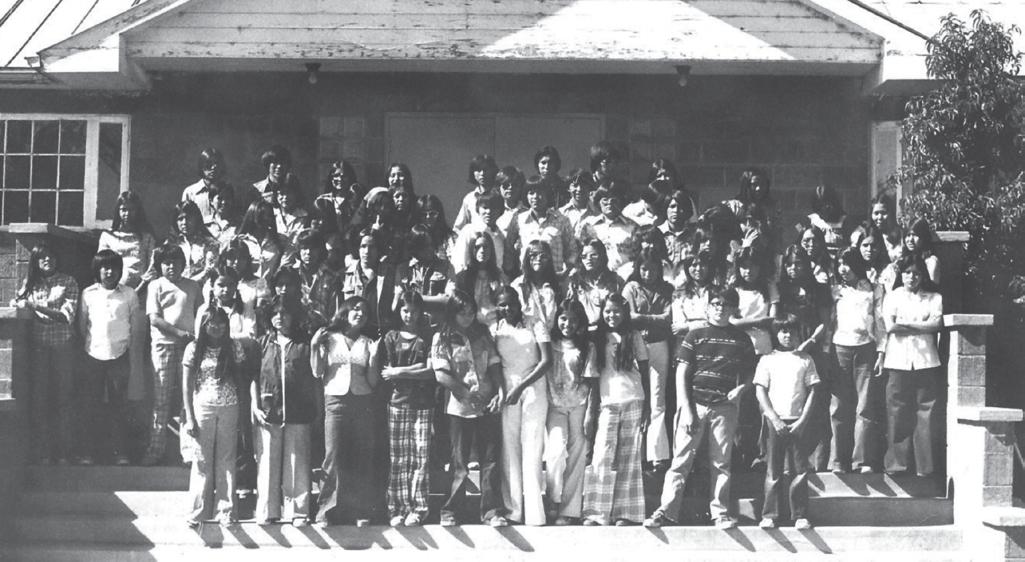
The story of Holbrook Indian School (HIS) begins long before the campus doors opened in 1946. In 1916, Elder Orno Follett and his wife devoted themselves to mission work among the Navajo people. Their efforts led to the building of a small school at Lake Grove Mission in New Mexico in 1918. Yet this first attempt did not last; the Great Depression forced its closure in 1937 when funds dried up.
By the early 1940s, the Seventh-day Adventist Church again turned its attention to the Navajo Nation. The Arizona Conference hired Marvin Walter, a full-time evangelist, whose wife, Gwen, was a nurse. Their dual ministry aimed to meet both the physical and spiritual needs of the people. With land secured in Holbrook, Arizona, a new mission school opened in 1946. The first class numbered just 30 students, taught by one teacher with the help of two deans. Lacking desks, the children recited lessons seated on rugs and sheepskins. Challenges soon arose. When the Walters had to leave due to illness, the school briefly closed in 1948. Yet the vision would not die. The Arizona Conference reopened HIS, bringing in new leaders—Frank Daugherty, Ardell
Marvin and Gwen Walter wave goodbye as they leave Glendale, California, for a new mission post among the Navajos.

Altman, and Wilfred Rathburn. Their resilience planted seeds for what would become a longlasting institution.
The rise of HIS must be seen in contrast to the government’s boarding school system, which by the late 19th century was infamous for its destructive policies. These schools operated under the motto of Richard Henry Pratt: “Kill the Indian, save the man.” Native children were taken from their families, stripped of their culture, and punished for speaking their languages. Hair was cut, names changed, and diets forced to conform to Western norms.
The consequences of such assimilationist policies were devastating: generations scarred by trauma, cycles of poverty, addiction, depression, and broken families. Even today, the legacy is felt in statistics: American Indian youth suicide rates are more than double the national average, alcohol-
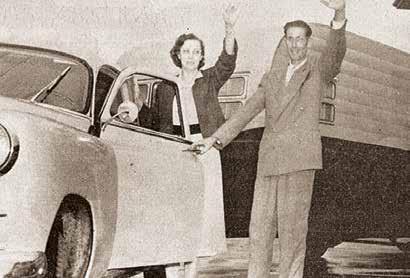

related deaths are five times higher than the U.S. average, and food and housing insecurity continue to burden many communities.
In this context, HIS represented a different path. Instead of erasing identity, it sought to nurture wholeness—educating young people while honoring their heritage and helping them thrive as Indigenous Christians.
From its modest beginnings, HIS steadily expanded. Today the school boasts modernized classrooms, a high school building, and an administration center that doubles for elementary instruction. The campus, once a dusty desert landscape with a windmill for water, now features attractive landscaping and safe, comfortable facilities.
The curriculum evolved too. Academic subjects remain core, but HIS emphasizes vocational and cultural education as well.
Students learn welding, woodworking, auto mechanics, and agriculture. An Indigenous Arts program offers pottery, beading, weaving, drawing, and graphic design.
The Equine-Assisted Learning program has become a student favorite, blending practical skill with therapy.
One innovation is the MAPS program— addressing Mental, Academic/Artistic, Physical, and Spiritual needs. HIS recognizes that academic achievement is deeply tied to mental health, physical well-being, and spiritual grounding. Licensed counselors, teachers, and mentors work together to craft wholistic wellness plans for students.
While HIS provides a safe learning environment, its deeper mission is restorative. Many students arrive with personal or family trauma, echoes of the systemic injustices faced by Indigenous peoples. HIS staff consciously counteract this by affirming culture, reconnecting students with their language, history, and traditions.


The first school building, no longer on campus today, was built in the late 1940s and had classrooms, offices, dorms, staff apartments, and a cafeteria.

Classes in Navajo government and language are central. Sam Hubbard, a Diné instructor, delights in watching students discover parts of their heritage they might never encounter elsewhere. “We want them to not feel ashamed of their Native heritage,” he explained.
This cultural reclamation is powerful, considering that earlier boarding schools punished children for speaking Navajo. Ironically, the language became a national asset during World Wars I and II, when Navajo Code Talkers used it to transmit unbreakable messages. Many HIS students are descendants of these heroes, and language classes help them reconnect with their grandparents who still speak Diné.
Students also retrace history through experiential learning. In Navajo history classes, they study the Long Walk of the 1860s, when Kit Carson’s scorchedearth campaign forced thousands of Diné on a 400mile march to Bosque Redondo. Hundreds perished along the way. Today’s HIS students walk parts of that trail to understand their ancestors’ suffering and resilience.
Each year, students also travel to Window Rock,

Arizona, to witness the Navajo Nation’s government in action. As the largest tribal government in the U.S., it faces stark realities: widespread poverty, low graduation rates, and scarce opportunities. These field trips empower HIS students to see both the challenges and the possibilities before them.
Agriculture remains central to HIS. For centuries the Navajo sustained themselves through farming and sheep herding. After Bosque Redondo, they had to rebuild from nothing, often relying on government rations. HIS aims to restore traditional farming knowledge by teaching students to grow the “Three Sisters”—corn, beans, and squash— while practicing sustainable gardening.
The school’s farm now supplies organically grown produce for the cafeteria and sells to staff and the local community. Agriculture classes also connect students with themes of health, stewardship, and independence.
Art plays a profound role in healing trauma. HIS’s Indigenous Arts program teaches pottery, weaving, and beadwork, but its benefits extend beyond skill. As Zak Adams, the program’s founder, explained, “They can use it to express themselves when words
Many students arrive with personal or family trauma, echoes of the systemic injustices faced by Indigenous peoples.
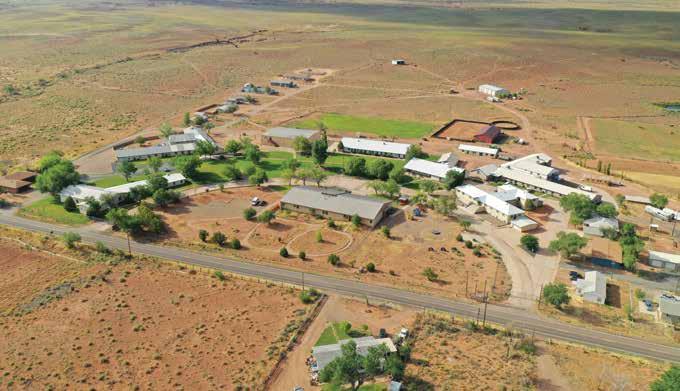

can’t. What I have seen of our students is that they are starving for their own culture.”
Creative expression fosters resilience, concentration, and emotional well-being. For youth facing depression, anxiety, or PTSD, art becomes both a therapy and a link to heritage.
Holbrook Indian School continues as a ministry of the Seventh-day Adventist Church, accredited by both denominational and regional agencies. Funding comes from two main sources: about 20 percent from the Pacific Union Conference and 80 percent from individual donors who believe in the mission.
The spiritual foundation remains central. The

school’s mission is to provide “a safe place for students to learn, grow, and thrive in Christ.” Unlike government boarding schools of the past, HIS offers students a Christ-centered education that embraces rather than erases their culture.
From its precarious start with one teacher and no desks, Holbrook Indian School has become a place of resilience and renewal. It was born in response to a need—the need to serve Native youth with dignity and respect. Over the decades, HIS has adapted, expanding programs in agriculture, vocational skills, equine learning, and Indigenous arts.
Most importantly, it has stood as a counterwitness to the destructive legacy of federal boarding schools. HIS does not seek to strip away identity but to nurture it. Here, Navajo youth and other Native students find not only education but healing, cultural pride, and spiritual hope.
The words of a second-grader arriving at the dormitory capture the heart of HIS: “It’s so good to be home!” For many who pass through its doors, Holbrook Indian School is more than a school. It is a place where brokenness meets compassion, where culture is celebrated, and where the future is written anew.

Jack W. Provonsha
Like a composer who turns a simple tune into a majestic symphony, Jack W. Provonsha transformed a familiar theme in Seventh-day Adventist circles—individuality, power to think and to do—into a powerful philosophical orientation about human personhood and agency that those with other backgrounds and points of view can evaluate from their own standpoints. His views were particular in their origin but universal in their destination and public in their desired evaluation.
Zdravko Plantak, ed.
A compelling collection of essays exploring brokenness and healing through theological, historical, ethical, and pastoral lenses. Contributors confront personal and communal wounds—from race, gender, and sexuality to war, illness, and trauma—while envisioning pathways toward spiritual wholeness. The book invites readers to partner with God in restoring hope and integrity in a fractured world.

Melissa J. Brotton, ed.
The proceedings of the Adventist Society for Religious Studies (ASRS) conference held November 18-20, 2021, in San Antonio, Texas. With few exceptions, the conference papers have been revised and edited for a broad audience though they retain their original content for the most part. Our hope in publishing this volume is that it will raise concern and promote conversation about our care of God’s world.
Jean Sheldon, ed.
A groundbreaking collection that amplifies the voices of Adventist women scholars across theology, history, ethics, and pastoral studies. The book highlights both academic excellence and spiritual conviction, while celebrating the ongoing struggle for equality in ministry. It is inspiring, rigorous, and deeply relevant for those invested in faith, scholarship, and justice.

Remembering Mathilde Frey, ed.
The divine gift of the seventh-day Sabbath offers hope and remedy for the needs of our world. In response to the despair of climate change and the tragedy of unjust economics, Sabbath as a shared day of rest embraces care for the earth, rest for the land, reprieve for the destitute, and a stop to ruthless acquisition. Remembering and sharing the story of the Sabbath in a fresh way holds transformative power.
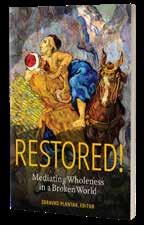

These and other Oak & Acorn books are available on Amazon and AdventSource Oak & Acorn Publishing is a ministry of the Pacific Union Conference

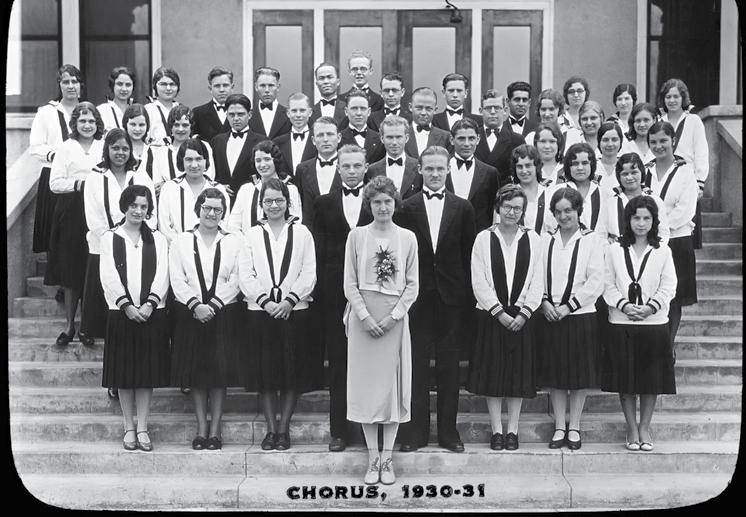
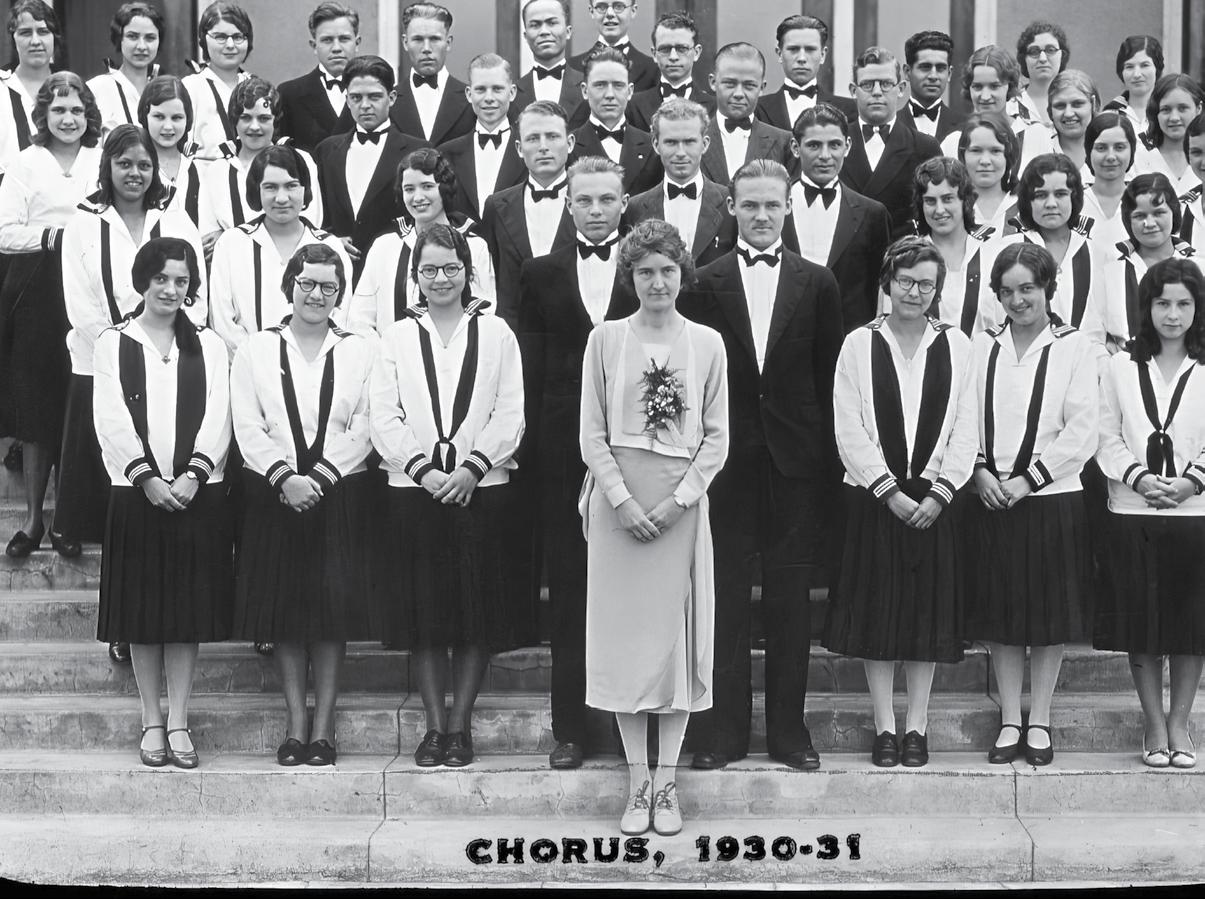



In 1920, five years after the creation of the Southeastern California Conference of Seventhday Adventists, the conference and adjacent Southern California Conference realized that their local Adventist school, San Fernando Academy, needed to be replaced and expanded. The conferences formed a committee to explore constructing a jointly operated school that might one day include a junior college. Even though the General Conference delivered a surprising vote against their school expansion venture, the conference committee, dedicated to education and Ellen White’s advocacy of rural schools, nonetheless commenced an arduous and wide-ranging search for a location on which to build. Eventually more than 300 acres were bought in 1922 near Riverside from a rancher named Willits J. Hole. The land had formerly been part of an 1846 Mexican land grant called Rancho La Sierra.
On July 1, 1922, Principal J.I. Robison announced that a school would open on October 3—a fullfledged 12-grade school. However, at the time of the announcement, there was nothing there!
As Robison explained later, “We did not have a

building. We did not have a book in our library, nor a test tube for the laboratory. We did not have a desk or a chair. We did not even have a faculty.… But we did have faith.… And so with faith and courage and loyal cooperation and united effort we stepped forward, facing every difficulty, confident that the Lord was leading, and that we would open school on October 3, as we had advertised.”1
Aided by numerous volunteers, donors, and the Riverside civic community—which ponied up $10,000 plus $5,000 in benefits to help secure its location—it opened on time, even if work wasn’t quite finished. Though the boys’ dormitory was completed, the girls’ dormitory was only half plastered—and since the stairs had not been installed, the girls had to access their unfinished rooms by ladder!
Varner Johns reported on the inaugural reception in 1922. “Two hundred or more crowded into the reception room of the La Sierra Academy the evening of November 19. Professor J. I. Robison gave the address of welcome to students, faculty and friends of the new school. Yes, a faculty of college bred, Christian trained men and women are there; all of
“God would not have us in any sense behind in educational work. Our colleges should be far in advance in the highest kind of education.”

them successful teachers, loved and respected by the student body. Every lover of Christian education should have heard one of the students tell those assembled, why she came to La Sierra Academy. All our efforts and sacrifices are worthwhile, if only our boys and girls can be in a school where such a spirit grips the hearts of its students. They have caught the spirit of the message, and they too have the ‘vision’ of true education and of service in a world field.”2
In 1923, coursework for teacher training was added, and the school, jointly operated by the two conferences, became La Sierra Academy and Normal School. With additional courses, in 1927 the name changed to Southern California Junior College. This necessitated major expansion to the institution, including extra office space, laboratory equipment, heating facilities, and library development. An elementary school was built on the north side of the campus. Over next three years, other facilities were added and the industrial program of the college was improved. During the Great Depression the college managed to not only survive but thrive under the diligent leadership of Erwin E. Cossentine, who between 1930 and 1942 expanded enrollment significantly and grew the campus footprint with new buildings and new programs through tenacious fundraising and advocacy. A new science hall, San

Fernando Hall, was added in 1932, which led to the accreditation of the college by the Northwest Association of Secondary and Higher Schools in 1933. A swimming pool, a gymnasium, and the Hole Memorial Auditorium were constructed between 1935 and 1937.
In 1939, the name changed to La Sierra College. It was accredited as a four-year liberal arts college in 1946. After World War II, enrollment increased rapidly, reaching 919 in the winter term of 19471948. Additions during this time included the library-

administration building (1946), the college church (1947), an industrial arts building, and a science building.
By 1962 other additions included a physical education facility with showers, a new swimming pool, tennis courts, a dairy building, and a poultry farm. Other improvements over subsequent years included a high-rise men’s residence hall.
In 1967 it was decided to merge La Sierra College with Loma Linda University as the latter’s College of Arts and Sciences. However, in 1990 this arrangement was ended, and La Sierra University and Loma Linda University were reconstituted as separate institutions.
By the 1993-1994 school year, 17 departments offered 15 Bachelor of Arts degrees, 17 Bachelor of Science degrees, a Bachelor of Music degree, a Bachelor of Social Work degree, a Bachelor of Fine Arts degree, six Associate in Arts degrees, and two Associate in Science degrees. Graduate study was possible in art, chemistry, English, history, modern languages, music, office management, health and physical education, and psychology.
The university is accredited by the Western Association of Schools and Colleges and the Accrediting Association of Seventh-day Adventist Schools, Colleges, and Universities (AAA).

Beyond the academic aspects, the real reason behind all Adventist schools is “education for eternity.” As Ellen White wrote: “Although the study of the sciences may carry the students to high literary attainments, it does not give a full, perfect education. When special attention is given to the thorough development of every physical and moral power which God has given, then students will not leave our colleges, calling themselves educated while they are ignorant of that knowledge which they must have for practical life, and for the fullest development of character” (Ellen G. White, Christian Education, p. 212).
“God would not have us in any sense behind in educational work. Our colleges should be far in advance in the highest kind of education.… There is a great deal of talk concerning higher education, and many suppose that higher education consists wholly in an education in science and literature; but this is not all.…
“The highest class of education is that which will give such knowledge and discipline as will lead to the best development of character, and will fit the soul for that life which measures with the life of God. Eternity is not to be lost out of our reckoning. The highest education is that which will teach our children and youth the science of Christianity, which will give them an experimental knowledge of God's ways, and will impart to them the lessons that Christ gave to His disciples, of the paternal character of God” (Ellen G. White, Counsels to Parents, Teachers, and Students, p. 45).
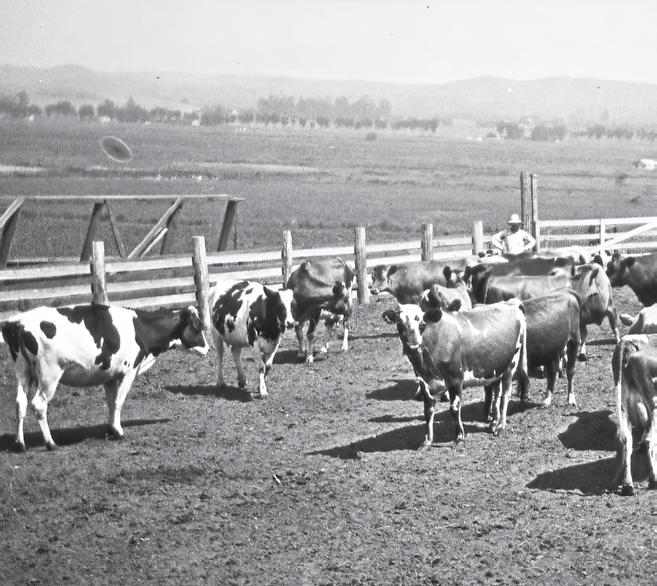
Today approximately 1,600 students attend La Sierra University each year. Guided by
Domestic science cooking class, circa 1927-early 1930s

the mission “To seek truth, to know God, to serve others,” the university provides more than 120 bachelor’s, master’s, and doctoral degree programs on a main campus that maintains its rural heritage as a registered arboretum, an oasis of vibrant flora and varieties of fauna. Its faculty include Fulbright Scholars; recipients of National Science Foundation, National Geographic, and USAID grants, and other recognitions; and academics who engage in groundbreaking scientific and archaeological research, artistic development, business, education, and theological training and leadership.
La Sierra University was named No. 1 in the nation four times for its diverse environment by the Wall Street Journal/Times Higher Education College

Bus trip, 1929

Ranking. U.S. News and World Report’s 2024 Best Colleges guide ranks La Sierra fourth in the 15-state western region for social mobility, a measure of its ability to support those who struggle with various challenges, guiding them to degree completion and moving them beyond their expectations.
The university has also been recognized by the Carnegie Foundation for its Service-Learning program and other outreach and in 2013 by the Obama administration for its commitment to service.
1“92 Years Ago,” Adventist World (July 12, 2014), p. 30.
2Varner J. Johns, “La Sierra Academy Reception,” Pacific Union Recorder (Nov. 30, 1922), p. 4.


Orchestra, 1930-31

Women of the West is an inspiring and meticulously researched anthology that celebrates the contributions of 20 remarkable women who significantly shaped the Seventh-day Adventist Church, particularly in its westward expansion. The book not only restores these women's stories to the forefront but also contextualizes their achievements within the larger narrative of Adventism’s pioneering spirit.
Women of the West is organized into 20 chapters, each dedicated to a different woman and each authored by a different Pacific Union College student. These short biographies detail the lives of women from diverse backgrounds who were leaders in education, healthcare, ministry, missionary work, and community building.
The book stands out for its engaging blend of historical detail and personal narrative. Each chapter presents a vivid portrayal of a pioneer woman, highlighting their courage, faith, and leadership in various spheres, including education, healthcare, and ministry.
While the text is firmly rooted in Adventist history, its themes of resilience, innovation, and dedication resonate broadly, making it a valuable read for both Adventist and non-Adventist audiences. The inclusion of primary sources, archival anecdotes, and academic references enriches the narrative, ensuring the book's appeal to scholars and general readers alike.

The book seeks to inspire by demonstrating how the faith and determination of these women shaped their communities and advanced the mission of the Adventist Church. It also challenges readers to reflect on the evolving roles of women in religious leadership and highlights the importance of preserving and sharing untold stories.
Oak & Acorn Publishing is a ministry of the Pacific Union Conference.

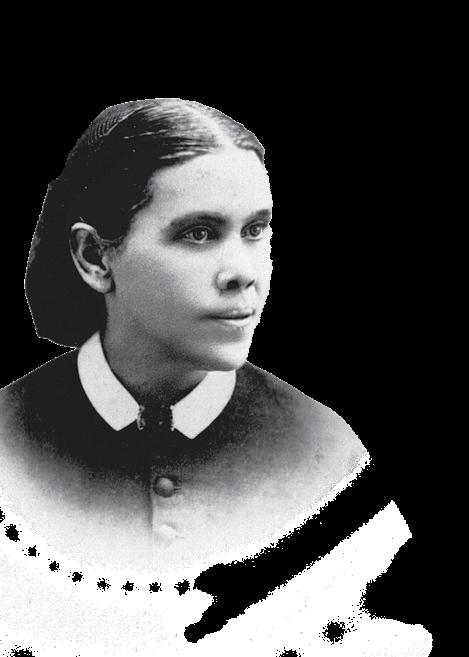

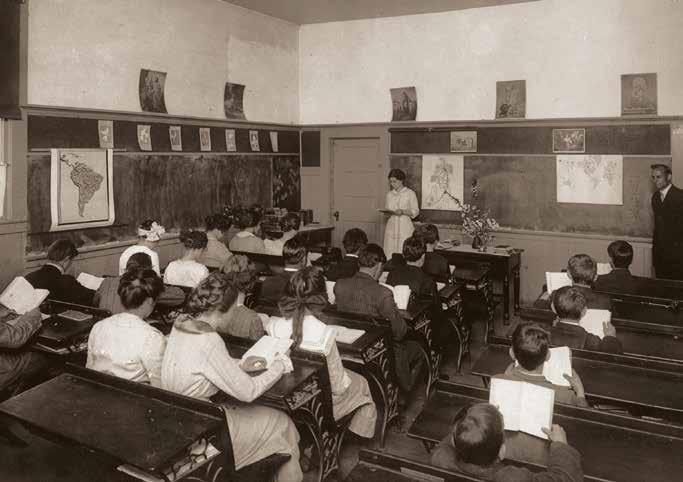
The first steps in the establishment of Pacific Union College began in 1882 when Sidney Brownsberger was selected as principal at a school in Healdsburg with just 28 students. This became Healdsburg College. A report in The Signs of the Times gives the background:

A new feature in our Conference work was the consideration of the new Healdsburg College, which received considerable attention. A visit to the new building, now in process of erection, and to the College building, was an occasion of much interest.…
All then repaired to the College, which was inspected and admired. In the "audience room" above, a dedication service was held; brief and informal, but quite interesting. As the room could not contain all the visitors, the speaking was limited to very few words;

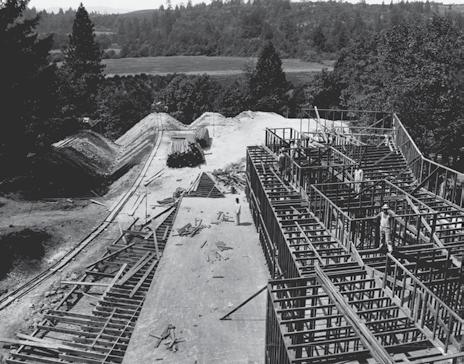
“Beulah Land” was sung, after which, prayer by the editor of the SIGNS, was offered; then, by request of Sister White, a verse of “Hold the Fort” was sung by almost the entire congregation.
When it was voted at the Sacramento camp-meeting last year, to make an effort to start a school in California, no one imagined that so much could be accomplished in one year, nor would it have been believed if it had been predicted. No other important enterprise
“A new feature in our Conference work was the consideration of the new Healdsburg College, which received considerable attention.”
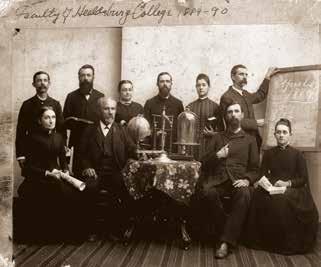
among Seventh-day Adventists has been so rapidly forwarded to a successful standing, and with so small an outlay of means compared to results. Bro. W. C. White has spent several weeks in Healdsburg, to aid in the work. There seems to be a general feeling among our people that the shortness of time demands that the College be placed in the highest state of usefulness in the shortest possible time. All consider that it has a mission to prepare laborers for various positions in the cause of the present truth, and all seem to realize that there is no time to be lost.1
But before long, expansion was needed, and a new location had to be found. Ellen White was very much involved in this search, and she advised on the suitability of various options. After some initial disappointments, especially over a location at Buena Vista near Sonoma that had seemed suitable, a resort property at Angwin was investigated. Ellen White was taken there to review it, and she reported:
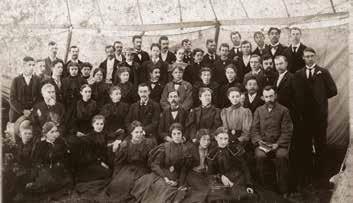
As I have looked over this property I pronounce it to be superior in many respects. The school could not be located in a better spot. It is eight miles from St. Helena, and is free from city temptations.…
We realize that the Lord knew what we needed and that it is His providence that brought us here.… God wanted us here and He has placed us here. I was sure of this as I came on these grounds.… I believe that as you walk through these grounds you will come to the same decision—that the Lord designed this place for us.2
Consequently, in 1909 the church bought the Angwin Resort in the mountains above St. Helena. The total cost was $60,000, and Pacific Union College was dedicated there on September 29, 1909.

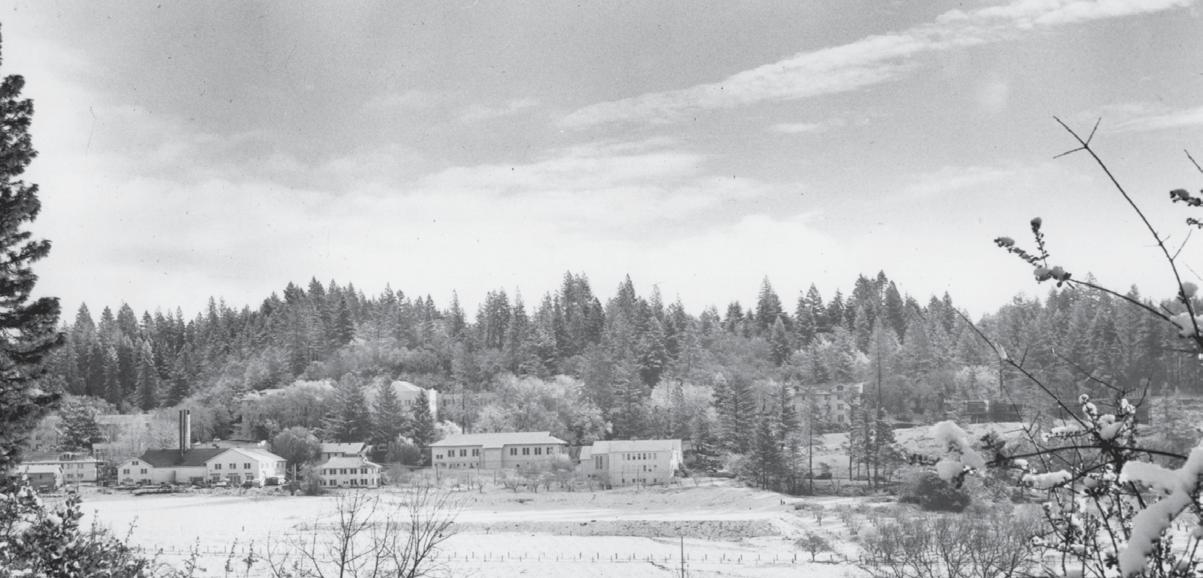


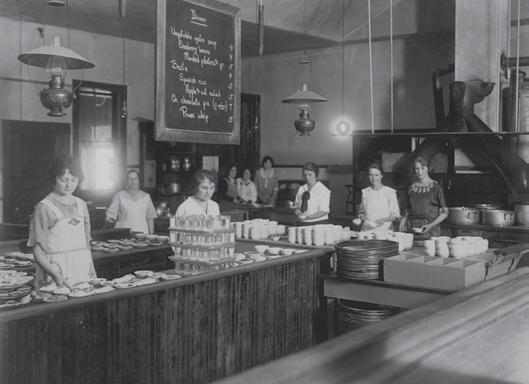
Dormitories, classrooms, and faculty homes were created out of the resort’s hotel, bowling alleys, and cottages. Other buildings were constructed using the readily available timber from the property. It also had the advantage of being near another Adventist institution, St. Helena Sanitarium, with the possibilities of mutual benefit.
More important even than the physical structure was the spiritual plan. The college was instituted to provide a solid educational background for the church’s young people in all kinds of vocations, with

the spiritual component uppermost in mind:
Now we need not wait any longer; our school can assemble and the work begin at once. And at its very beginning, let us determine to walk humbly with God. Let us seek to make such a representation as is given to us in the words I have read to you today. If we will do this—if we will walk in God's ways and keep His charge— the light of Heaven will certainly shine upon us. If we will resolve to do our best here, exercising the physical muscles equally with the brain powers, if we will work for the harmonious

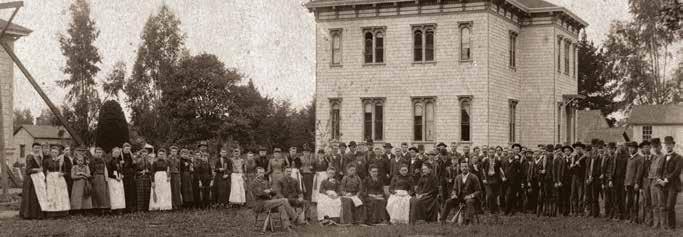
development of all the powers of the being, the blessing of the Lord will rest upon us in large measure.3
She even noted the issue of access to Angwin and the long road uphill, noting that, “It is true that there is a long hill to climb in order to reach the place, but that is not altogether a disadvantage. Many of us would be greatly benefited in muscle and in sinew if we did more climbing of hills.”4


Over time, the college has gone through many stages as it relates to the needs of students and the community. Work was provided on campus to help students with the cost of their studies, so at one time or another the college has hosted a dairy farm and a poultry farm and offered courses such as blacksmithing and home economics. Later additions to the college’s program have included physical education majors, aviation classes, film and television courses, and other contemporary fields of study. The school has always had a major commitment to education, religion, and science studies, with a strong emphasis on pre-medical courses. In 1932, the college was the first school to meet the church’s Board of Regents’ standards for college accreditation. The following year it was accredited by the Northwest Association of Secondary and Higher Schools, the first Adventist college to receive this. In 1951, accreditation also came from the Western Association of Schools and Colleges. Graduate work began at Pacific Union College in 1934 when a highly successful summer program called the Advanced Bible School was begun. This was the beginnings of what was later to become the Adventist Theological Seminary.
1“California Camp-Meeting,” The Signs of the Times (Oct. 26, 1882), p. 474.
2Ellen G. White, Last Day Events (Boise, ID: Pacific Press Pub. Assn., 1992), pp. 107-108.
3Remarks of Ellen G. White in “Report of the Dedicatory Exercises of Pacific College,” Pacific Union Recorder (Oct. 7, 1909), pp. 5-6.
4Ellen G. White, “Educational Advantages of the Angwin Property,” Pacific Union Recorder (Sept. 23, 1909), p. 4.



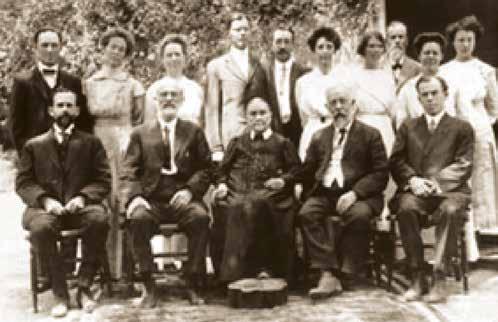

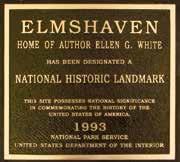

In 1900, Ellen White, 72 years old, had just returned from nine years in Australia. Having sold her home in the U.S. before leaving for Australia, she needed to find somewhere to live. Previously she had lived in the East, but now she believed the West was where she needed to be. In fact, ever since her first visit to California in 1872 she had dedicated much time and even personal funding to building up the work in the West. Her many assignments and calls on her services left little time for house hunting.
However, she recognized the importance of finding a place to call home, so as soon as she arrived in San Francisco she went looking: “For several days after reaching Oakland we spent the time in Oakland house hunting, to find a place to locate our families. We found nothing that was suitable, and I said, ‘I am done. I shall search no more. The Lord knows what our work is and where we should be located; and we shall wait the Lord’s time’” (Ellen G. White, Manuscript Releases, vol. 21, p. 126).
However, a friend told her about a place near St. Helena. So: “As soon as we could, we went down

to see the place, and we were well pleased with it. It is just the place I need,” she wrote. In fact, it was better than the home she had just left in Australia. She continued, “The Lord planned for me, and I found that I could buy this place here for less than I received for my house in Cooranbong and all its belongings. This includes two horses, one rather old, four carriages and a platform wagon, much better than the one I gave away, and a house furnished throughout. It was like stepping out of my home in Cooranbong into a beautiful, roomy one here. It has surprised me much that we should be thus favored.… This place was none of my seeking. It has come to me without a thought or purpose of mine. The Lord is so kind and gracious to me. I can trust my interests with Him who is too wise to err and too good to do me harm” (Ellen G. White, Manuscript Releases, vol. 21, pp.126-127).
Elmshaven had been the property of Robert Pratt, a railroad investor. Later he became assistant general superintendent of the Southern Pacific Railroad.
“The Lord is so kind and gracious to me. I can trust my interests with Him who is too wise to err and too good to do me harm.”
While involved in this work, he had the house later known as Elmshaven constructed in 1885 as his family home. However, by early 1900, his children had grown up and left home, so the “Robert Pratt Place,” as it was known, was put up for sale, along with its 74 acres and half interest in Crystal Spring.
William, Robert’s brother, had become a Seventhday Adventist in 1873. In 1877 he donated 10 acres of his hillside land and his half interest in Crystal Spring, as well as providing financial backing, in order to establish a medical institution known as the Rural Health Retreat (now Adventist Health St. Helena). This institution was what had brought Ellen White into the area, and her decision to locate close by provided a mutually beneficial relationship.
But it is for Ellen White’s writing that Elmshaven is most remembered. As one of the co-founders of the Seventh-day Adventist Church, she had spent much of her life helping her husband, James White, who served three one-year terms as president of the church. In her own right she spent much time directing the development of the church in its many areas of interest.
But as she set up home in Elmshaven, she recognized her main role was to help coming
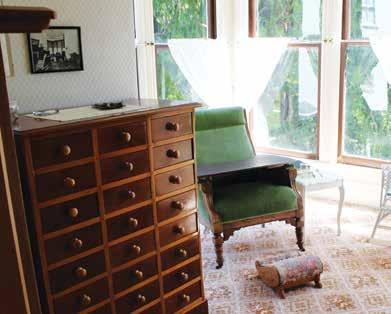
generations in their Christian experience. She wanted to get it all down on paper before she was gone. She wrote eloquently: “Occasionally I have attended meetings, and have visited institutions in California, but the greater portion of the time since the last General Conference has been spent in manuscript work at my country home, ‘Elmshaven,’ near St. Helena. I am thankful that the Lord is sparing my life to work a little longer on my books. O, that I had strength to do all that I see ought to be done! I pray that he may impart to me wisdom, that the truths our people so much need may be presented clearly and acceptably. I am encouraged to believe that God will enable me to do this” (Ellen G. White, “Courage in the Lord,” Review and Herald, June 12, 1913, p. 557).
During her life, Ellen White completed about 40 books, including nine major works she wrote in the upper writing room at Elmshaven. She also wrote materials later used as compilations, in addition to many hundreds of articles for church journals. Some have been translated and published in as many as 160 languages.
As she entered her writing room at noon on Sabbath, February 13, 1915, she fell and fractured her hip. It was in this room in a hospital bed that she spent the last few months of her life and, on Friday afternoon, July 16, 1915, closed her lifework. Her last words were, “I know in whom I have believed.”
Soon after Ellen White’s death in 1915, the Elmshaven property was sold. As it passed through several hands, the farmland to the east of the family orchard and home was disposed of and turned into residential building lots. To bring the residence and land to the south and west into Seventh-day Adventist control, Charles T. Everson, a prominent Adventist evangelist, purchased it in 1927.
After Charles Everson’s death in 1956, Mrs. Everson made the property available to the Pacific Union Conference, which now owns and maintains it with the cooperation of the General Conference.







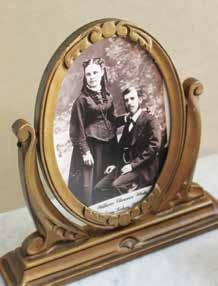

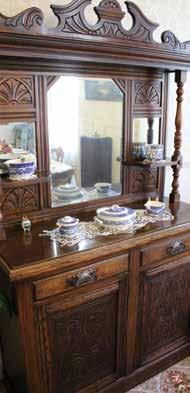

250–270 CE
Decian Plague kills 5,000 people a day in Rome alone.



6–4 BCE Jesus of Nazareth is born.

the darkness and despair of the ancient world.
430 BCE Plague strikes the city of Athens, Greece.
Desperate conditions during the Late Roman Plague test moral character.
27–29 CE
Jesus begins a ministry of healing and surprises everyone with new ways of thinking about the body.

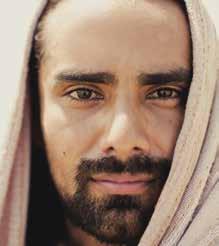
372 CE Basil of Caesarea opens the first hospital in the East.


30 CE
Communities of Jesus’ followers begin to spread around the Mediterranean Rim.
The story of Adventist Health has roots anchored deep in time, connecting us to our Adventist heritage and to an ancient world that continues to shape us today. Our story also has branches reaching wide and high with expansion and growth. It’s a story that includes each of us in a tradition of inspiring health, wholeness and hope that reaches back to the birth of Jesus.
1863
Ellen White has vision urging changes to common health practices of the day.
1850
Average life expectancy in the U.S. is 41 years.
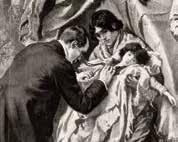

Early 1800s
Health reform movement begins, and the first Adventist healthcare facility is established.
1905
Loma Linda Sanitarium opens.




1800–1930
1878
Rural Health Retreat in St. Helena is established in California—the first major Adventist healthcare center on the West Coast.

Medical science makes dramatic advances.
2025
Adventist Health continues the practice of the healing ministry of Jesus.


2015
1980 Under the leadership of Frank Dupper, Adventist Health Services joins forces with Northwest Medical Foundation to form Adventist Health.
Average life expectancy in the U.S. is 79 years, 89 years for most Adventists.


The situation was challenging. The College of Medical Evangelists (later Loma Linda University) was in trouble. Located in what was then a relatively rural area, they were struggling to find enough patients to provide cases for their medical students to study. If they could not find more, they risked losing their chance for accreditation by the American Medical Association.
They looked to Los Angeles, a major population center, and opened a small clinic there. But the facilities were insufficient to meet the demand. What was needed was a full medical institution—a training hospital.
But how could that happen? The denomination had contributed as much as they could to get the
College of Medical Evangelists (CME) off the ground. There was no more money. They had been given a donation of $5,000 to buy a plot of ground, but construction would cost so much more.
Ellen White had died July 16, 1915. The Annual Council of the General Conference was meeting in Loma Linda. The constituency meeting for Loma Linda was being held at the same time, and the members, including the president, were inclined to reject any plans that would incur more expenditure. The plans for a hospital in Los Angeles would have to be shelved.
But there came a knock at the door during the meeting. Four women entered and asked to
speak. Dr. Percy Magan, who was dean of CME, recorded the scene: “In earnest tones these sisters requested that the school go on; that a hospital be erected in Los Angeles as a teaching unit for the Clinical Division, that it be dedicated and made sacred to the memory of Ellen G. White; and that the task of raising the money for this hospital be committed to the women of the denomination. A sacred hush pervaded the room, and then these quiet members of the Remnant Church—not one of whom held any official position—thanked the brethren for their courtesy and retired. But their words had spoken courage, and many a heart there had been inspired.”1
After hearing their persuasive plans, it was agreed to go forward. Those women? Josephine





Gotsian, Hetty Haskell, Emma Gray, and Dr. Florence Keller.
And it worked! Historian Arthur W. Spalding explains:
That night Elder A.G. Daniells, president of the General Conference, met with some of the brethren of faith in that institution.
Together they reviewed the instruction

given through the Spirit of prophecy, and spent a great portion of the night in prayer. The next morning Elder Daniells addressed the council and the constituency. He had shared the apprehension of the doubters, he admitted; but now, reviewing the course the institution had covered, amid painting in vivid colors the providences of God and the manifest destiny of the medical college, so indispensable to the denomination, he counseled that they go forward. That carried weight. Action was taken favoring the expansion and progress of the school.


The women who had proposed the assumption of the financial burden of building the new hospital carried through. Under the leadership of Mrs. S.N. Haskell and Mrs. G.A. Irwin they campaigned for prayers and purses, and the next year saw the success of their campaign. On December 1, 1916, on Boyle Heights, Los Angeles, were laid the foundations of The Ellen G. White Memorial Hospital.2
As the appeal progressed it became clear that members were in full support. Mary C. McReynolds wrote in one church paper:
Many letters bringing encouragement and the assurance of cooperation have been coming from those with whom we have been

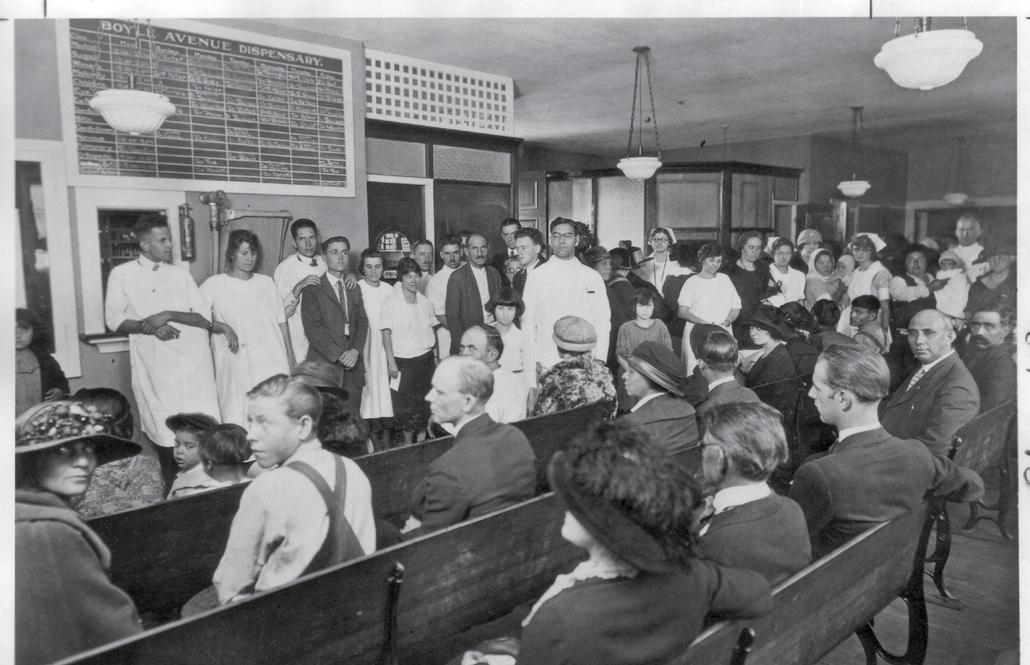
corresponding relative to the Ellen G. White Memorial Hospital. Here are a few extracts:
“We are much interested in the success of the work that you represent, and our prayer is that God will wonderfully bless in the advancement of the message through that department work.”
“We feel in our hearts that if any institution in our denomination needs the support of the body it is the Loma Linda institution. It seems that the greatest need of our work today is medical evangelists, dedicated for the work of the Lord, who
will love and practise [sic] the principles of truth taught in the spirit of prophecy. So we wish to do all in our power to help establish this institution, for we believe it is ordained of God to be one of the principal factors in establishing the truth in foreign lands as well as in this.”
We feel sure that all are interested and anxious to help. 3
On April 21, 1918, the White Memorial Hospital was dedicated with a crowd of 2,500 present. Even though a small earthquake shook
“We are much interested in the success of the work that you represent, and our prayer is that God will wonderfully bless in the advancement of the message through that department work.”
the ground during the ceremony, this did not affect the celebration of God’s goodness and the commitment of the membership in making this hospital a reality.
A note later in the year reported, “We are told by those in charge of the work at Los Angeles that the patronage at the various departments of the unit are far in excess of their fondest anticipations. It is an interesting sight to go into the dispensary in the afternoon and see 40, 50 or even 60 people lined up, awaiting their turn to receive medical attention, and while this is given, to hear the words of hope and cheer, the words of eternal life spoken to them by those who minister to their physical needs.” 4
In 1920 the medical students helped construct a nurses’ dormitory and even started their own cafeteria, which made enough money to purchase sterilizers for the surgical department. By 1937 a whole new building was needed. A 180-bed, fivestory concrete and steel structure was constructed at a cost of $330,000 and was the first earthquakeresistant hospital in California.
1Arthur W. Spalding, Christ’s Last Legion (Washington, DC: Review and Herald Pub. Assn.), p. 160, quoting P.T. Magan in Medical Evangelist, Feb. 15, 1940.
2Spalding, p. 160.
3Mary C. McReynolds, “United We Stand,” Atlantic Union Gleaner (Oct. 11, 1916), p. 1.
4J.W. Christian, “From the Field: White Memorial Hospital,” Pacific Union Recorder (Sept. 19, 1918), p. 1.
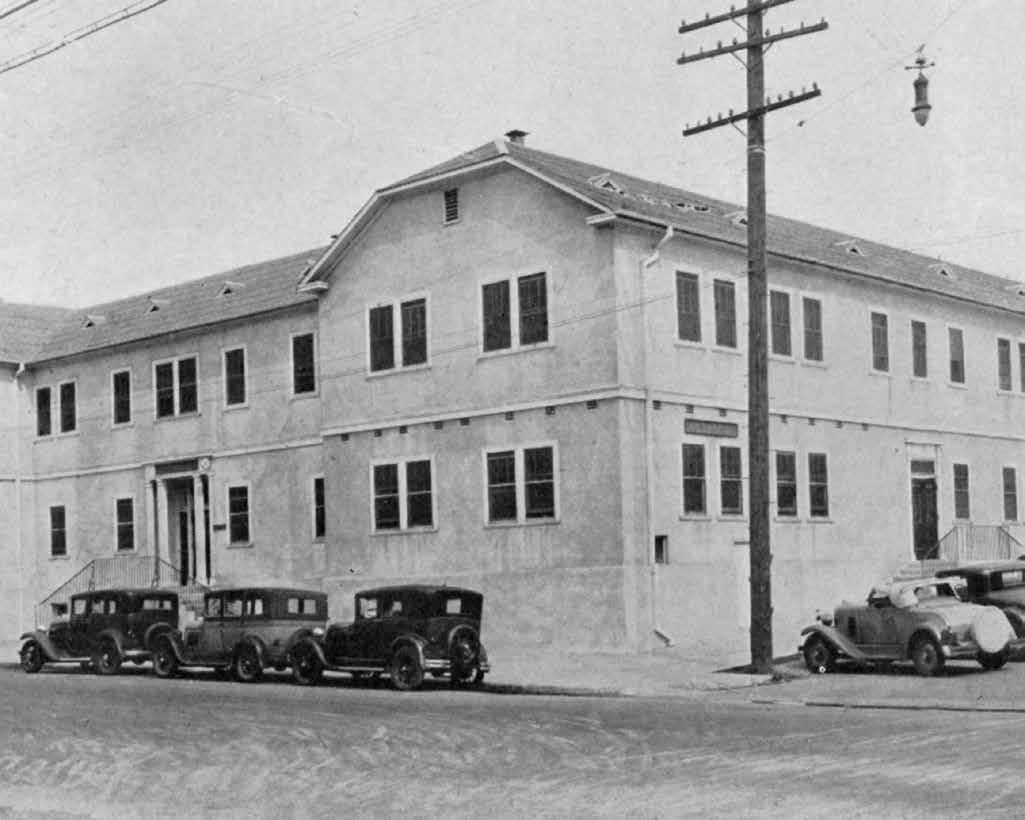
For college freshman like Joli Weber, Pricila Hernandez, and Rachel Molander, their educational experience is preparing them for a career of shaping future generations—and the Pacific Union is helping them out.
Every year since 2015, the Pacific Union provides four-year scholarships to five high school seniors pursuing degrees in education at an Adventist university. Scholarship winners receive $6,000 to $9,000 towards their tuition over the course of their education. The scholarships vary in amount depending on whether students choose to study at Adventist institutions within the Pacific Union.
Each spring, scholarship winners are chosen by the local conferences, and staff from the Pacific Union Department of Education make it a priority to attend the students’ graduations or awards events in order to present the scholarship certificates.
“It’s imperative to invest in our young educators,” said Berit von Pohle, director of education for the Pacific Union. “Twenty percent of our education workforce in the Pacific Union is over the age of 60. That equates to about 200 positions.”
The Pacific Union is serious about supporting future educators—especially those whose passion for making a difference is reflected in their vision for their future. According to Von Pohle, this is why the scholarship applicants write an essay that answers questions such as, “Why do you want to be a teacher?”
The winning candidates shared a common theme. “Every winner identified the impact they wish to make on children,” Von Pohle said. When presenting the scholarships, Von Pohle challenges the future educators to remember that being a teacher is about making a difference in
a young person’s life. The end goal? Seeing their students go on to make a difference in the lives of others.
The up-and-coming educators chosen for these scholarships are excited to take their place in the teaching field and speak enthusiastically about their future roles as teachers. The reasons for choosing a career in education varied for each but surround the common theme of making a difference in young peoples’ lives.
“God placed this dream since I was a little girl,” said Hernandez. “I had seen the love and passion my teachers had, and it inspired me to want to have an impact on students as well.”
Molander narrowed in on education because of her love for working with children. “Throughout high school, I tutored a number of elementary students, and I enjoyed it,” she said. But Molander had another reason as well. “I have experienced the struggles of learning, and I hope to be there for students who are struggling.”
For Weber, it was an Intro to Teaching class that gave her the inside look she needed to know that education was the right fit. “Up until this point, I have always been the student. Being able to see that other side and to experience some of that has solidified my desire to become a teacher,” she said.
The Pacific Union’s financial support helps students to pursue their dreams, and according to these students, there are positive ripple effects. Weber and her three younger siblings all attend Adventist schools, and they have since kindergarten. “This scholarship allows that door to becoming a teacher to be opened and also allows my parents to keep sending my siblings to Miramonte and Mountain View Academy,” she said.
In their essays, students shared their sources of inspiration to become educators. For Weber,
By Faith Hoyt
that inspiration comes from a specific Teacher.
“By being an Adventist educator, I am doing the Lord’s work through His example: teaching,” Weber said. “I see Jesus in the teachers who are mentoring me, in helpers that are in classrooms, and in the job itself.”
Molander also sees Jesus in her education professors and mentors who show students’ God’s love in the classroom. “One of my goals as a teacher is to show Jesus’ example to my students and display His character,” she said.
Now almost a full year into their programs, these students are closer to realizing their dreams. They have a vision for their future and are dedicated to preparing for a lifetime of serving others. Students like Hernandez, Weber, and Molander are the future of Adventist education, and their church is excited to support them on their journey. n
Faith Hoyt was an intern for the communication and community engagement department of the Pacific Union Conference when she wrote this piece.
2018-19 scholarship recipients (above) Joli Weber, (middle) Pricila Hernández (bottom) Rachel Molander.

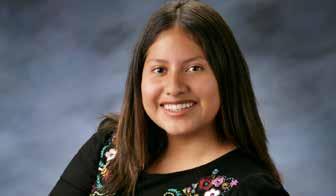

“For this reason, ever since I heard about your faith in the Lord Jesus and your love for all God’s people, I have not stopped giving thanks for you, remembering you in my prayers.I keep asking that the God of our Lord Jesus Christ, the glorious Father, may give you the Spirit of wisdom and revelation, so that you may know him better. I pray that the eyes of your heart may be enlightened in order that you may know the hope to which he has called you, the riches of his glorious inheritance in his holy people, and his incomparably great power for us who believe.” —Ephesians 1:15-19, NIV
The Pacific Union Conference Office of Education coordinates a cohesive system of schools in the seven conferences in the states of Arizona, California, Hawaii, Nevada, and Utah. This system is comprised of 32 early childhood education centers, 102 elementary schools that serve grades K-8, and 37 junior and senior academies that serve grades 9-12. Within this system, La Sierra University and Pacific Union College are institutions of higher learning offering college and advanced degrees. Loma Linda University, an institution of the General Conference, is located in the Southeastern California Conference territory.
Legend
n Preschool
n Elementary
n Junior Academy
n Senior Academy
n College/University

Journey to Excellence Seventh-day Adventist Schools in the Pacific Union Conference


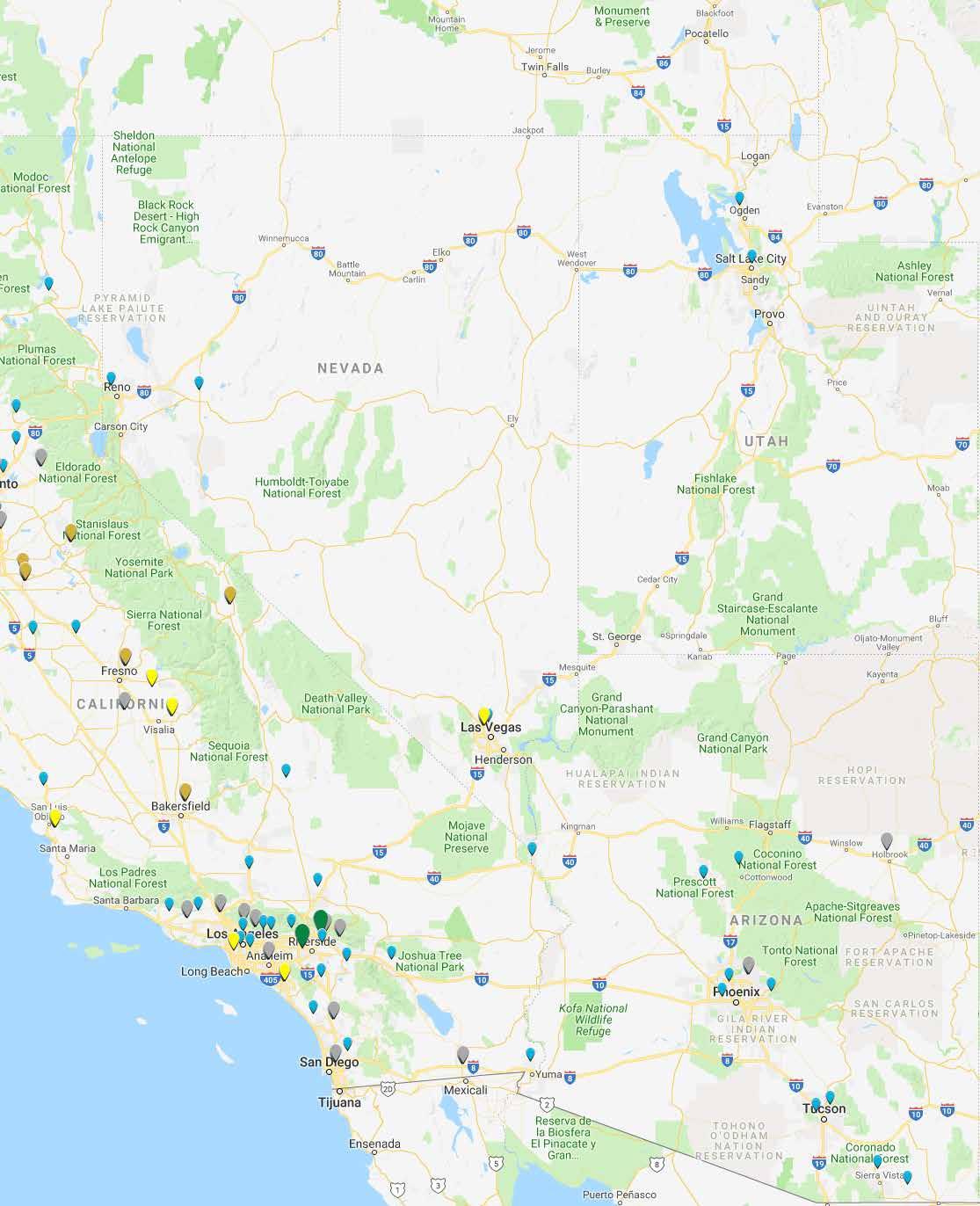

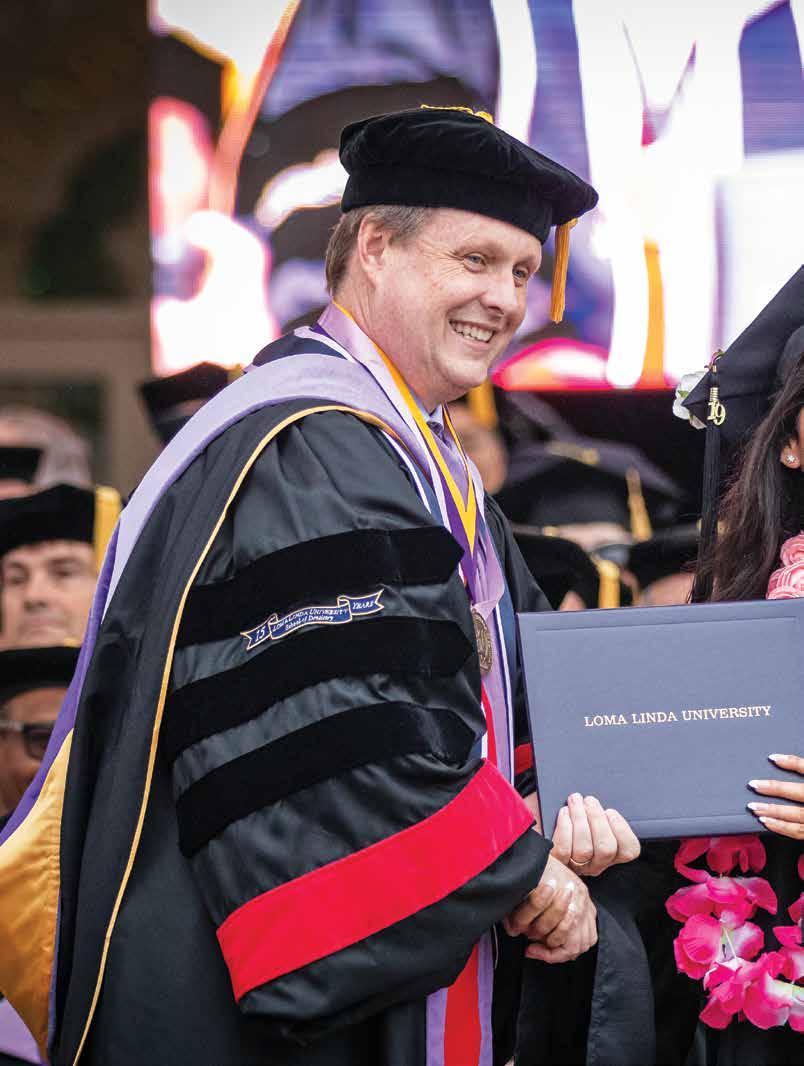
Pull Quote


Loma Linda University Health is the Seventh-day Adventist Church’s flagship academic health sciences center, which has sent out thousands of medical missionaries since its founding in 1905 and helped to establish the denomination’s outreach and structure in many parts of the world. Many modern and influential Adventist hospitals worldwide were first established as a humble clinic by a Loma Linda University medical graduate who had gone on to serve as a missionary.
Today, Loma Linda University Health is one of Southern California’s most respected healthcare organizations and one of the leading faithbased academic medical centers in the United States. We operate six hospitals, a physician practice corporation, and affiliate organizations internationally. These medical services interact with eight schools in our healthcare-focused university. This close relationship results in outstanding patient care and education. Loma Linda University Health’s 17,000 employees and 4,500 students are committed to physical, intellectual, emotional, and spiritual wellness.
Loma Linda University Health has been instrumental over the years in sending the Seventhday Adventist Church’s message of healthful living to the world. While Adventists were once viewed as

peculiar people for not smoking, eating meat, or drinking alcohol, modern times have validated the benefits of healthy living. The city of Loma Linda was recognized as one of the five original Blue Zones known for longevity—the only one in North America. Our ongoing study of 96,000 church members at our School of Public Health has received several rounds of funding from the National Institutes of Health and is regularly quoted in journal articles and top-tier news outlets around the globe.
Loma Linda, Spanish for “beautiful hill,” was founded by the Adventist Church in 1905 after leaders purchased a hotel and turned it into a sanitarium. Early church leaders took a great risk, founded on faith, to make the purchase with private funds.
In her dedicatory address of the Loma Linda Sanitarium in 1906, Ellen White said the institution
was to make a major contribution to the work of the Adventist Church by becoming a training center for students who would participate in the denomination’s worldwide outreach. Now, more than a century later, the organization’s legacy and current work around the world validate her challenge every day in remarkable ways.
Loma Linda University School of Medicine has the largest global footprint of any medical school in the United States. It has also served as a key consultant to the development of the denomination’s six other medical schools, as well as those now in development.
The Adventist Church operates more than 70 nursing schools globally, and Loma Linda University School of Nursing—the university’s first school—has left a legacy in many of those countries through nursing education and improved nursing practices.
Today, graduates from many of Loma Linda
University’s eight schools serve as missionaries and consultants through Adventist Health International and support projects through Adventist Health Ministries and the Adventist Development and Relief Agency.
From 2015-2019, nearly 4,500 faculty, students, and staff embarked on mission trips to serve those in need. Together with Adventist Health International, Loma Linda University Health is now working directly with more than 40 Adventist mission hospitals and 80 clinics worldwide.
In 2016, we opened a nearby outreach center with the launch of our San Bernardino campus, which includes a health clinic for low-income residents and the San Manuel Gateway College. The college offers certificate training programs to high school graduates of this underserved region, allowing them access to entry-level healthcare jobs and future opportunities for career growth. The entire San Bernardino campus is a unique model, with physicians, medical residents, medical students, and San Manuel Gateway College students all serving patients together.
Our main campus has undergone one of the largest transformations in the organization’s history. Through the Vision 2020 campaign, we have constructed a new adult hospital and a new Children’s Hospital tower, replacing much of the acute-care areas to meet new 2020 California seismic standards. The new hospital facilities is a place where 4,500 students and 700 residents progress in their education. Many of those students will become long-term members of the Loma Linda University Health team, while others will take what they have learned here to communities across the globe. The campaign also includes funds for research, scholarships, and wholeness initiatives,
building on our rich history of whole-person care. The campaign’s philanthropic goal of $366 million, combined with other moneys for a total of $1.2 billion, was the largest philanthropic campaign ever achieved by an Adventist Church entity.
In all we do as a global Christian denomination, together, by God’s grace, we will continue to share the teaching and healing ministry of Jesus Christ, just as we have for more than a century.
Visit us on our beautiful Southern California campus or online at lluh.org.
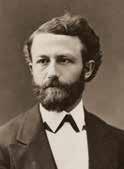
In 1869, Sidney Brownsberger enrolled in the University of Michigan to pursue a classical degree. While a student at Ann Arbor, he first heard of Seventh-day Adventists. He sent for all the literature printed by the church at the time. Agreeing with what he read, Sidney began keeping the Sabbath alone during his junior year in college. When plans began to develop for an Adventist college, the organizers turned to Sidney. He helped to develop Battle Creek College (now Andrews University) and later Healdsburg College (now Pacific Union College). He would later observe that Ellen White's educational principles were so far advanced that no one understood how to implement them.
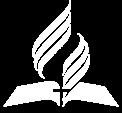
By Ray Tetz

In 1847, Samuel Rhodes—a deeply committed believer in the teachings of William Miller, the Baptist preacher whose interpretation of biblical prophecy sparked the Advent movement—hit rock bottom. Penniless after investing all his financial resources in the movement, his spirit broken by the verbal abuse heaped on him by many of his former friends, and believing that God had forsaken him, Rhodes, like Elijah, fled to a secluded place. For three years he hid himself amidst the wilderness of the Adirondacks of northern New York. Miles from anyone, he lived the life of a hermit. But Samuel Rhodes had a friend in a man named Hiram Edson.
Edson had been instrumental in helping the Millerite believers make some sense of what had—and had not— happened on October 22, 1844, when Jesus did not return as they had hoped, believed, and taught. Knowing that it was their shared experience and struggle that had left Rhodes broken and discouraged, Edson went looking for Samuel Rhodes. Three times Edson ventured into the wilds to try to find Rhodes and persuade him to return to the fellowship of the Advent believers. Three time he failed to find him, but he was undaunted in his quest.
Knowing that it was their shared experience and struggle that had left Rhodes broken and discouraged, Edson went looking for Samuel Rhodes.
And then, one fateful night, Edson dreamed of entering a room in which six discouraged people were praying, and one of them said to him, “Oh! Brother Edson, I am in the dark!”1

His thoughts went to Samuel Rhodes.
At a meeting just eight days after his dream, when fellow Millerite Richard Ralph mentioned the challenges of trying to find Rhodes, Edson suddenly felt that perhaps his dream was a calling.
He sought Ellen White’s advice, and she expressed skepticism about trying to find a man who did not want to be found. But during a subsequent prayer session seeking God’s guidance, Edson reported that the Holy Spirit “settled upon us so that the place was awful and glorious.” 2 This is where this story takes an unexpected turn.
During the meeting, Richard Ralph began speaking in an unknown tongue. Providing the interpretation for those kneeling in prayer, he said that God wanted Edson and him to search for Rhodes.
The following morning, after receiving a vision affirming this perception, Mrs. White granted her approval for the mission to go find Samuel Rhodes and bring him back to the little flock, instructing them to tell Rhodes that God loved him, that there was “hope and mercy for him,”3 and that angels would protect him if he returned with Edson and Ralph.
Off they went. And then, after journeying 14 miles into the forest, they found Rhodes, looking every bit the hermit.
Rhodes responded to their arrival and entreaties to return by telling them of a dream that he himself had experienced—a dream of two men who were seeking him. Brothers Edson and Ralph shared the message they had received from Ellen White, and Richard Ralph was again moved to speak in an unknown tongue—behavior that Rhodes took as a sign of God’s love and approval.
And with that, Samuel Rhodes came home. The cloud of despondency under which he had lived since 1844 cleared, and Edson recorded the reaction of the little flock in a letter sent to Present Truth: “They were all rejoiced to see Bro. Rhodes. Tears of joy and tenderness flowed freely as they greeted each other. We had a sweet, heavenly sitting together during the meeting, and Bro. Rhodes’ faith and hope are fast increasing. He stands firm in all the present truth; and we heartily bid him God speed, as he goes to search out and feed the precious, scattered flock of Jesus.”4
This story is included in Brian Strayer’s’ 2023 biography of Hiram Edson (available on Amazon from Oak & Acorn Publishing). I am inspired by the way our spiritual forebears muddled along through their theological discoveries and personal faith. I am inspired by their zeal and determination fueled by the hard-won convictions born from dedicated exploration of the Scriptures, thoughtful questions and discussion, and heartfelt devotion. How heartening it must have been to hear Ellen White’s assurance that there was “hope and mercy” for them. These are surely words
that would be as powerful as that other assuring statement from her that has become so familiar to us: “We have nothing to fear for the future, except as we shall forget the way the Lord has led us, and his teaching in our past history” (Ellen G. White, Testimonies for the Church , vol. 9, p. 10).
But Professor Strayer’s book wasn’t published generations ago and wasn’t included in reading lists or available in Adventist libraries—nor have any biographies of Hiram Edson been published until now to feed the precious, scattered flock of Jesus.
Which brings me to the question of fundamentalism.
In a TEDTalk in 2009, Nigerian author Chimamanda Adichie spoke passionately and persuasively about “The Danger of the Single Story.” In it she cautioned against the simplified narratives that avoid troubling complexity and suppress inconvenient details. “The single story creates stereotypes,” asserted Adichie, “and the problem with stereotypes is not that they aren’t true, but they are incomplete. They make one story become the only story.” 5
The rise of the single story is the roadway to fundamentalism. Both fundamentalism and the adoption of a single narrative are reductionist. Complex events and ideas are oversimplified. Alternative viewpoints are suppressed. Inquiry is discouraged. Stereotypes flourish. Assumptions remain unchallenged.
One hundred and seventy-two years ago this summer, just four years after the epic rescue of Samuel Rhodes, James White responded in the pages of the Advent Review and Sabbath Herald to a letter from a group of Seventh Day Baptists who wrote asking who Adventists were. His words embraced a wide horizon—a generous orthodoxy of fellowship and inquiry.
holding different views on some subjects; yet, thank Heaven, the Sabbath is a mighty platform on which we can all stand united. And while standing here, with the aid of no other creed than the Word of God, and bound together by the bonds of love— love for the truth, love for each other, and love for a perishing world —“which is stronger than death,” all party feelings are lost.” 6
These are powerful words that stand in stark contrast to the narrowed vision of a single story or fundamentalism.
In the spirit of Hiram Edson, Richard Ralph, James White, and Ellen White, let us set about to rescue Samuel Rhodes—who shall not be forgotten. We will need to journey out beyond the borders of our settled history into the wild forests and reclaim that which once was lost. We will need the brightest lights to push back the darkness, not a dimmed and dumbed down low-voltage glow incapable of being focused to illuminate or start a fire. Our faces should shine with the vitality and confidence of stories and scholarship and provocative preaching, burning brightly.
Ray Tetz is the director of communication and community engagement for the Pacific Union Conference and the publisher of the Pacific Union Recorder
1Hiram Edson, Nov. 26, 1849, Letter to Present Truth (Dec. 1849), p. 36. The quotes and footnotes from the Samuel Rhodes story are sourc ed from Brian E. Strayer, Hiram Edson: The Man and the Myth (Thousand Oaks, CA: Oak & Acorn Publishing, 2023), pp. 104-109.
2D.E. Robinson, “The Gift of Tongues in Early Advent History,” ( Center for Adventist Research, James White Library, Andrews University, Be rrien Springs MI, n.d.), p. 2.
3Ellen White, “Beloved Brethren, scattered abroad,” Present Truth , Dec. 1849, p. 35.
4Edson, Letter to Present Truth
As a people we are brought together from divisions of the Advent body [the Millerites], and from the various denominations,
5Chimamanda Ngozi Adichie, “The Danger of a Single Story,” TEDGlobal (July 2009), https://www.ted.com/talks/chimamanda_ngozi_adichie _the_ danger_of_a_single_story.
6James White, “Reply,” Review and Herald 4, no. 7 (Aug. 11, 1853), p. 52; emphasis added.
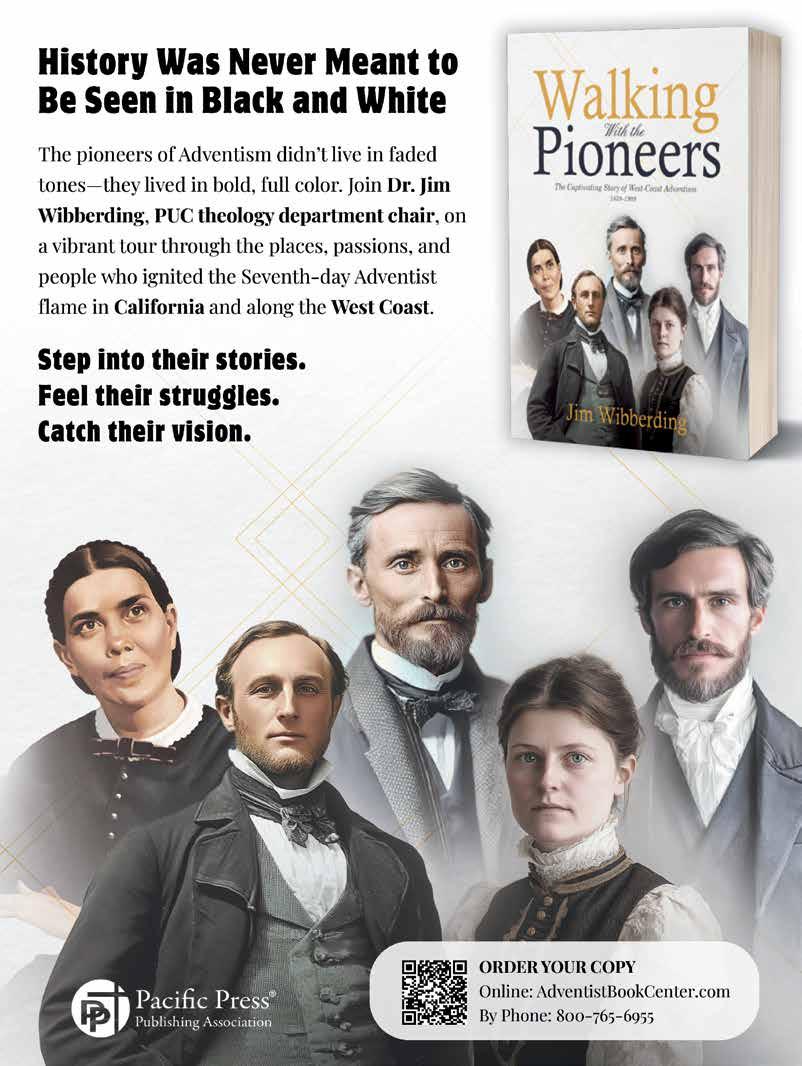
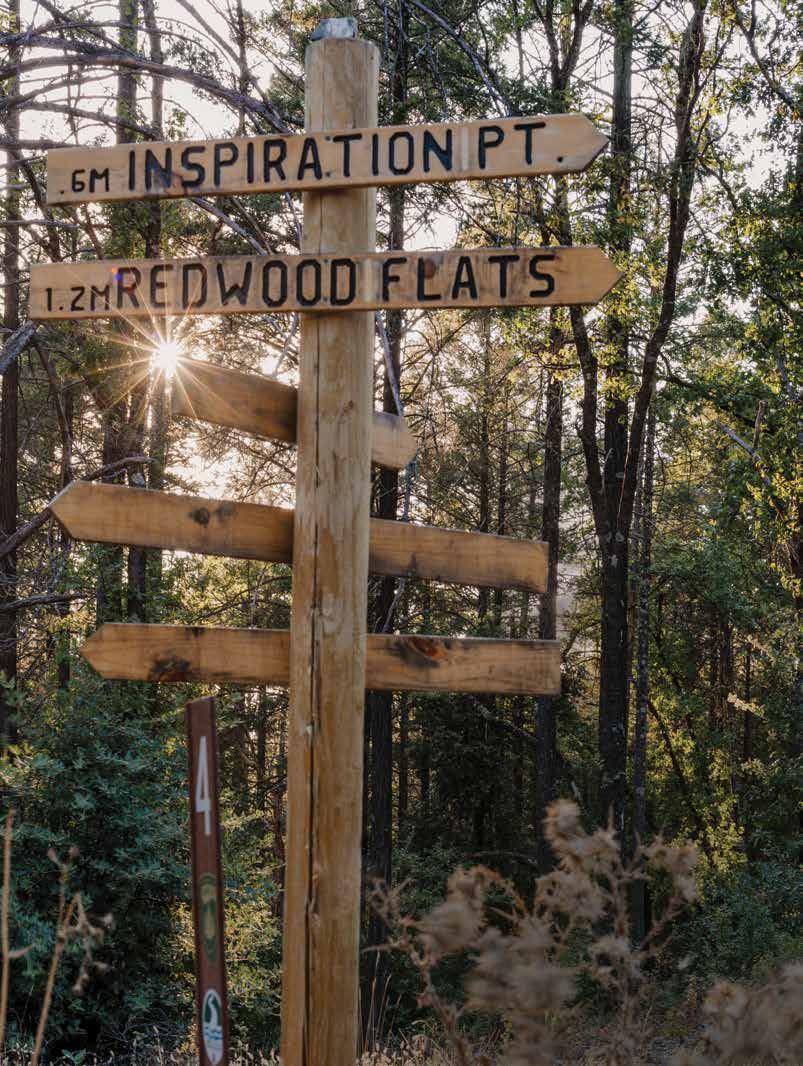
Pacific Union College’s demonstration and experimental forest, an integral part of the college’s heritage, is a 1,100acre protected preserve that is an outdoor classroom and a local destination. With 35 miles of trails winding through conifers, madrone, and some of the easternmost coastal redwoods, the forest offers endless opportunities for hands-on learning, recreation, and support for the educational mission of PUC.
puc.edu/experience admissions@puc.edu puc.edu • (800) 862-7080